
Treasures of the Aegean
May 2-11, 2024
Mike and Judy Henderson
In this installment we board the Windstar small ship and set sail for some of the Greek islands in the Aegean Sea. We will also go to Ephesus, which is in Turkey.

+++++++++++++++++++++++++++++++++++++++
May 4, 2024 (Saturday) We depart the hotel this morning on our way to board the ship. It takes time for the crew to prepare the ship for the next group of guests, so Tauck will take us to a museum to kill time until the ship is ready.
We gathered in the lobby about 7:15, for a 7:30 bus departure - and then we were off. While driving through some of Athens, our tour guide Sophia, told us about the various sites. One was the Panathenaic Stadium. The area was used in the sixth Century BC for the Panathenaic Games (hence the name of the stadium). A stadium with seating was built in the 4th Century BC but later abandoned. The present stadium was built for the 1896 Olympics.
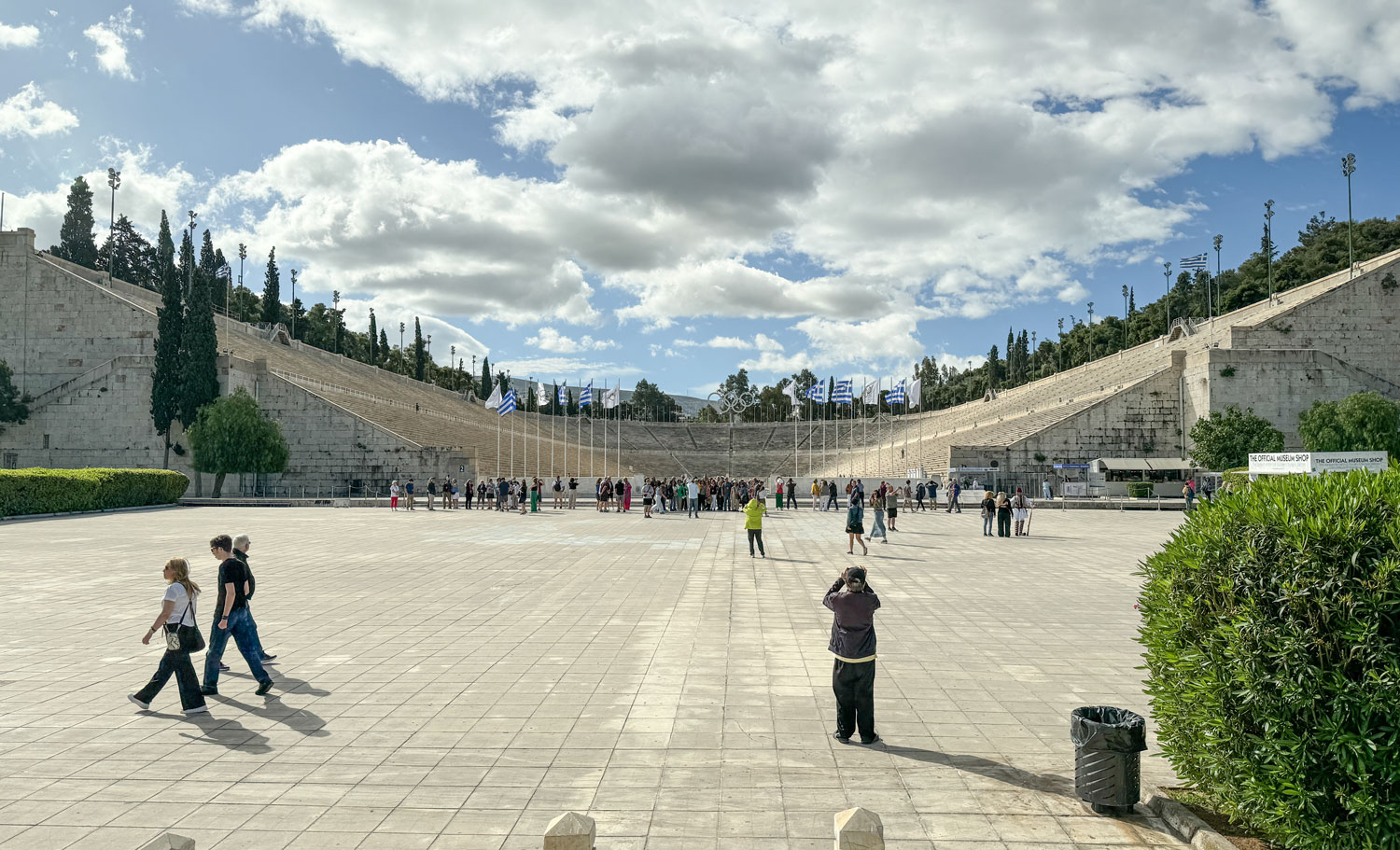
After some touring of Athens we wound up at the National Archeological Museum. Picture from Wikipedia - their picture was a lot better than mine.
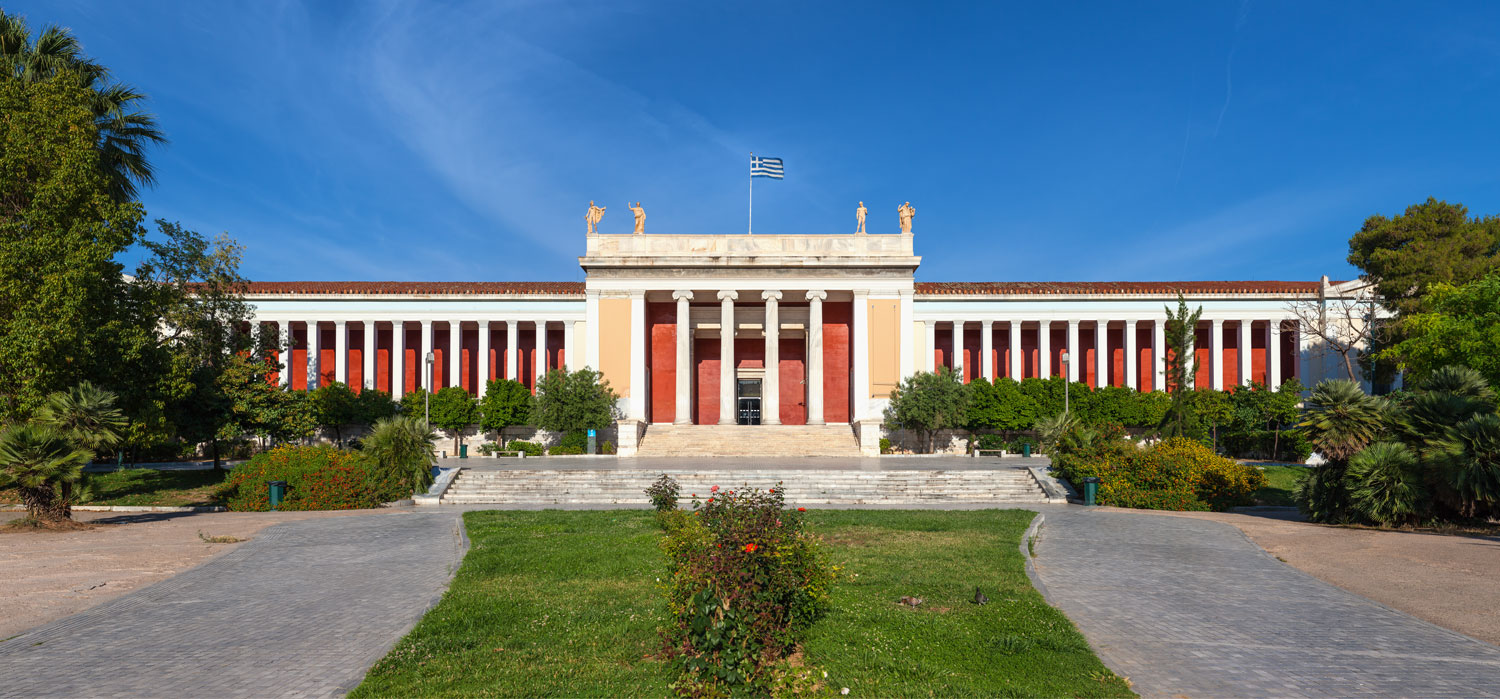
I'll include a few pictures of some of the items on display without attempting to describe them - which I couldn't really do.
Two gold masks.
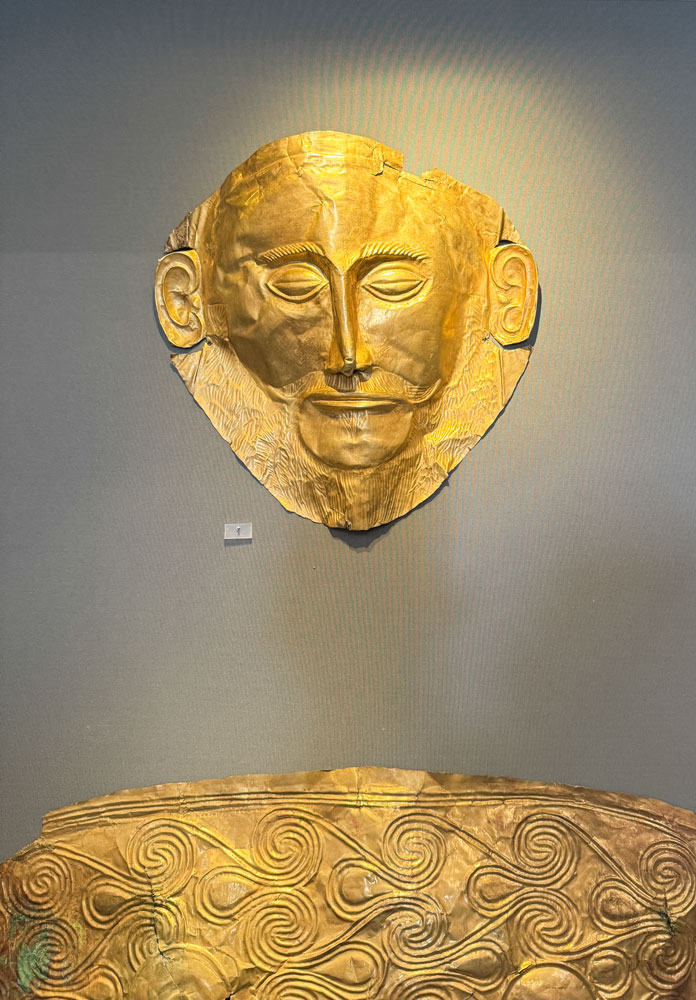
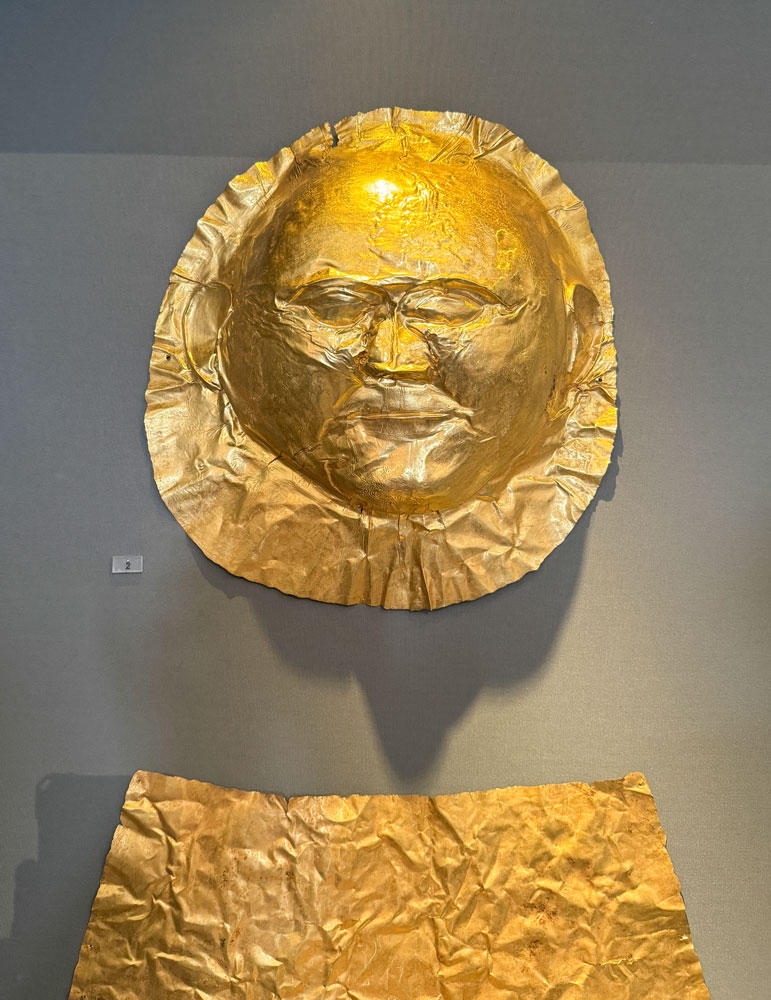
A gold necklace, with each piece very finely crafted. Since gold was so precious it's likely that only the most talented craftsmen worked with it.
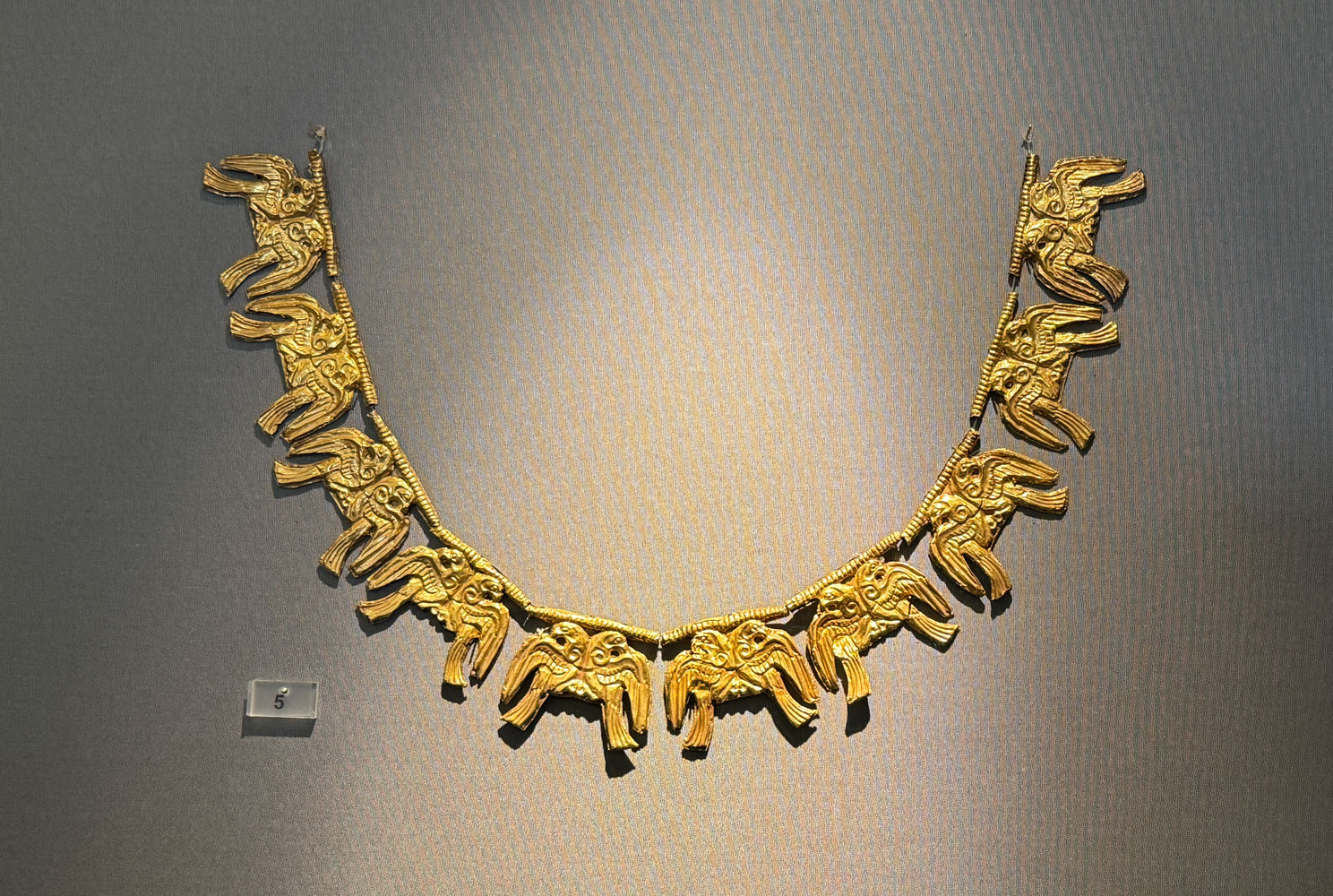
More gold jewelry.
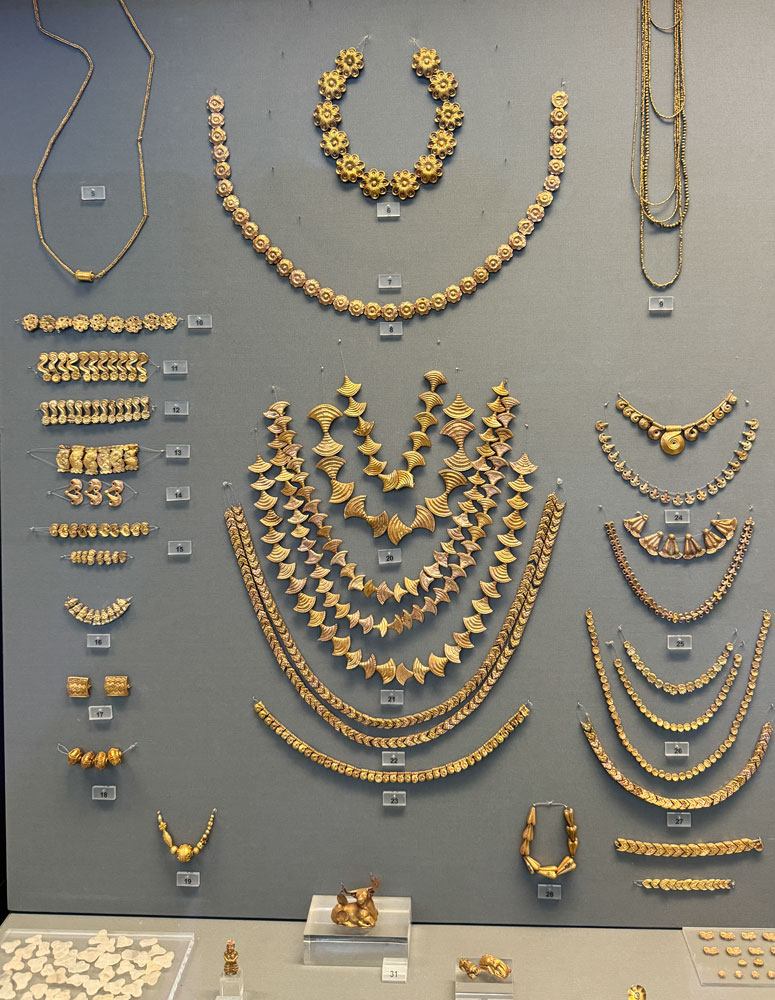
A gold cup with finely detailed figures.
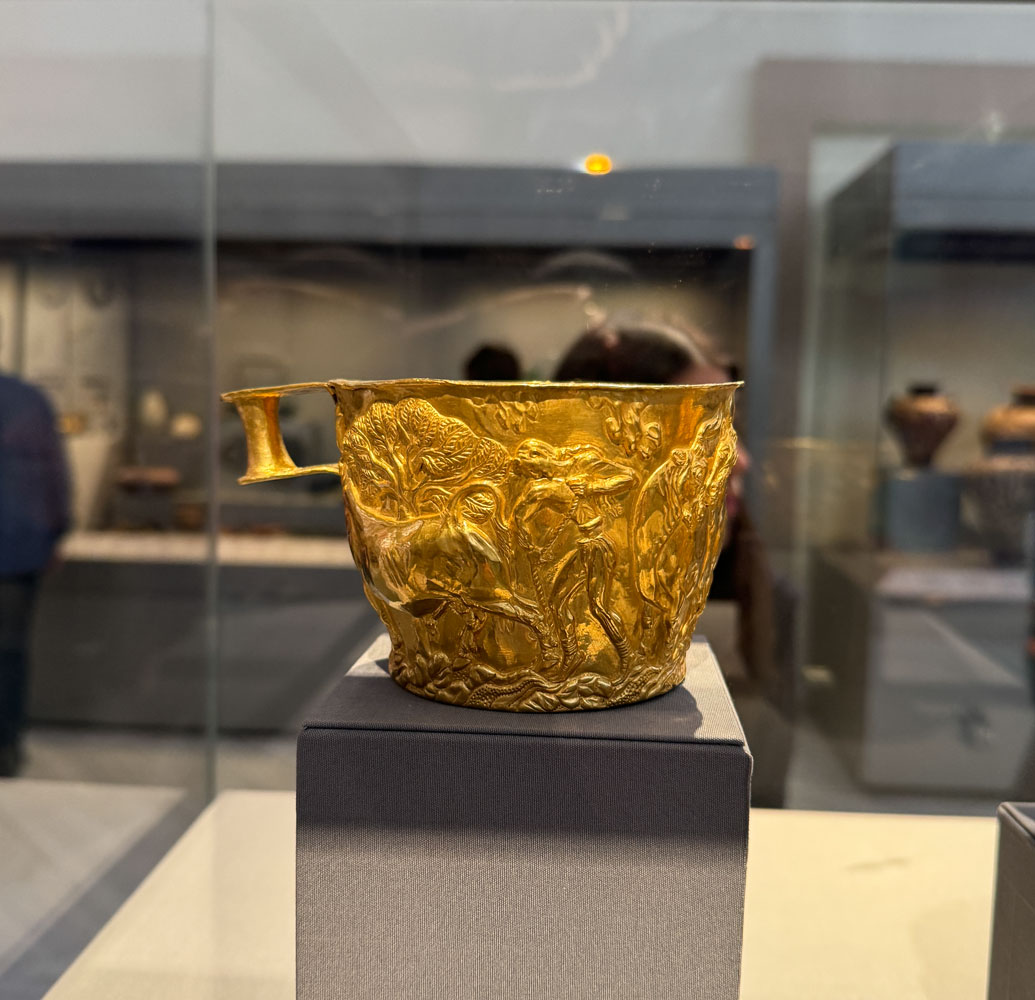
A bull's head with golden horns and rosette.

Bronze statue of Zeus, known as the Artemision Bronze. He probably held a thunderbolt in his right hand, ready to throw it.
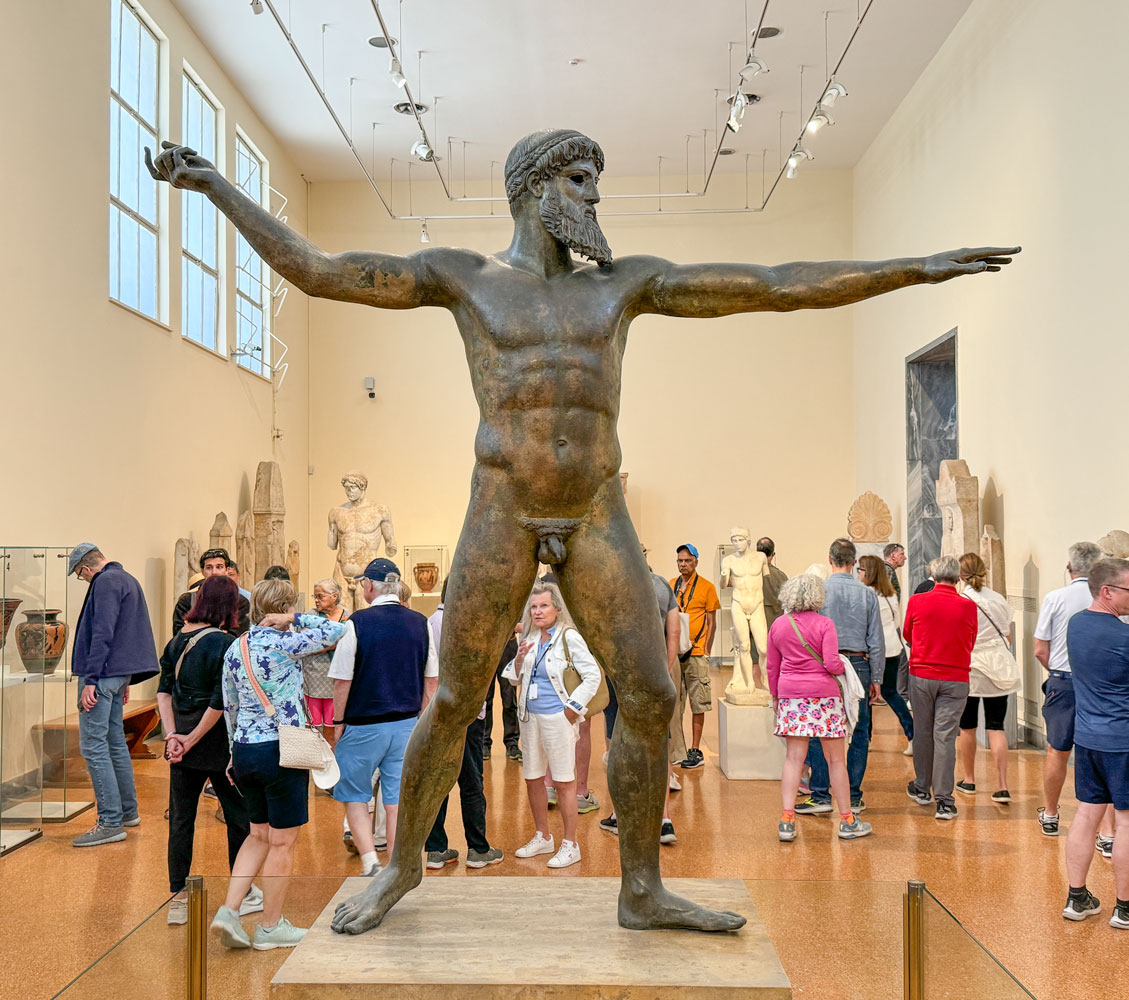
The Jockey of Artemision, another amazing bronze - so well-detailed and lifelike.
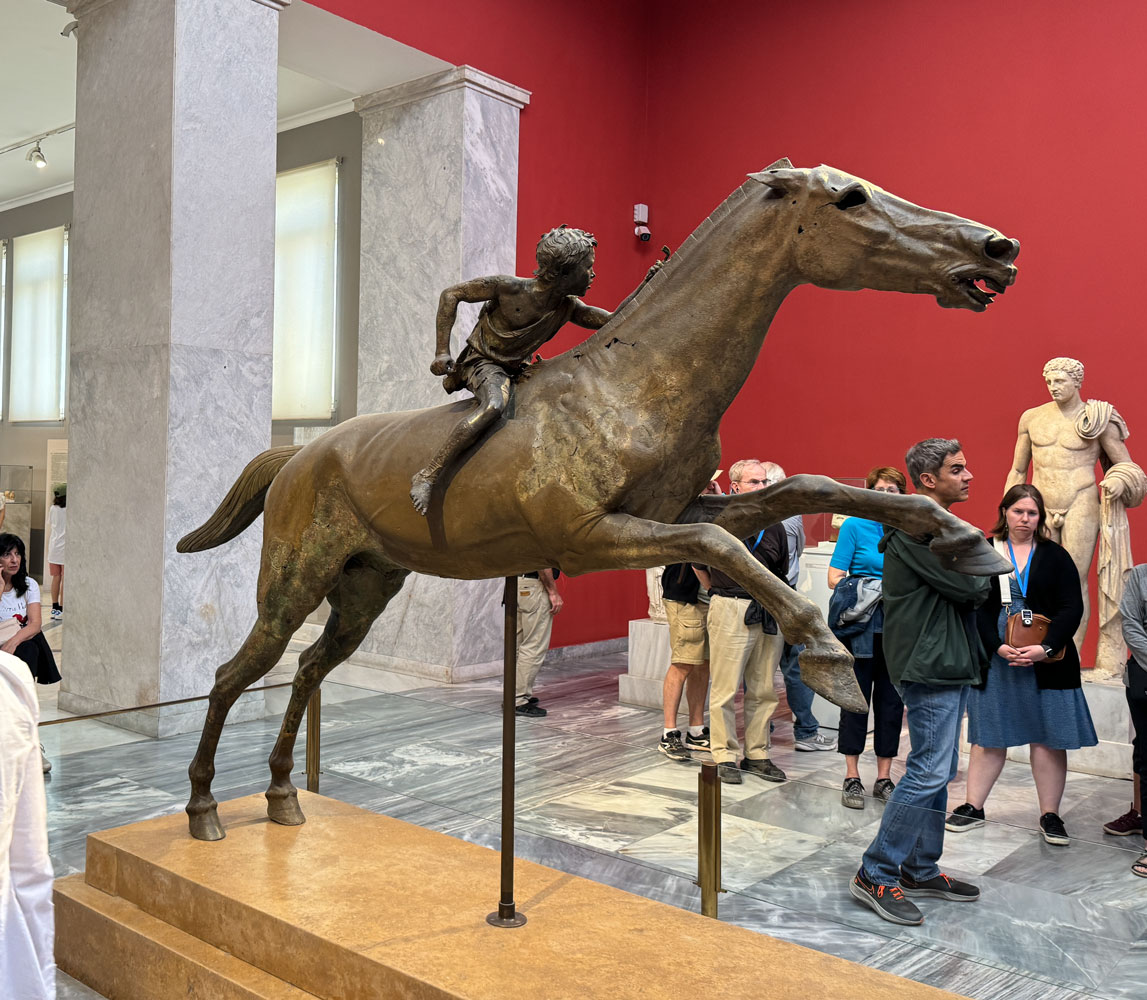
There was also a display of the famous Antikythera mechanism in the museum. Here's one of the major pieces that were recovered.

They also had a reconstruction of the mechanism, but I didn't take a picture of it. This picture is from Scientific American (the link is to a very good article in Scientific American about the mechanism but you may need a subscription to read it.)
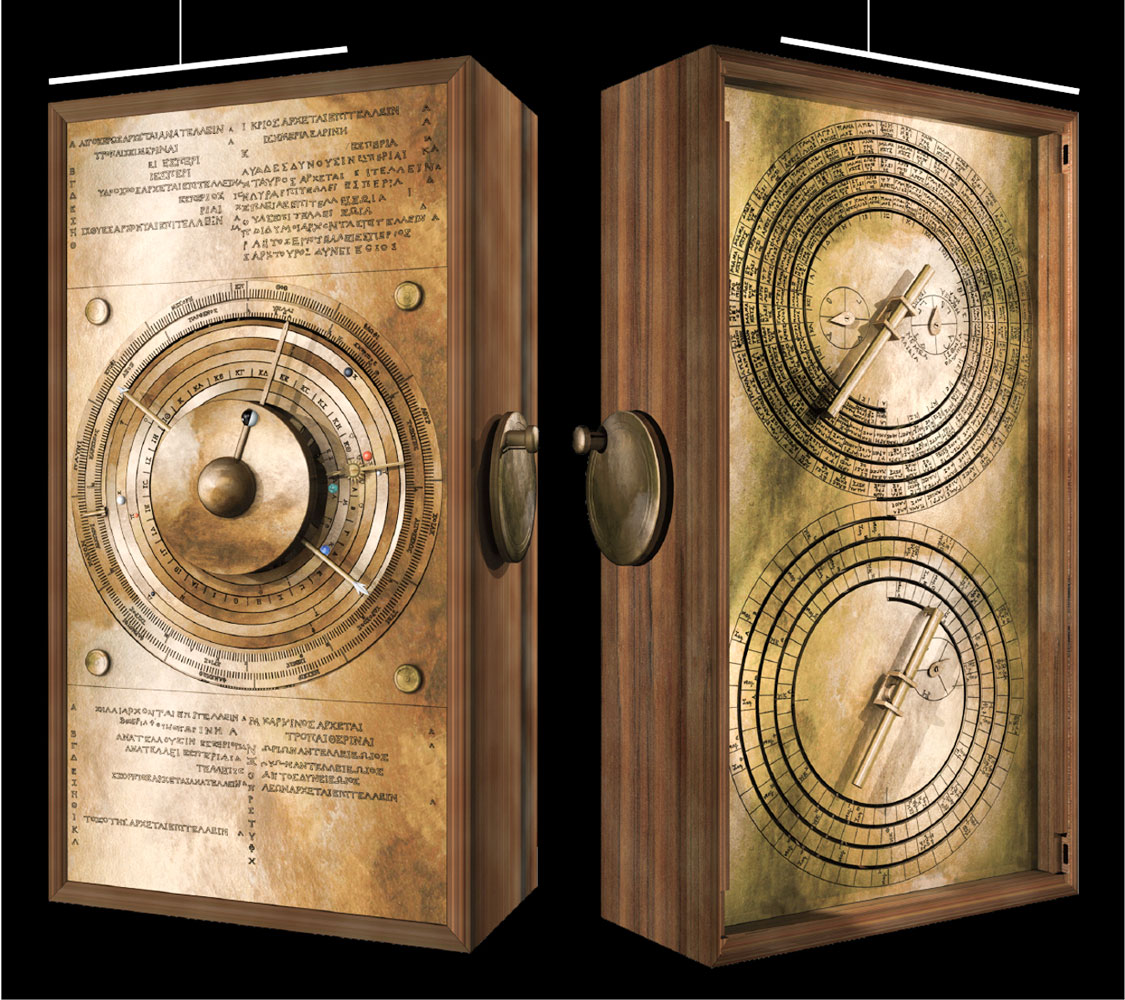
There was a lot more in the museum, especially many marble statues, but I've selected what I thought were the most striking exhibits.
Then we drove to the Piraeus cruise ship port where we'll meet the Windstar. We checked in with Windstar, submitted our passports, had our pictures taken for identification on the ship, got our cabin keys, and went through security.
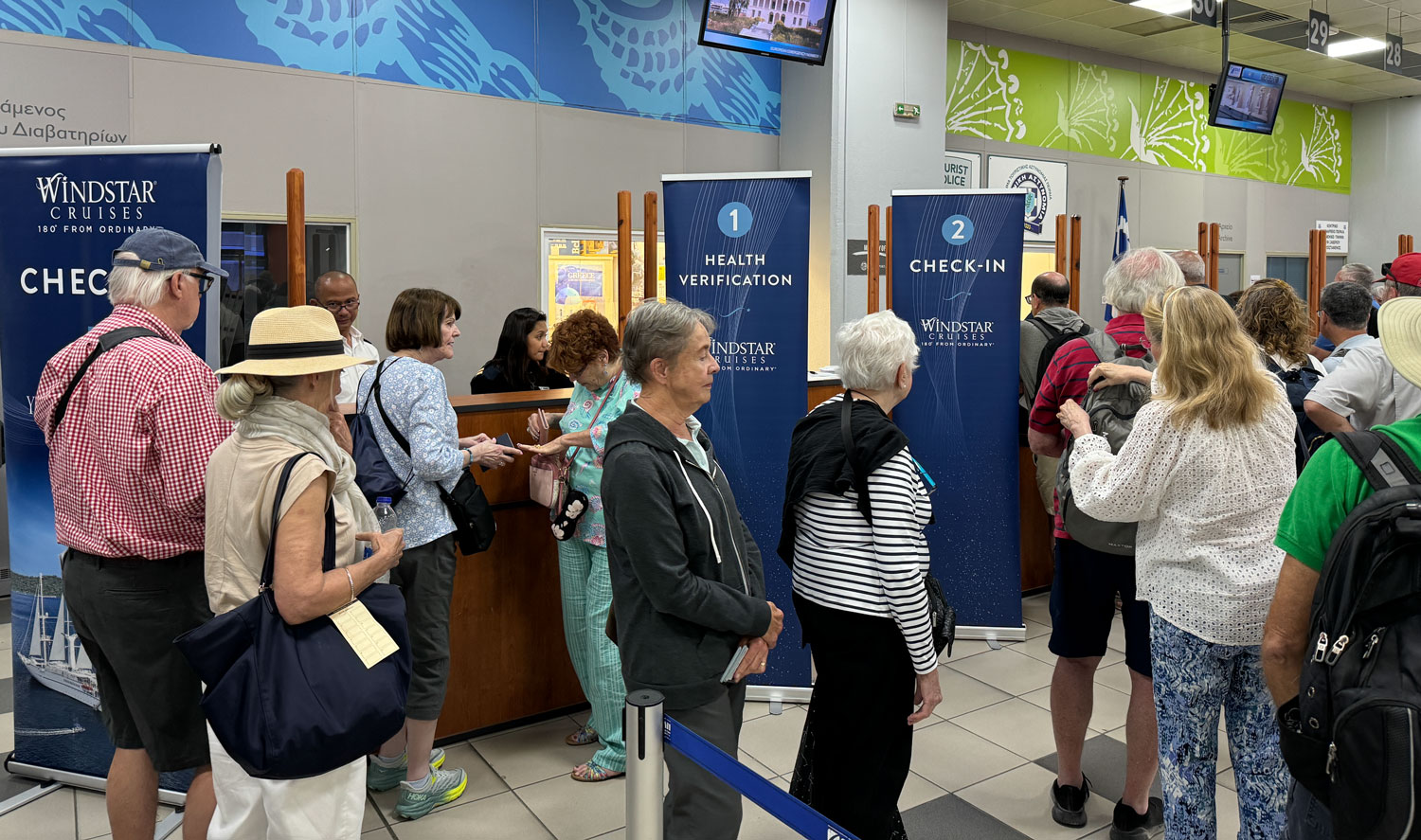
There was a bus waiting to take us to the ship. Here's the ship (photo courtesy of Charles Hood - shooting through the window on the bus). I was on the wrong side of the bus and couldn't get a picture of the ship. The ship has a maximum capacity of 148 guests. I found out later that it was not completely full, but close - maybe 130 to 140 guests.
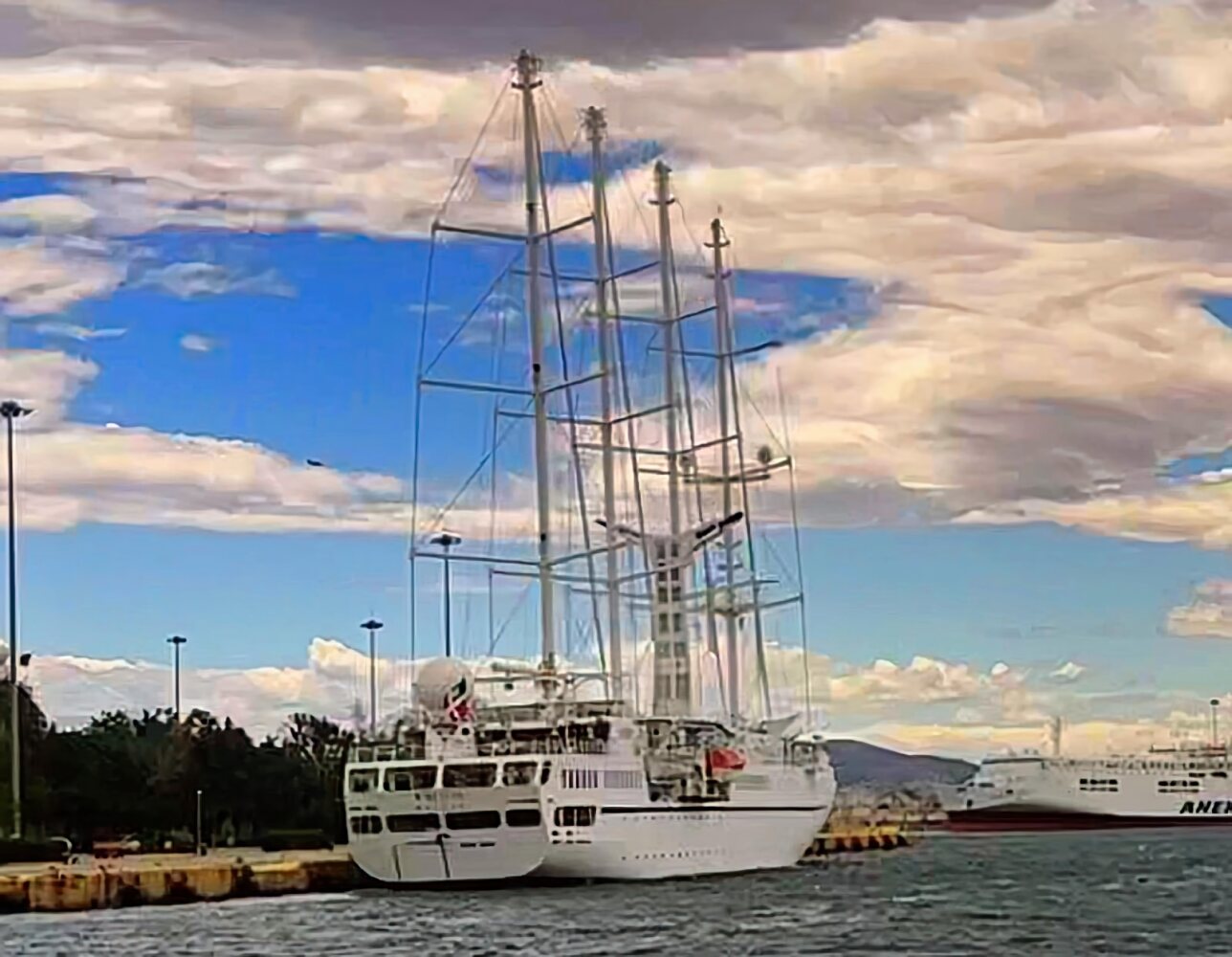
We had lunch in the Veranda restaurant, and then went to our cabin. It's very small. There's so little room between the wall and the bed that we can only put our suitcases under the bed from this side. The bathroom is also very small, a bit larger than a restroom on an airplane. Definitely only one person in the bathroom at a time.

Looking in the other direction, there's a table and two benches. The table worked well for me to work at the computer. Additionally, Windstar has Starlink Internet service which is much faster than the previous system which used a geosynchronous satellite. However, Starlink blocks iCloud and OneDrive, I suppose because those two services can send a lot of data backing up pictures and files on your computer.
The blocking of OneDrive turned out to be a significant problem for me because not everything is stored on your computer - OneDrive downloads it from the cloud when you need it. That meant I did not have access to some files that I needed. I'm going to raise that issue with Tauck.
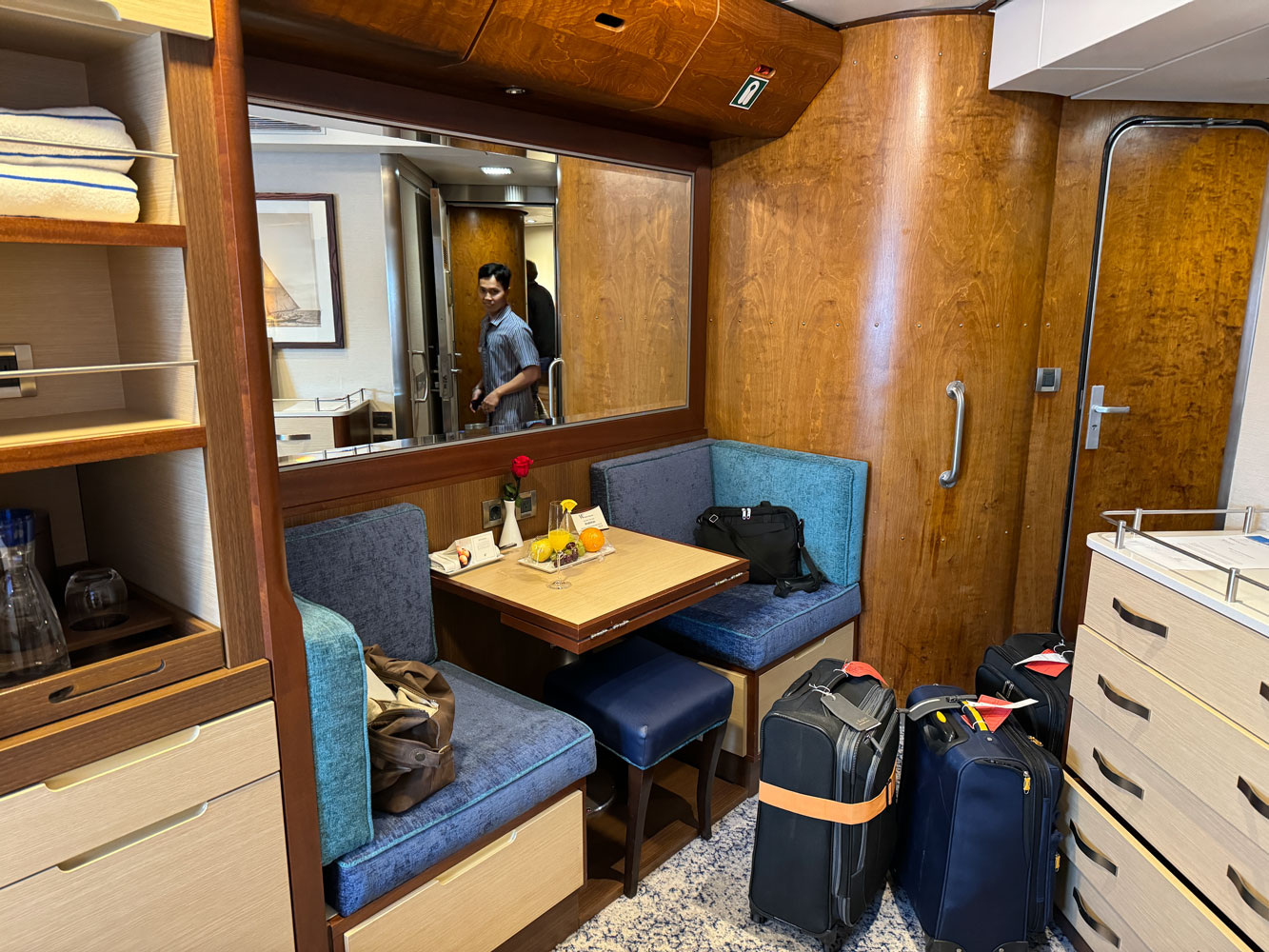
We had a couple of problems with the cabin. First, we couldn't open the door with the key cards issued to us. The reception desk issued us new cards and those worked until they didn't. We'd be standing outside the cabin, inserting our cards and getting a red light. The reception desk issued us new cards again but we continued to have problems getting the cards to work.
Then, when we left the dock, we started getting noise in the cabin, probably from the engines. Since I'm deaf when I take my hearing aids out, I wouldn't have had a problem, but Judy has normal hearing and would not be able to sleep with that noise.
She contacted Michael and he arranged for us to move to a cabin in the bow, which we found to be much quieter - and the door lock worked.
Here's our cabin attendant (at the new cabin), Raj. He's been very helpful to us. As we unpacked we found plenty of storage space, so everything fit nicely,

The ship sailed about 6pm, but there were no Sail Away festivities because it started raining about that time and no one wanted to go outside. The ship did not unfurl its sails.
Judy and I had dinner in the Amphorae Restaurant. We joined a table of four other guests (not Tauck guests) and enjoyed getting to know everyone.
That was the end of our day. The ship will sail to the island of Mykonos during the night and anchor off Mikonos Town.
+++++++++++++++++++++++++++++++++++++++++++++++
May 5, 2024 (Sunday - Cinco de Mayo and Easter Sunday in Greek Orthodox) The ship arrived off Mykonos Town and anchored.
We encountered an unusual thing when we left the cabin to go up to the main deck - there was a watertight door blocking the hallway.
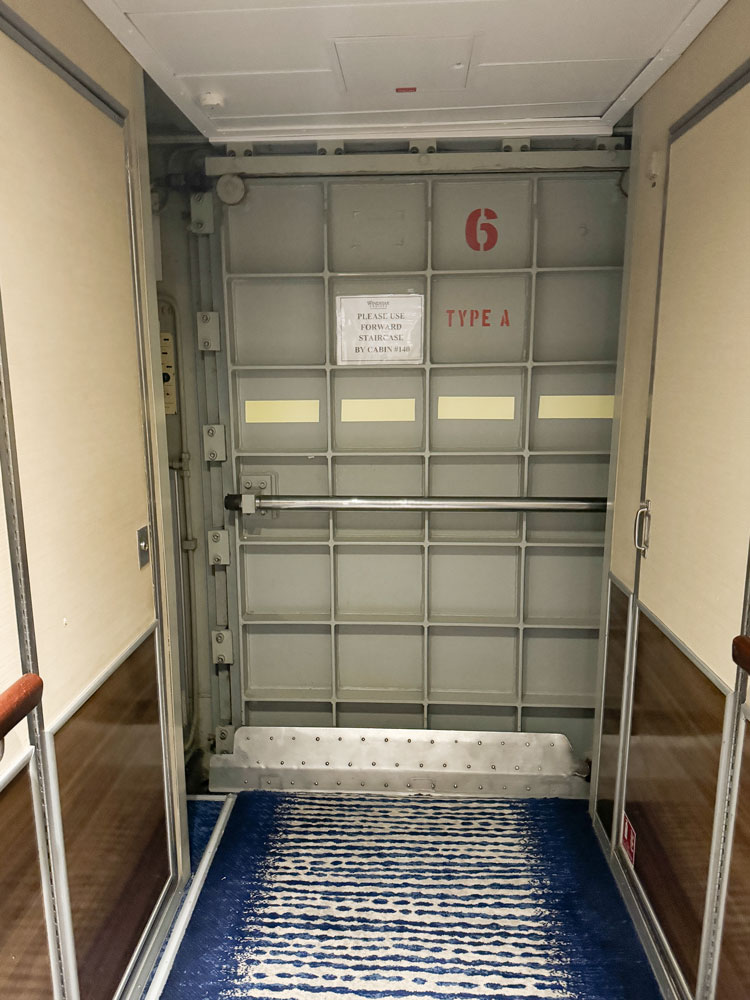
There was a sign on the watertight door and one on the door at the other end of the hall.
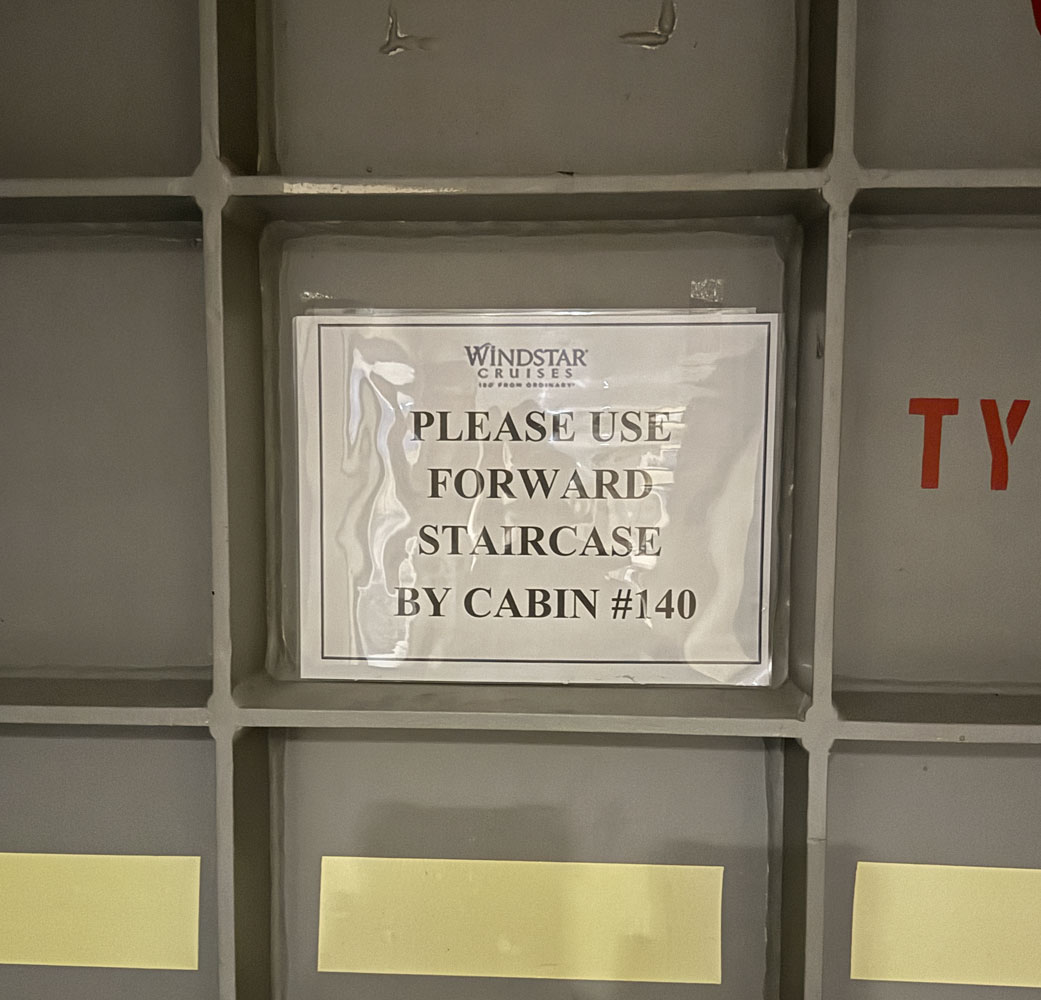
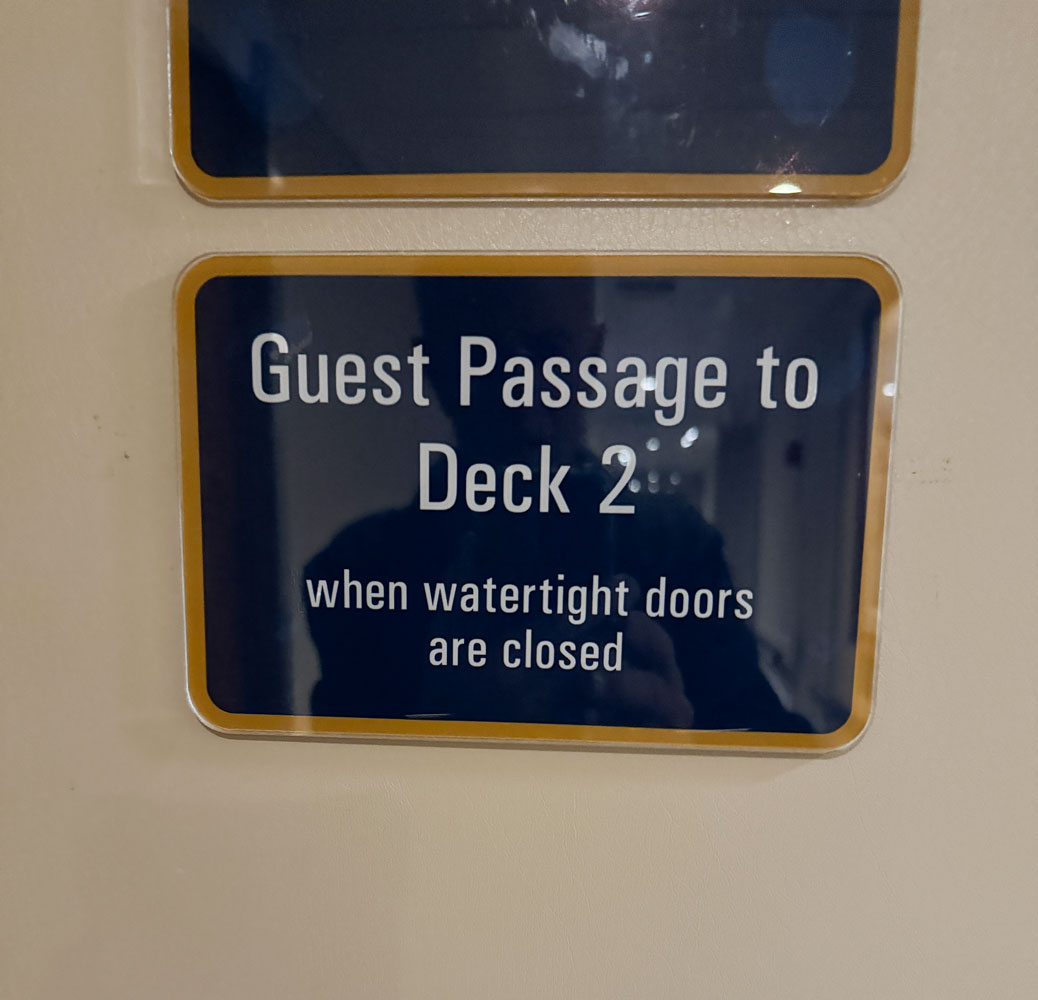
The door at the end of the hallway led to a steep set of steps in the crew area that took us to the second deck.
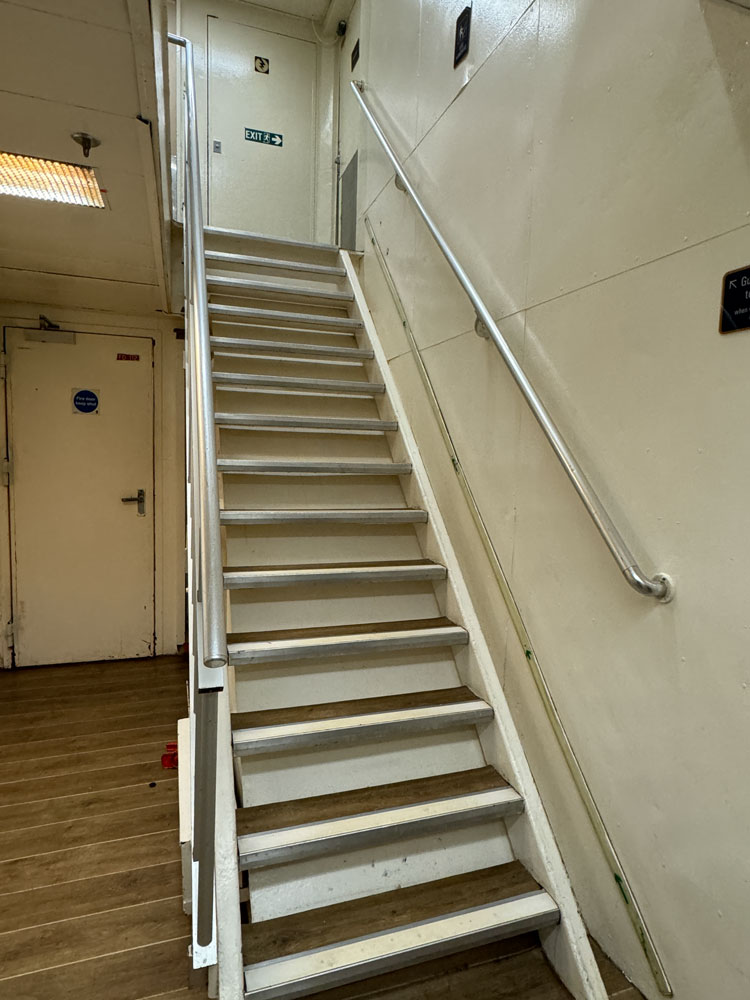
I believe itís a safety function.
If the boat hits something and begins to flood,
the flooding will be limited to the cabins numbered 125 to 140 which are
forward of the watertight door.
In essence, they sacrifice the forward cabins
on that deck to protect the ship and the rest of the passengers.
That may be one reason those cabins are the
lowest category.
I think the possibility of hitting something, and then
taking on water, is very low but take that into consideration when choosing your
cabin.
The Tauck people gathered in the Amphorae Restaurant in the morning and Michael
gave us a review of our
activities for the day. We were supposed to have a tour of the island of
Delos but the
island is closed because of Easter, so we'll only do a tour of Mykonos.
We boarded the tender about 8:15. Here's the Tauck group on the tender.
As the tender was pulling away from the ship, I was able to get a picture.
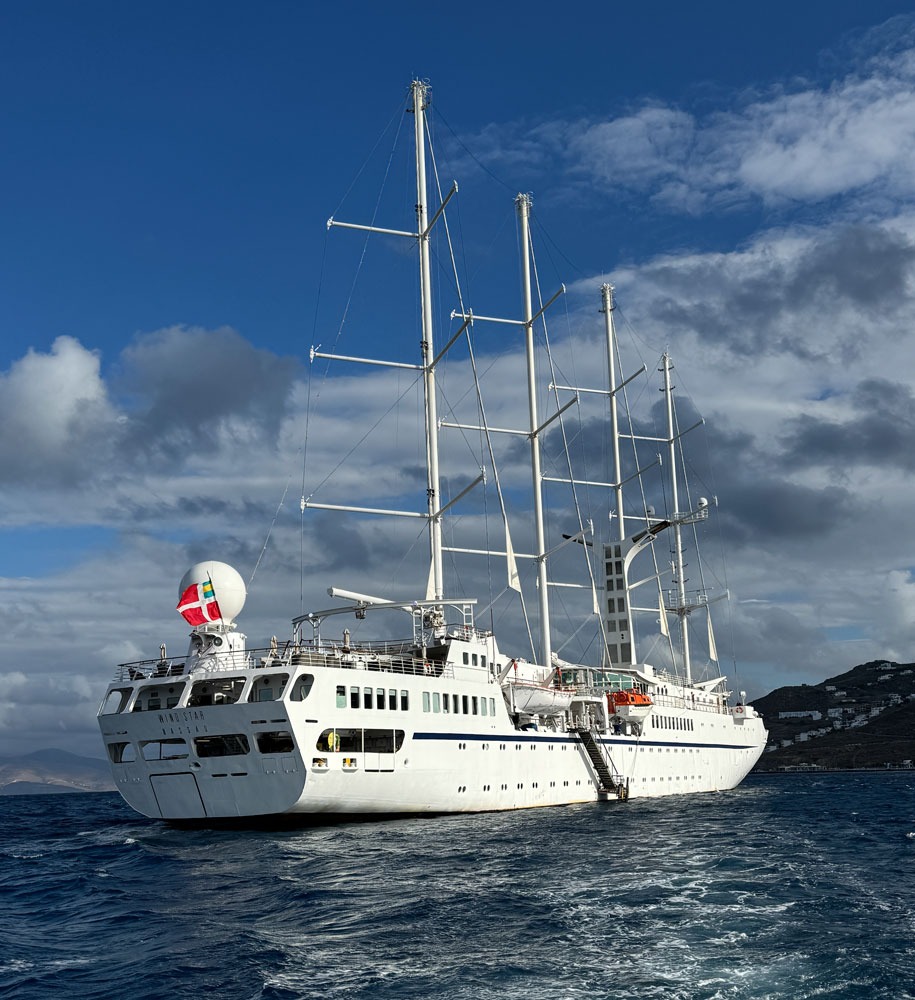
Tourism is a major industry for Greece, and just about the only industry on Mykonos. I noticed that all the homes are very well kept. The guide said that just about everyone works in the tourism industry or has a business that caters to tourists. It appears that the citizens of Mykonos do well from tourism.
The peak tourism season is July and August.
We arrived in the port area, shown on the map towards the right side of the map.
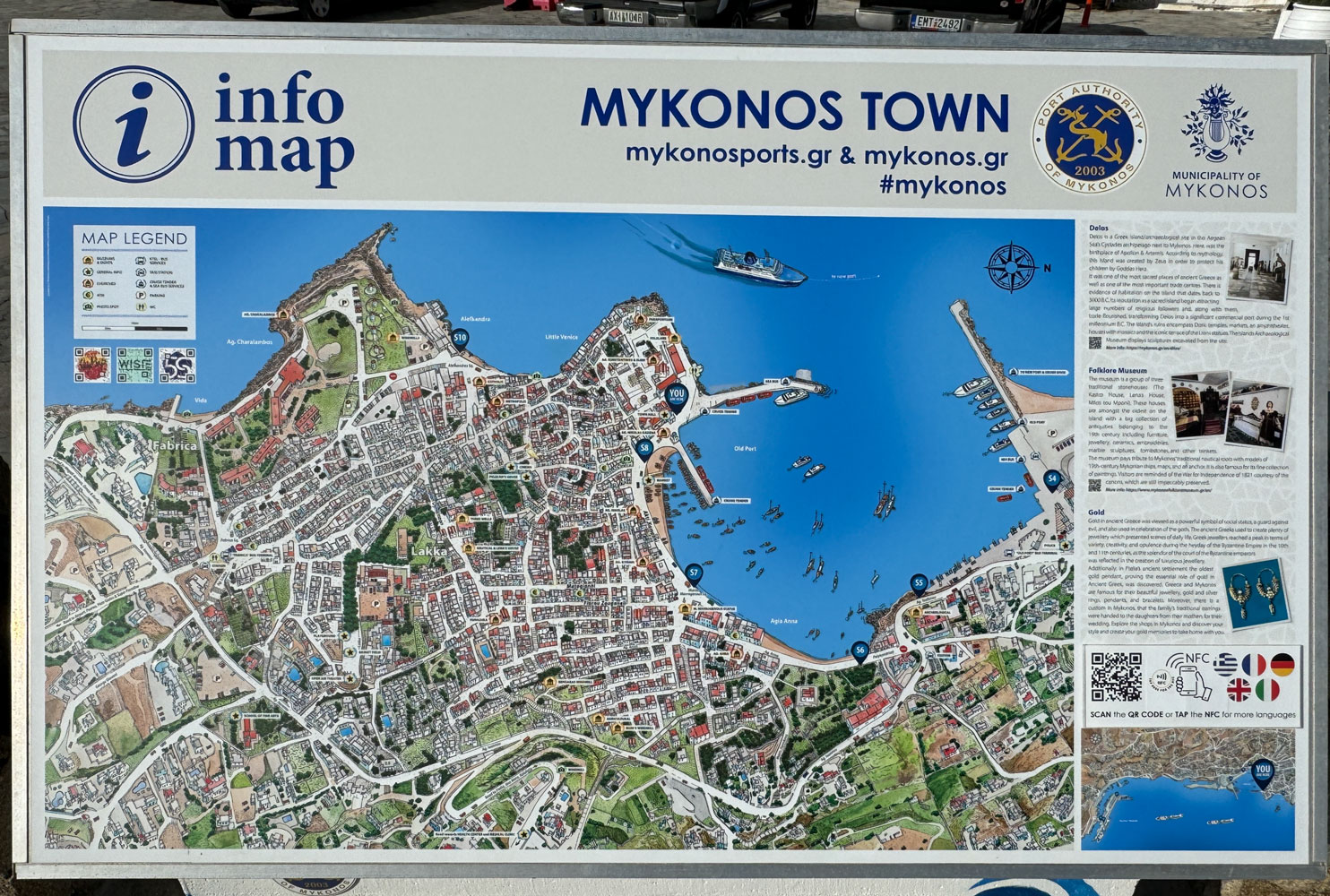
We walked through the town on the narrow alleyways. Everything was very clean, and all the buildings are painted white (by law). Whitewash was originally used as an antibacterial product, but now they use white paint.
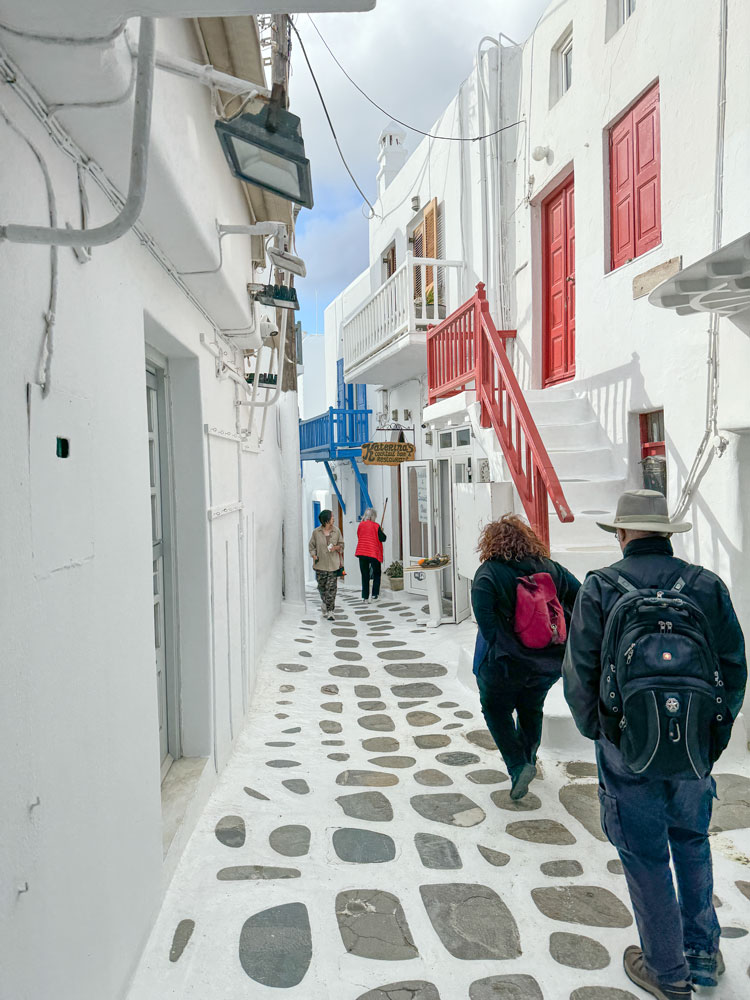
After walking through part of the town, we came back to the port, where we could see the Mykonos Windmills.
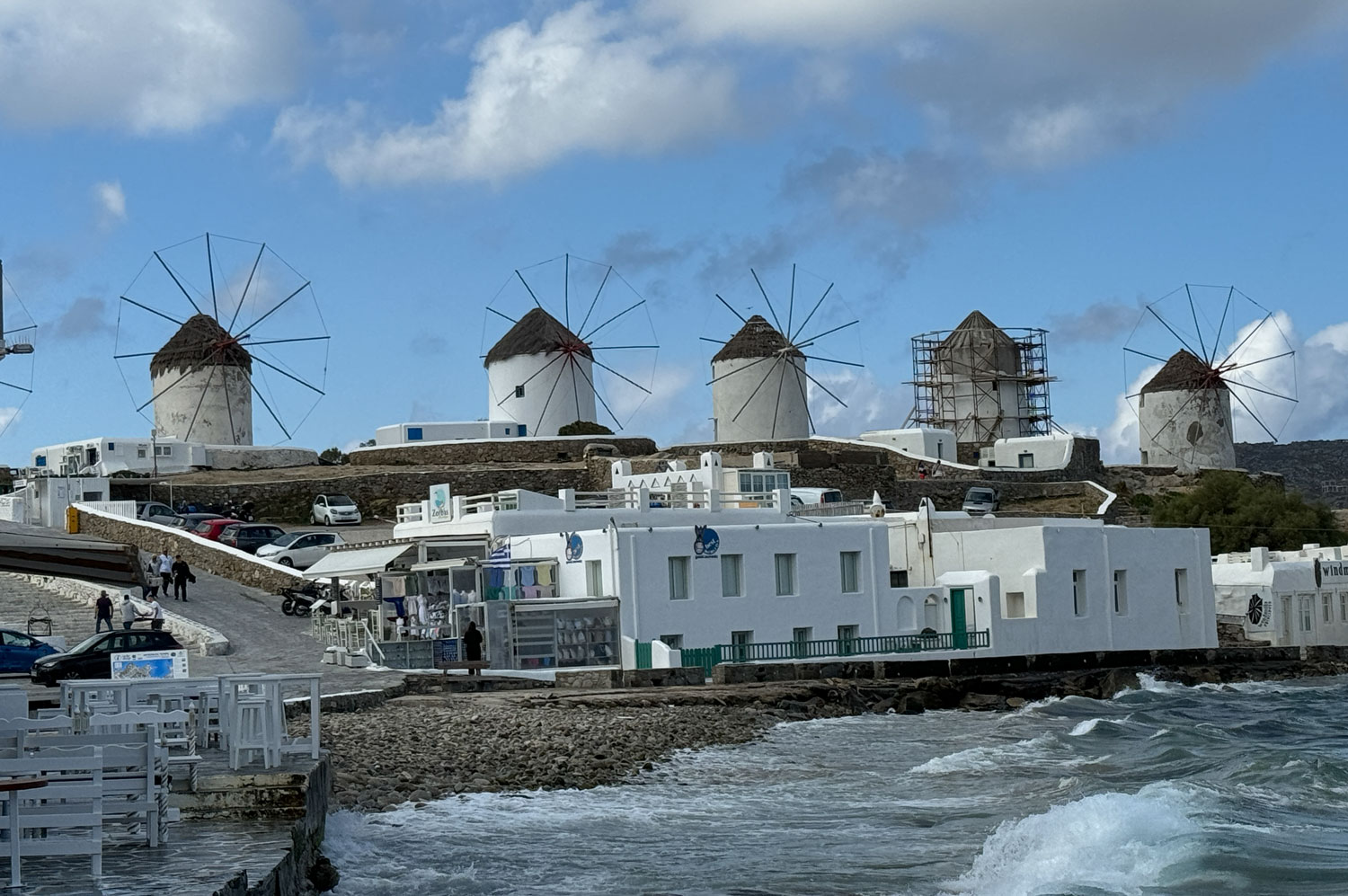
When we concluded our walking tour, we walked to the other side of the port area to catch the bus. There are a lot of cats on the island, and people feed them. You can see that this cat is eating kibble at one of the numerous "kibble stations". They also have water bowls here and there.
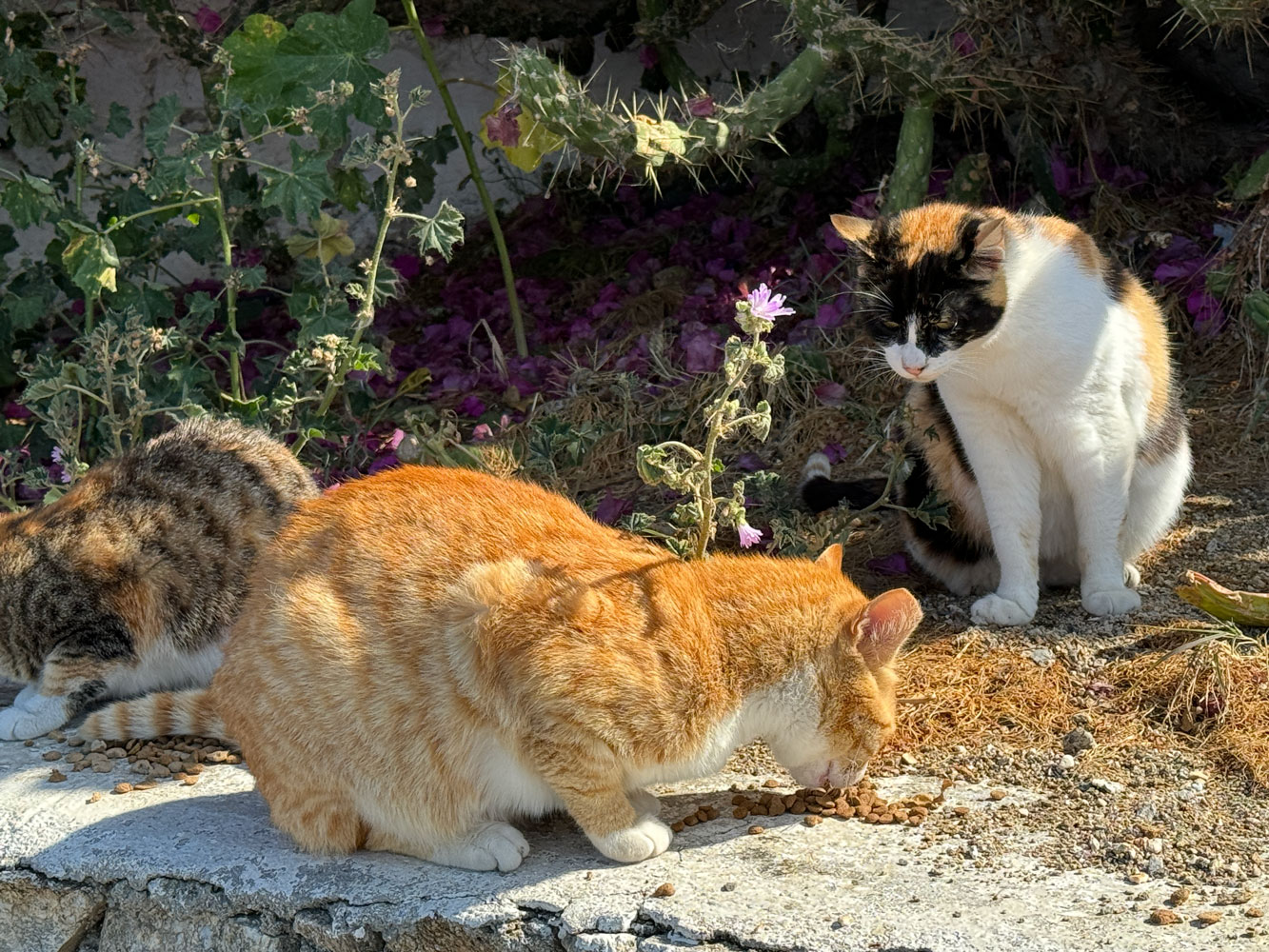
We boarded the bus and set off.
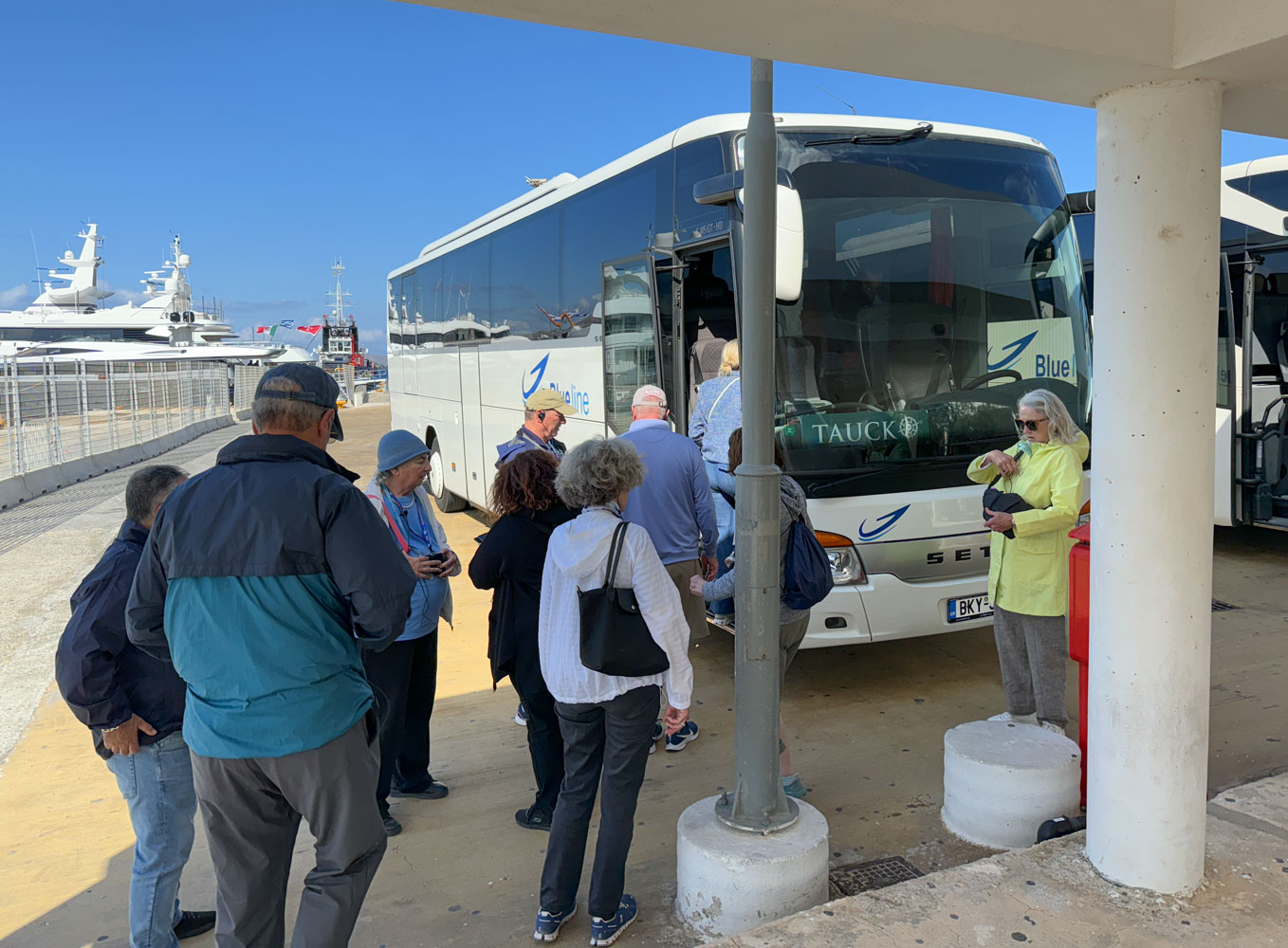
It was nice to see the area, but I didn't take many pictures out of the bus. We eventually went to the town of Ano Mera, and the 16th Century monastery of Panagia Tourliani.
As we were walking in, one of the feral kitties posed for me. Handsome fellow, isn't he?
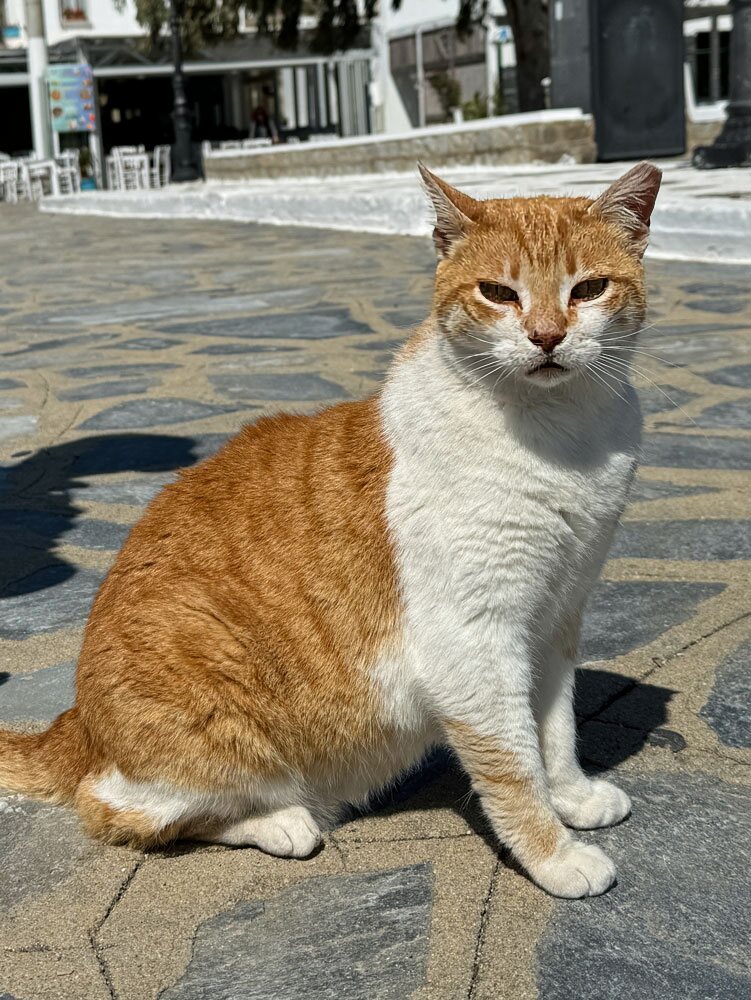
The group divided into two, and the other group went to the monastery, while we went to a coffee shop. We sat with two other couples, and both of the men were born in New Orleans. How's that for a coincidence? All three men born in the same place, within a couple of years.

The two groups switched places and we went to the monastery. Here's the outside of the church.
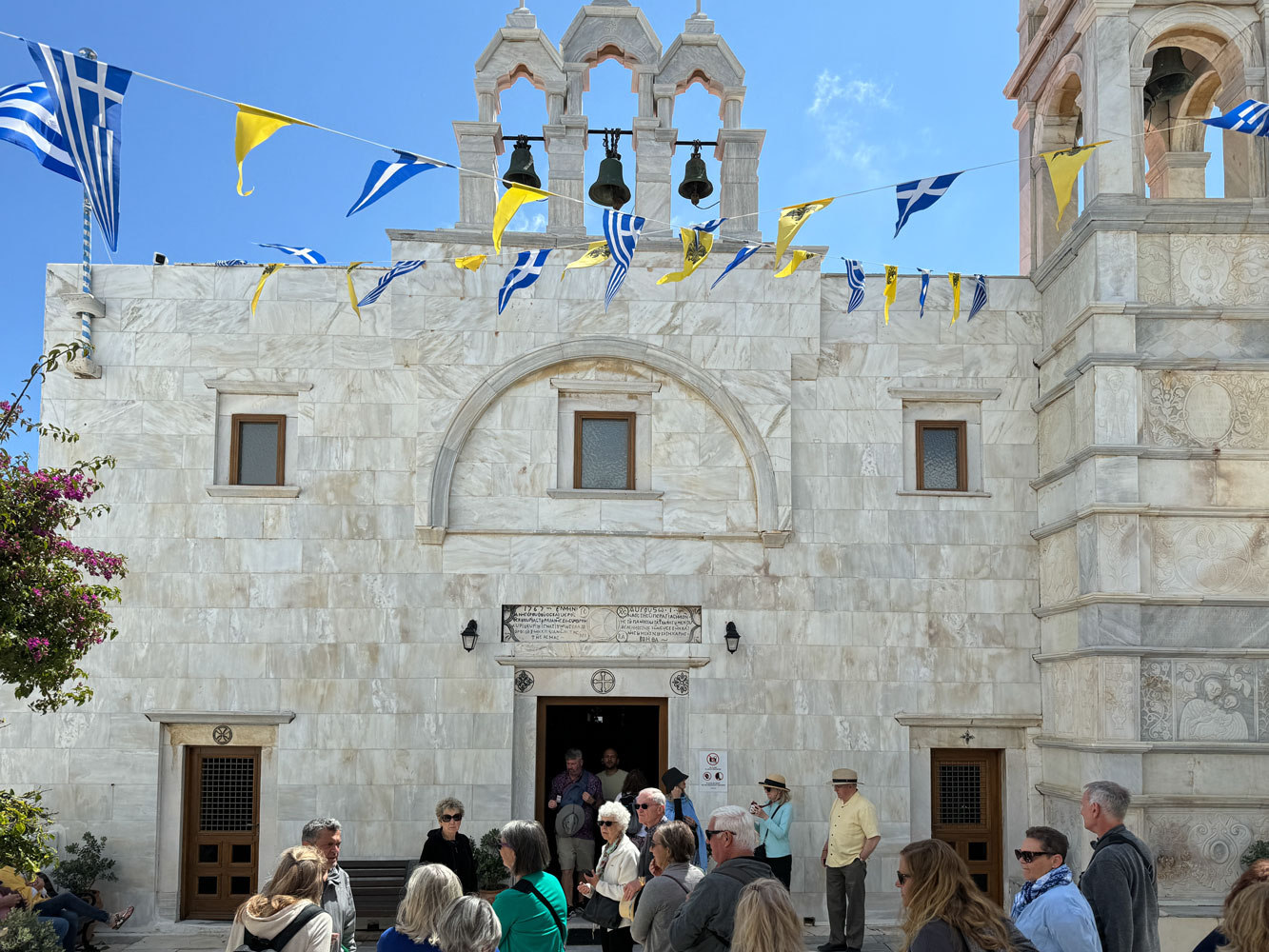
The view into the church as you entered.

The back wall is highly decorated with gold and silver.

The church's Easter bier.
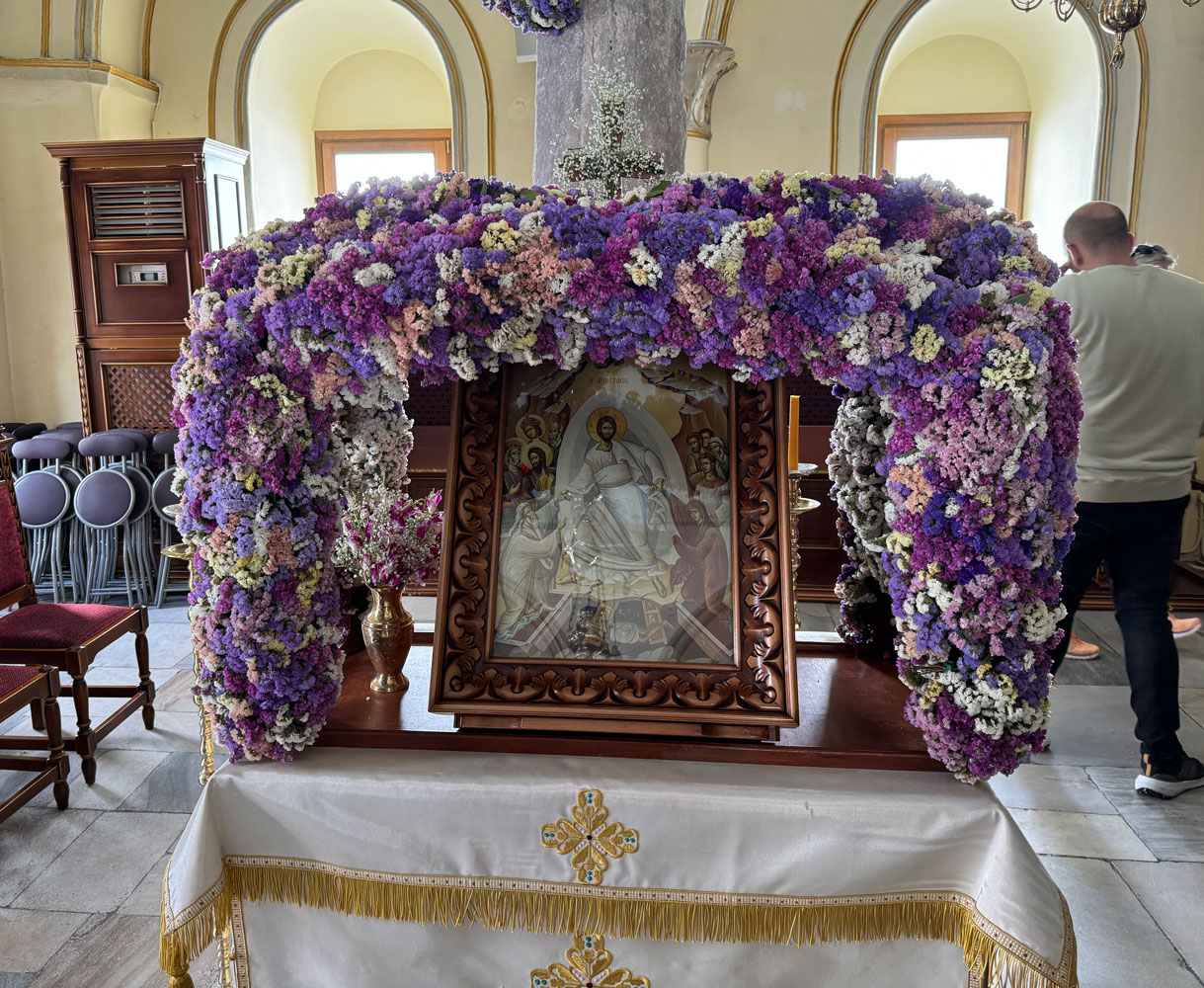
Looking up at the decorated dome of the church.

After that, we did some more sightseeing from the bus and then went back to town. Judy and I did some shopping and then had a pizza at one of the seaside restaurants.
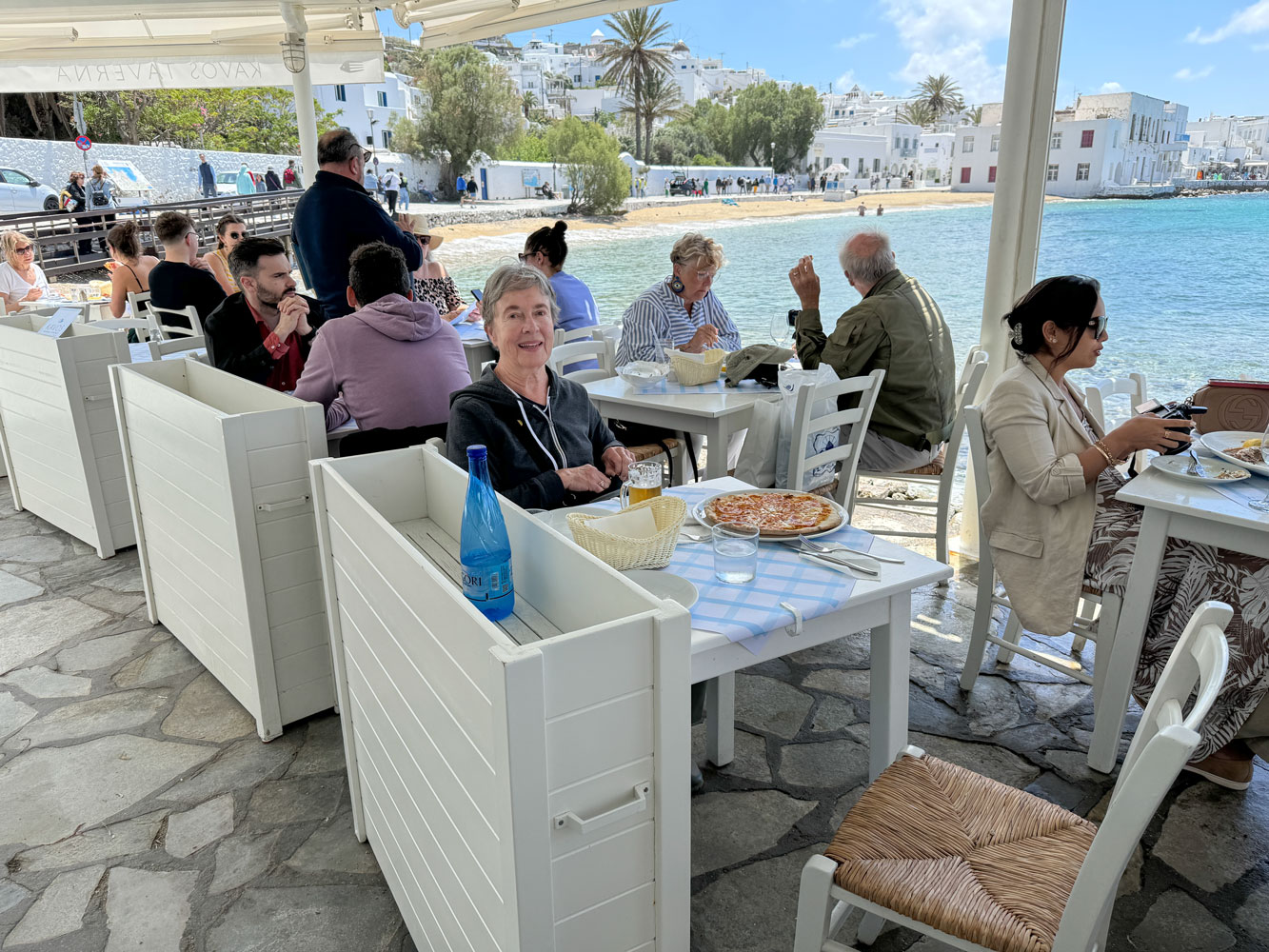
Then it was back to the ship on the tender. The visit to Mykonos was not that interesting - it's basically a tourist town.
Before dinner, the captain (on the left) introduced his staff to the guests.
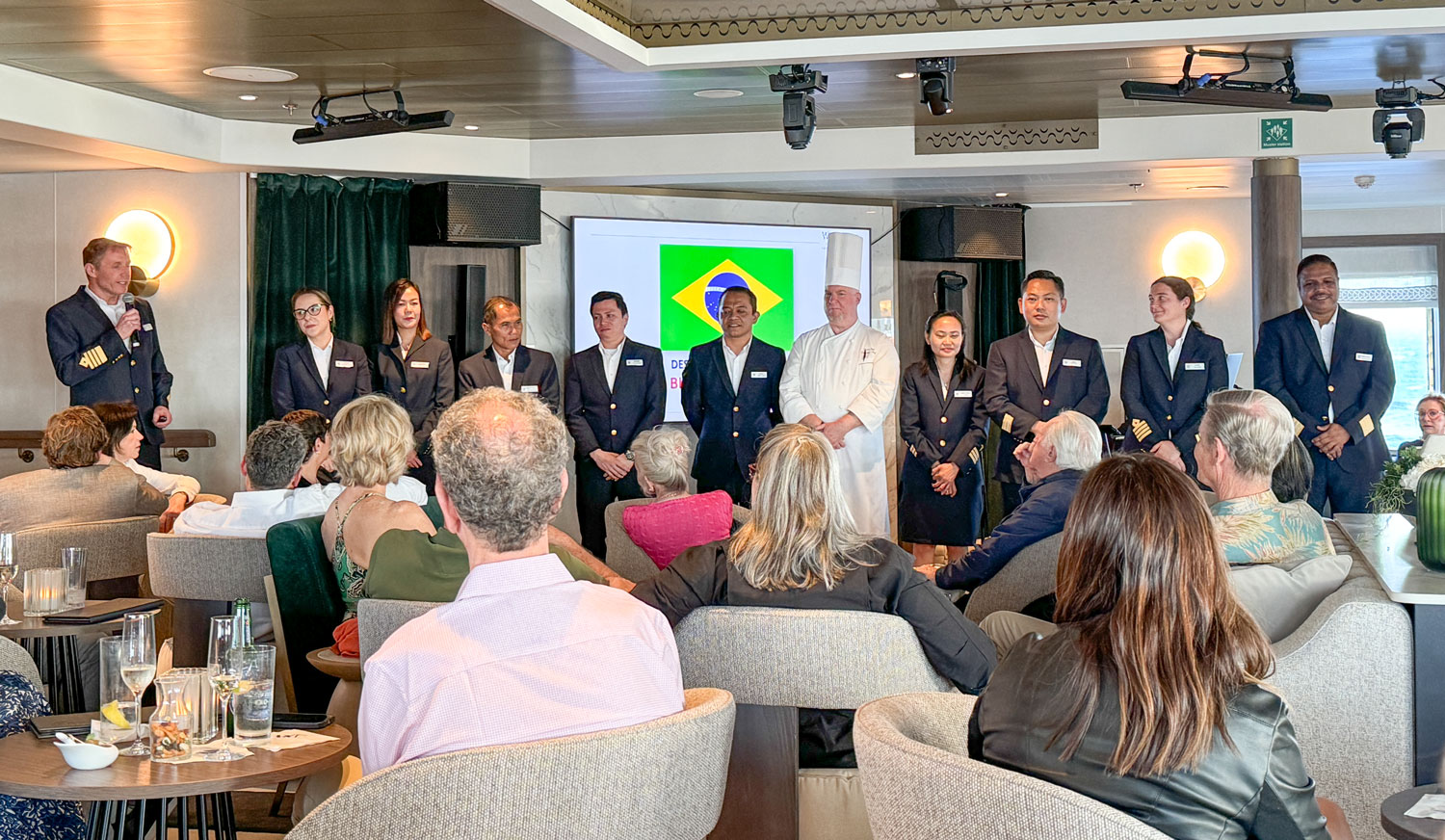
Then it was to dinner. I skipped the main course, but did have dessert. We sat with a very interesting couple from Anchorage.
That was the end of another day. Tomorrow, we go to Kusadasi to visit Ephesus.
+++++++++++++++++++++++++++++++++++++++
May 6, 2024 (Monday) When we woke up this morning we were in Kusadasi.

Judy and I have been here before but we're looking forward to seeing Ephesus again.
We had room service for breakfast - we found that was more convenient than the Veranda restaurant, and took less time.
We departed the ship a bit after 8am and arrived at the upper entrance to Ephesus about 9am. Most people go from top to bottom because the walking is easier.
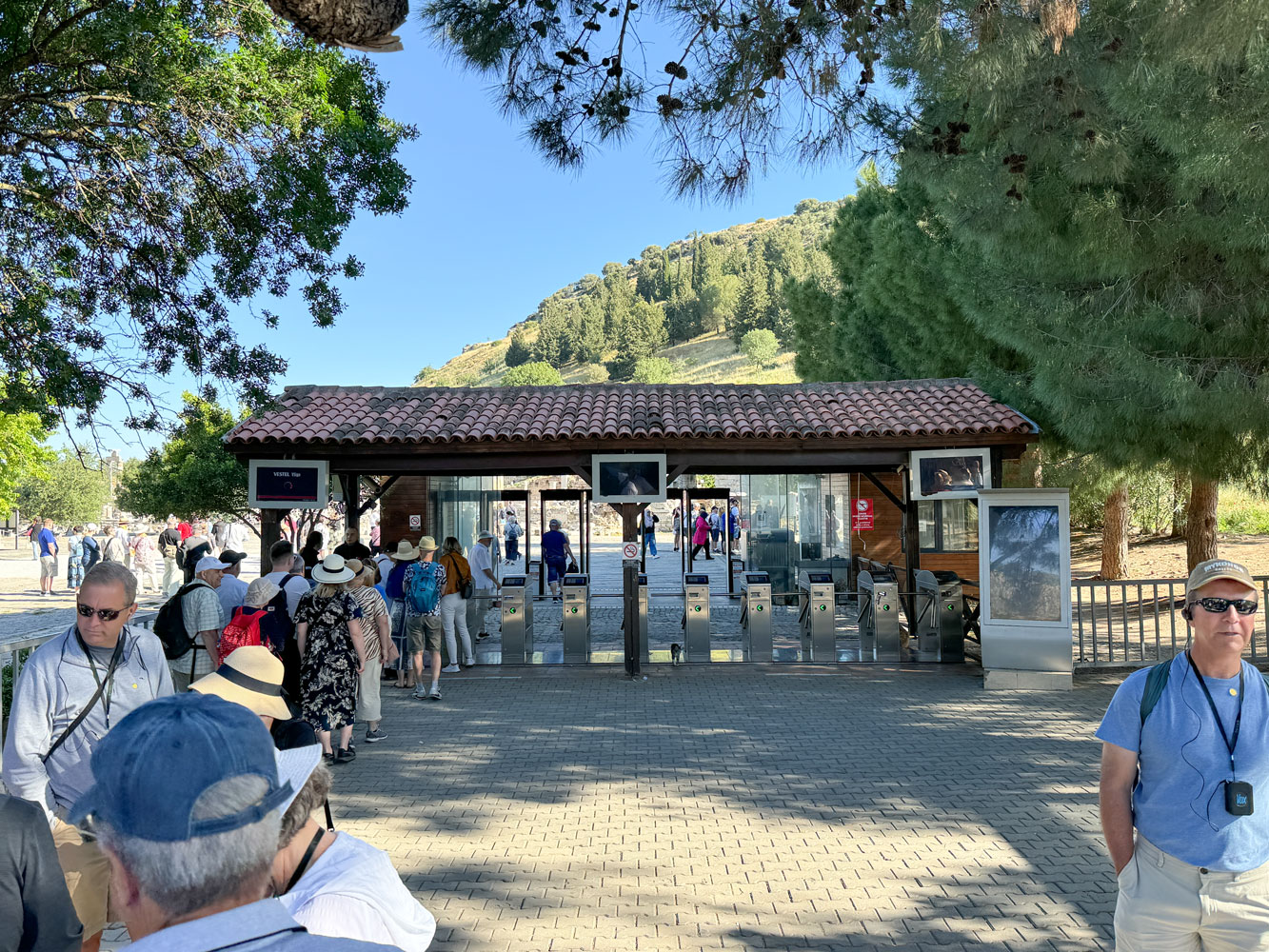
We had an excellent guide, Hakan Kasap. He was a wealth of information about Ephesus - so much so that I could retain only a small part.
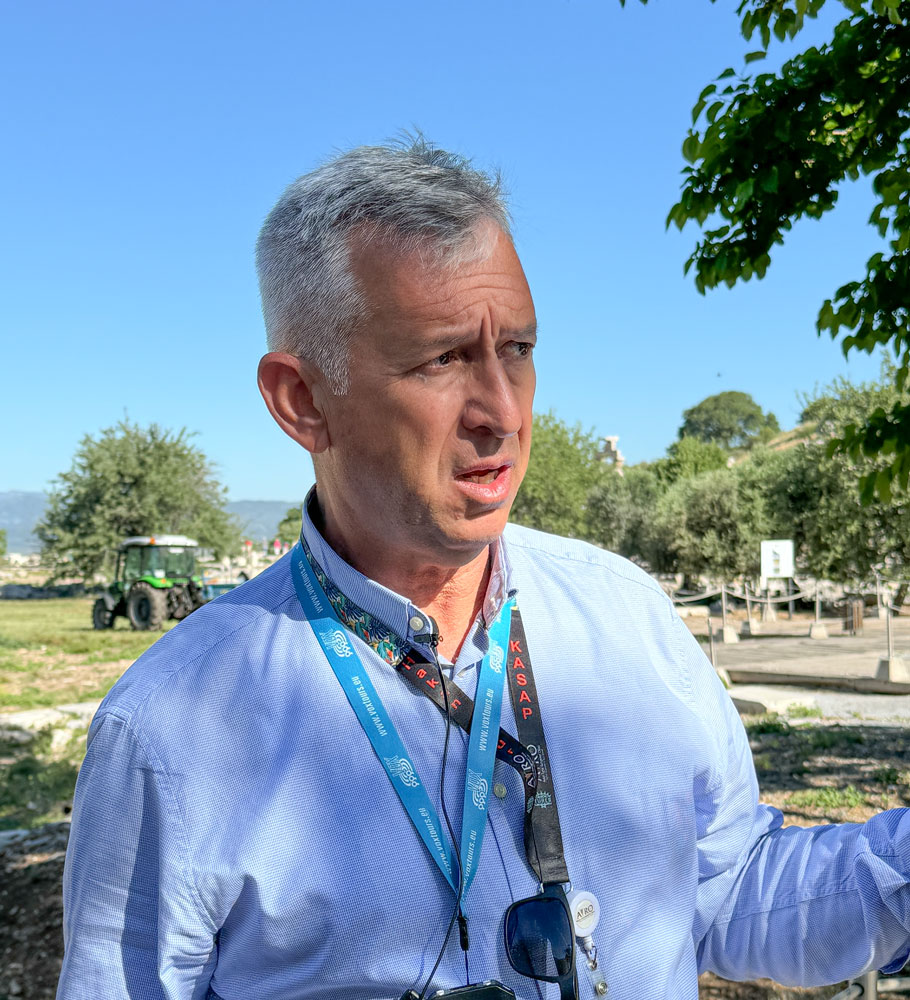
There's an amphitheater just inside the upper entrance.
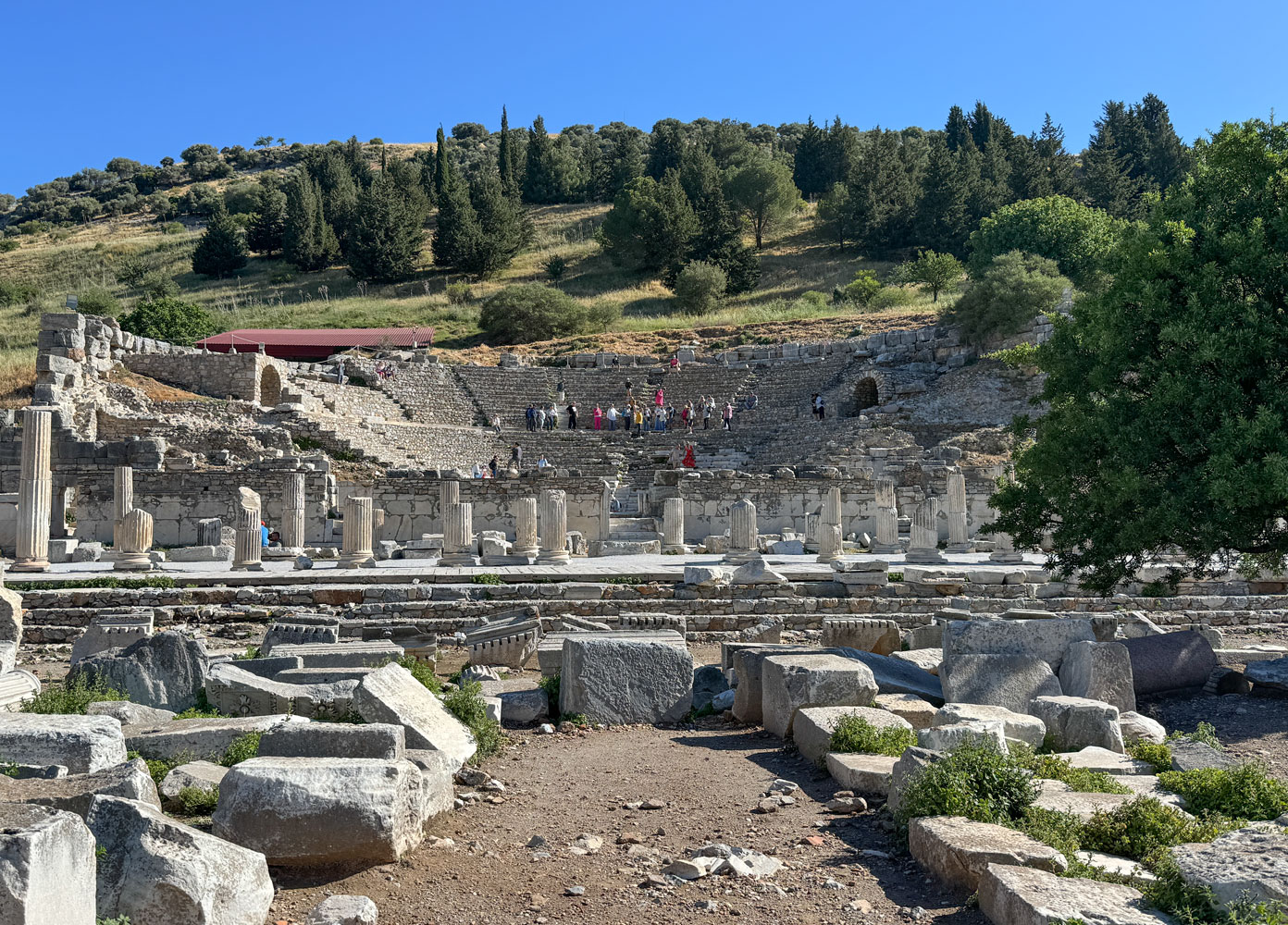
We walked down a path paved with pieces of marble and other stone. Last time we were here it had rained and the path was slippery, but this time it was not a problem.
At the end of that path are some ruins, but I'll only post this picture of Nike.
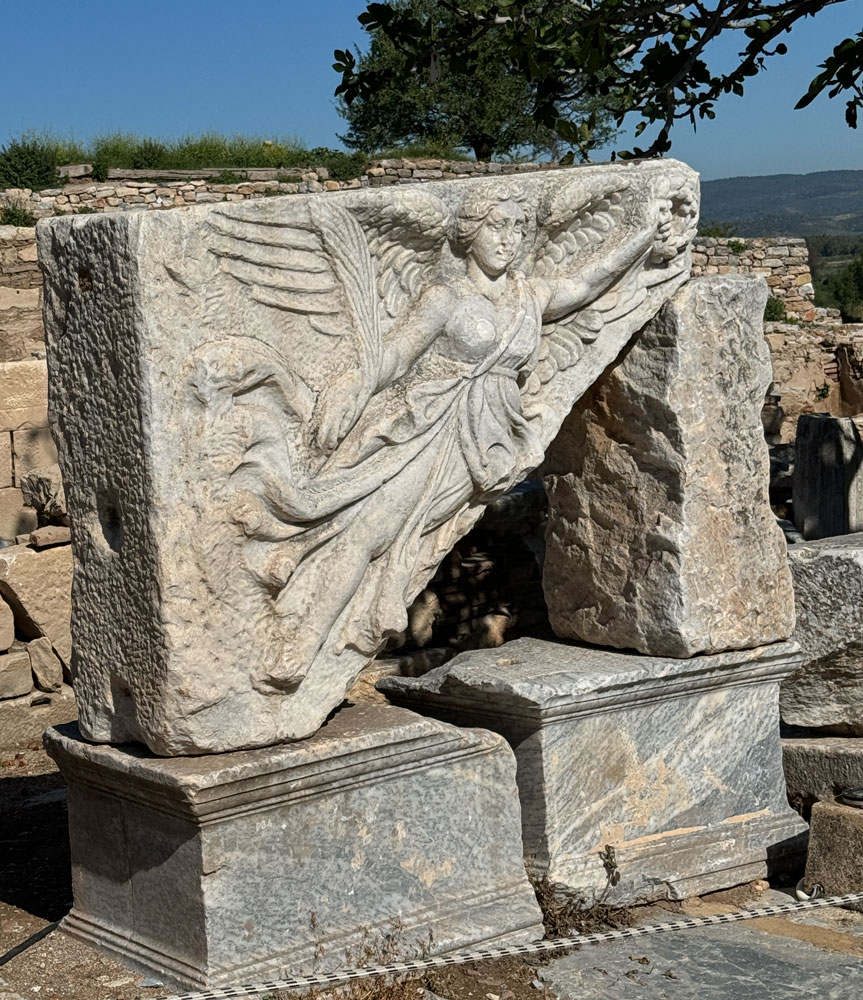
From here, we went through what they call "the pillars of Hercules" to the main road leading down to the Library.
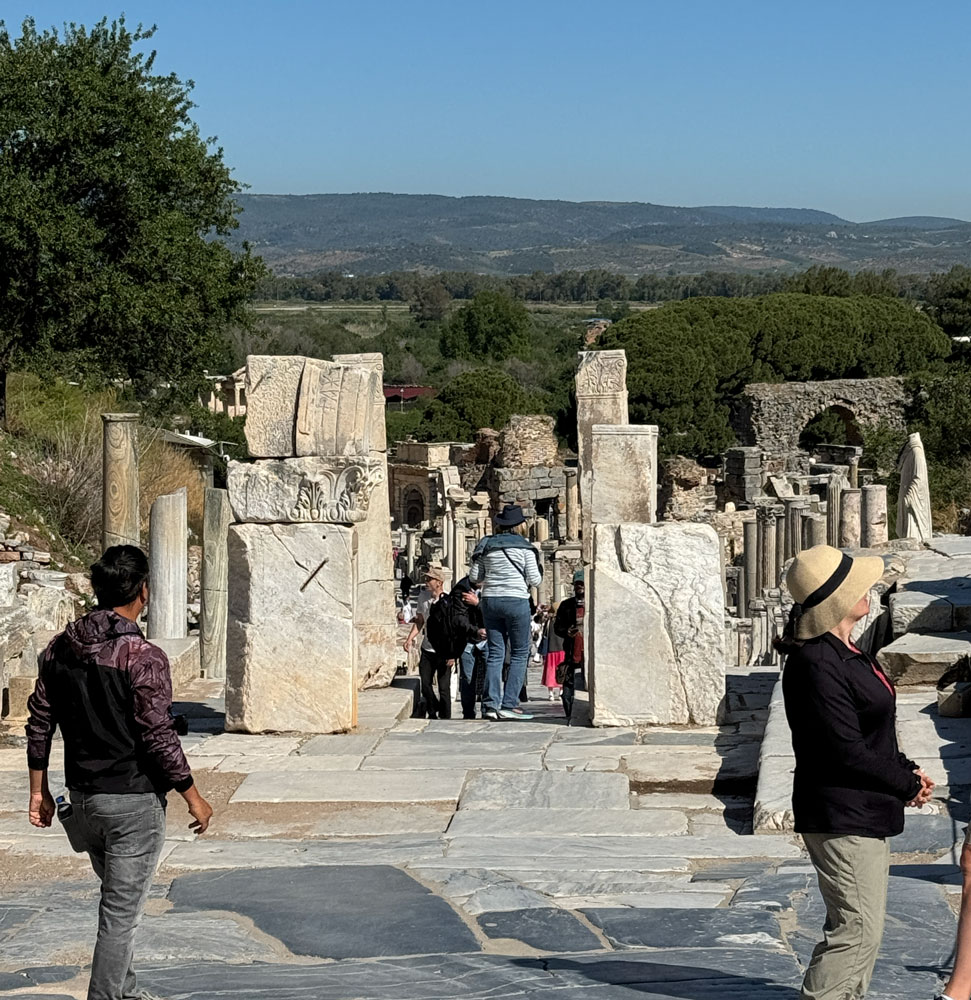
Either Tauck or Windstar had hired a photographer to take pictures of us, and he took a picture of each couple as we came through the pillars. He AirDropped the pictures to me, for a fee, but I forgot to get his name so that I could give him photo credit. Back when I did professional photography one of my mentors told me, "Sometimes you have to be satisfied with just the money."

He also did a group shot of the Tauck group in front of the Library of Celsus.
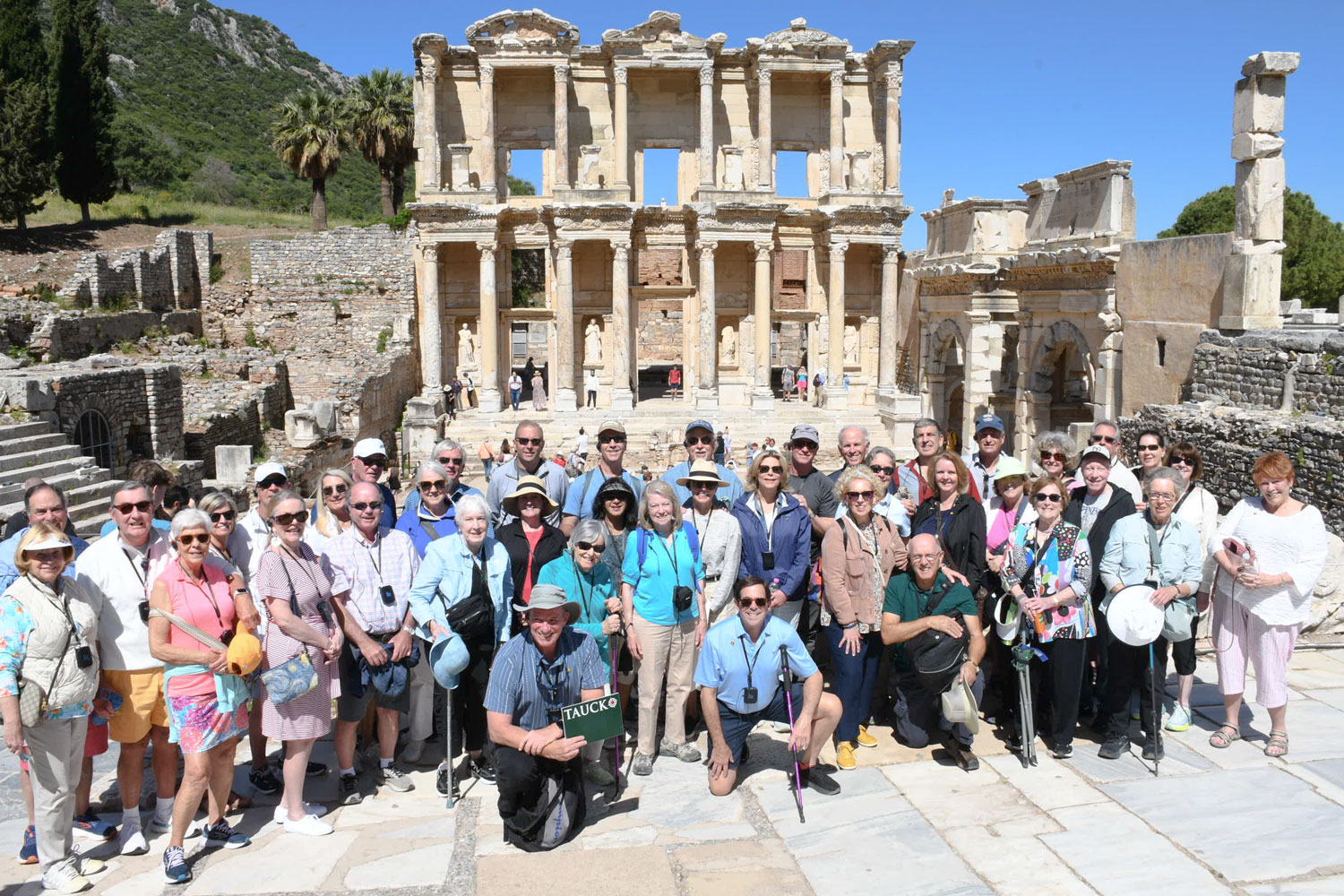
Temple of Hadrian.

Public toilets.
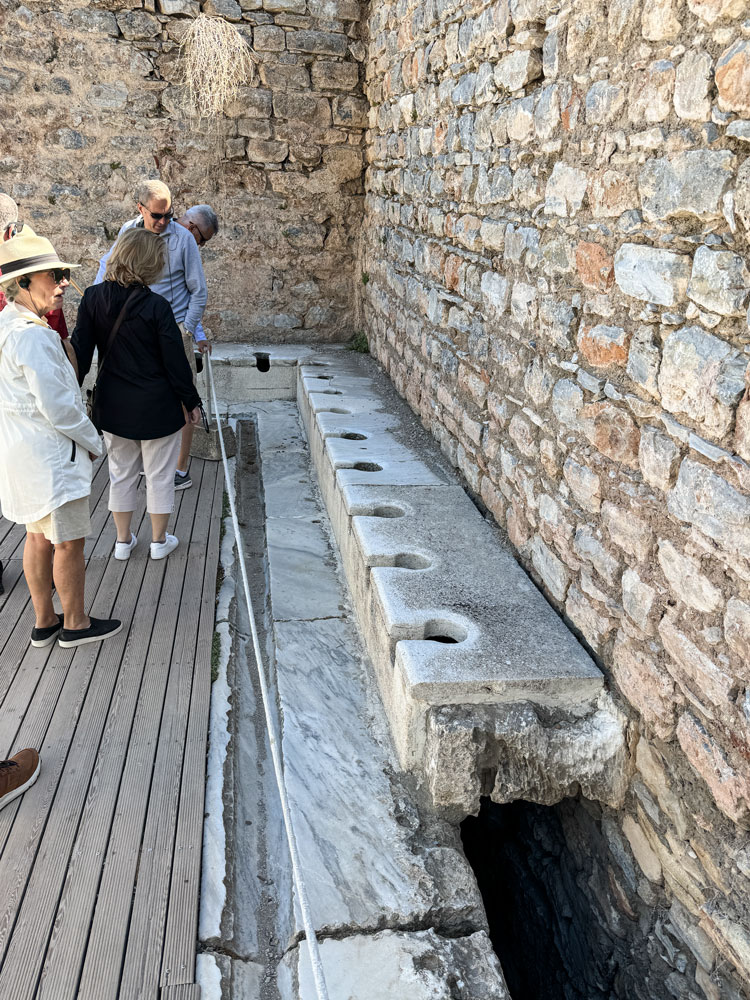
After this, we went to the Terrace Houses. I'll post a few pictures, but I have a lot more on the blog of our previous tour of Ephesus. I encourage you to follow the link if you would like to see more than what I have here.
Since the homes were built on a hillside, there are a lot of stairs to climb to go through the whole exhibit. You exit at the top.
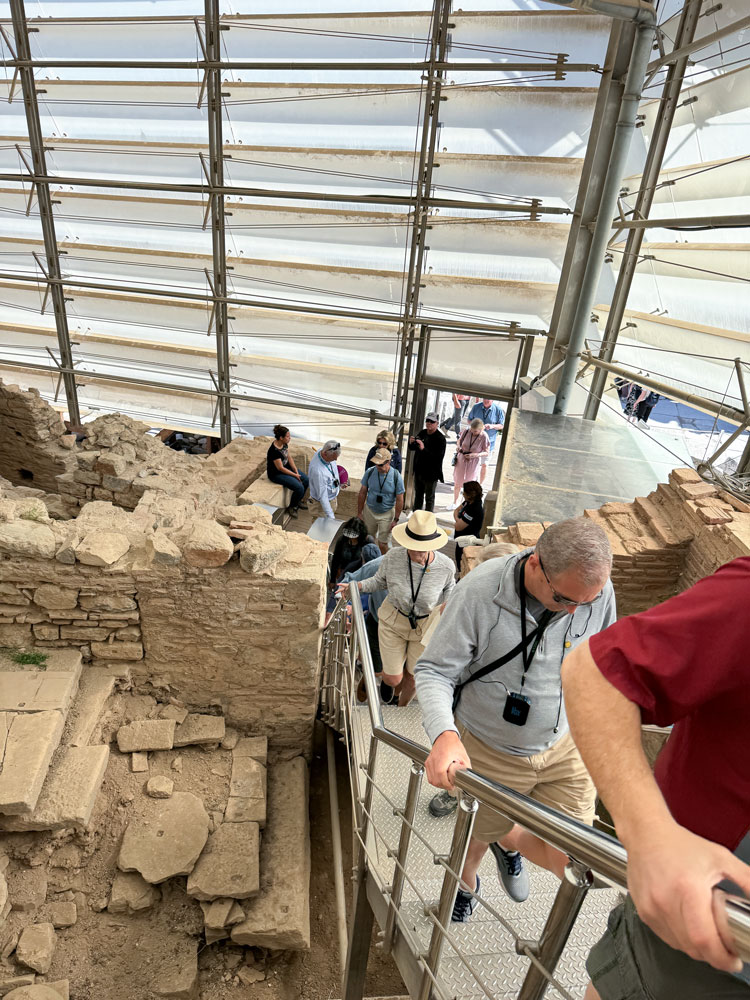
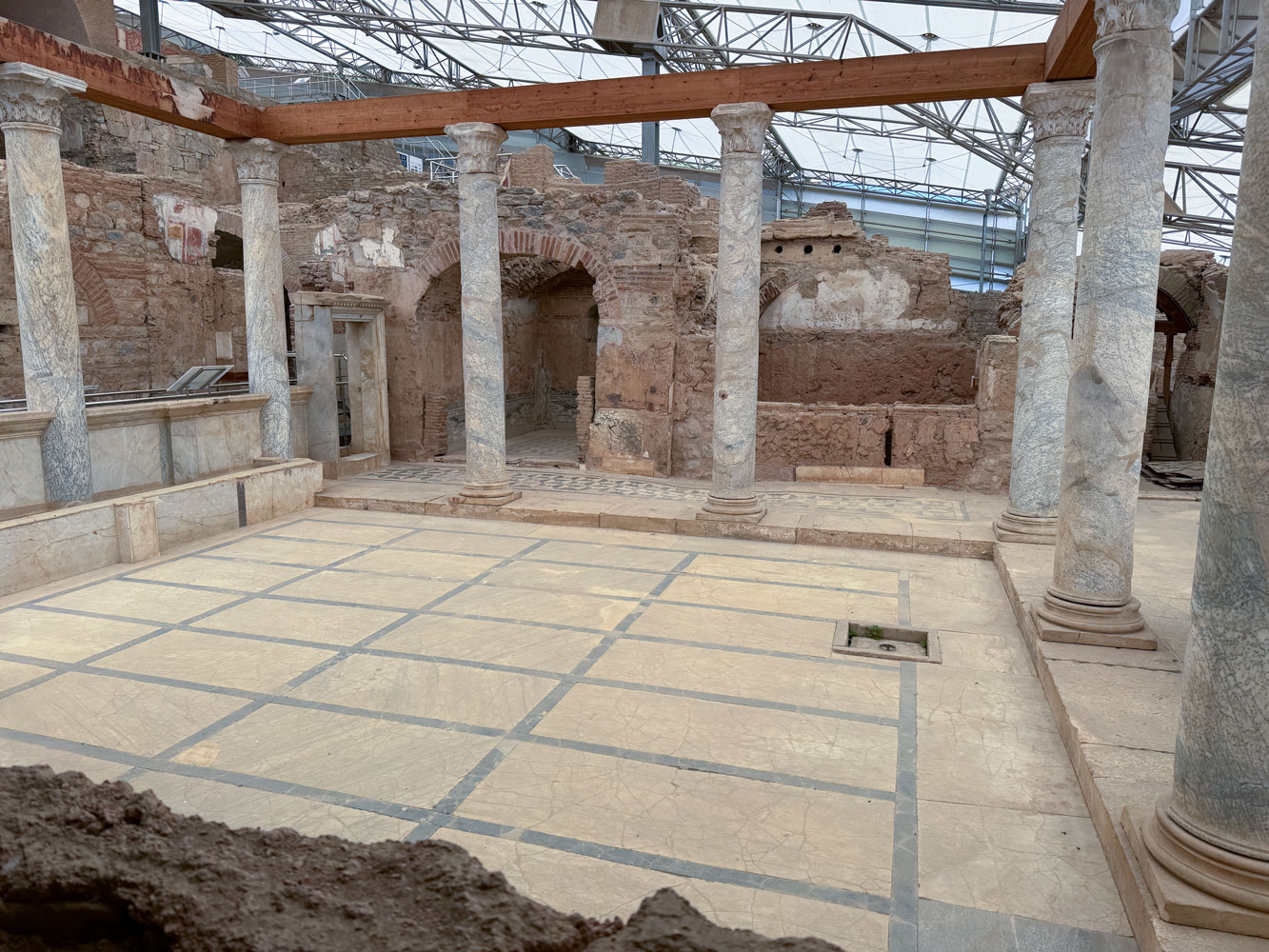
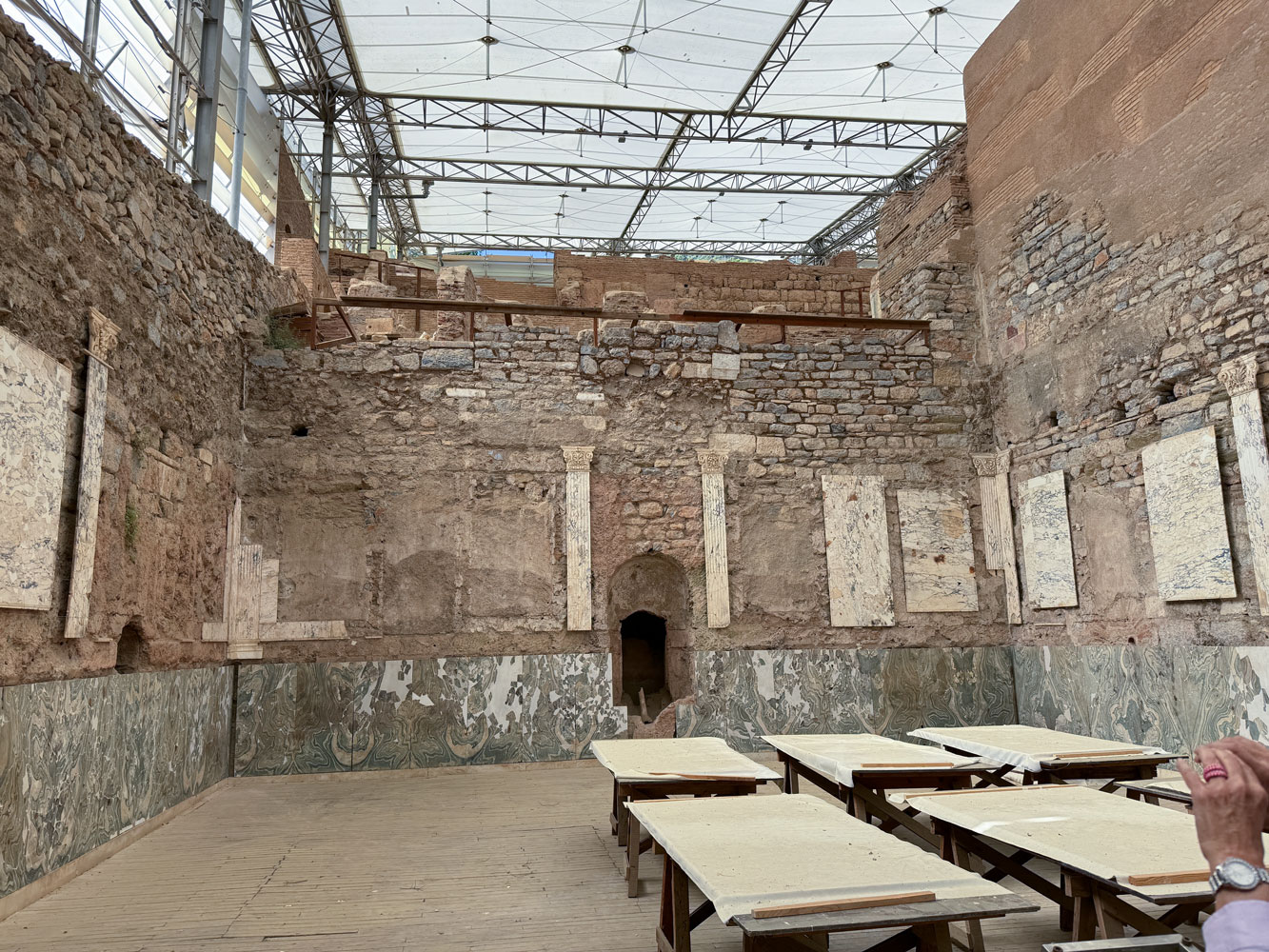

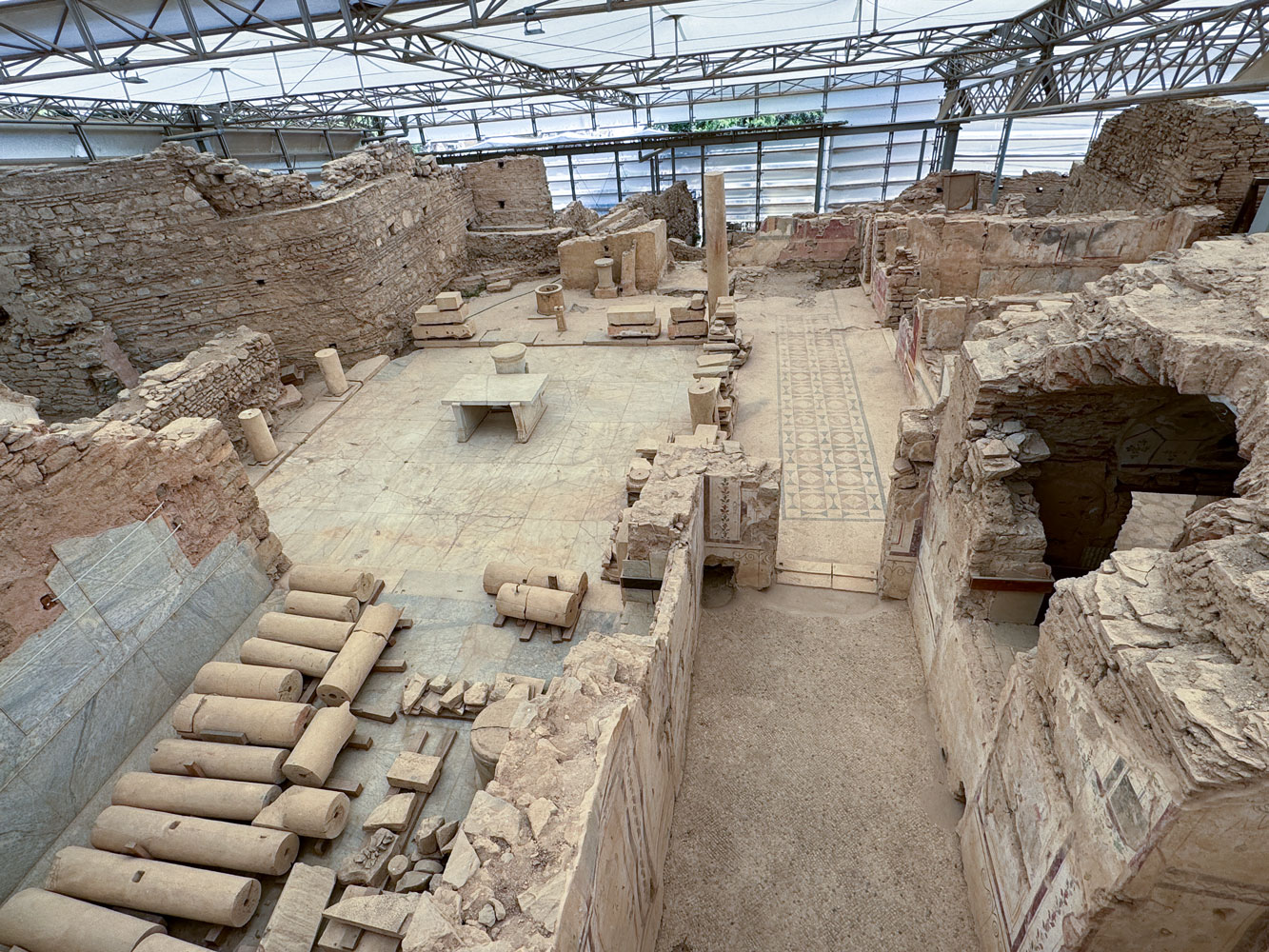

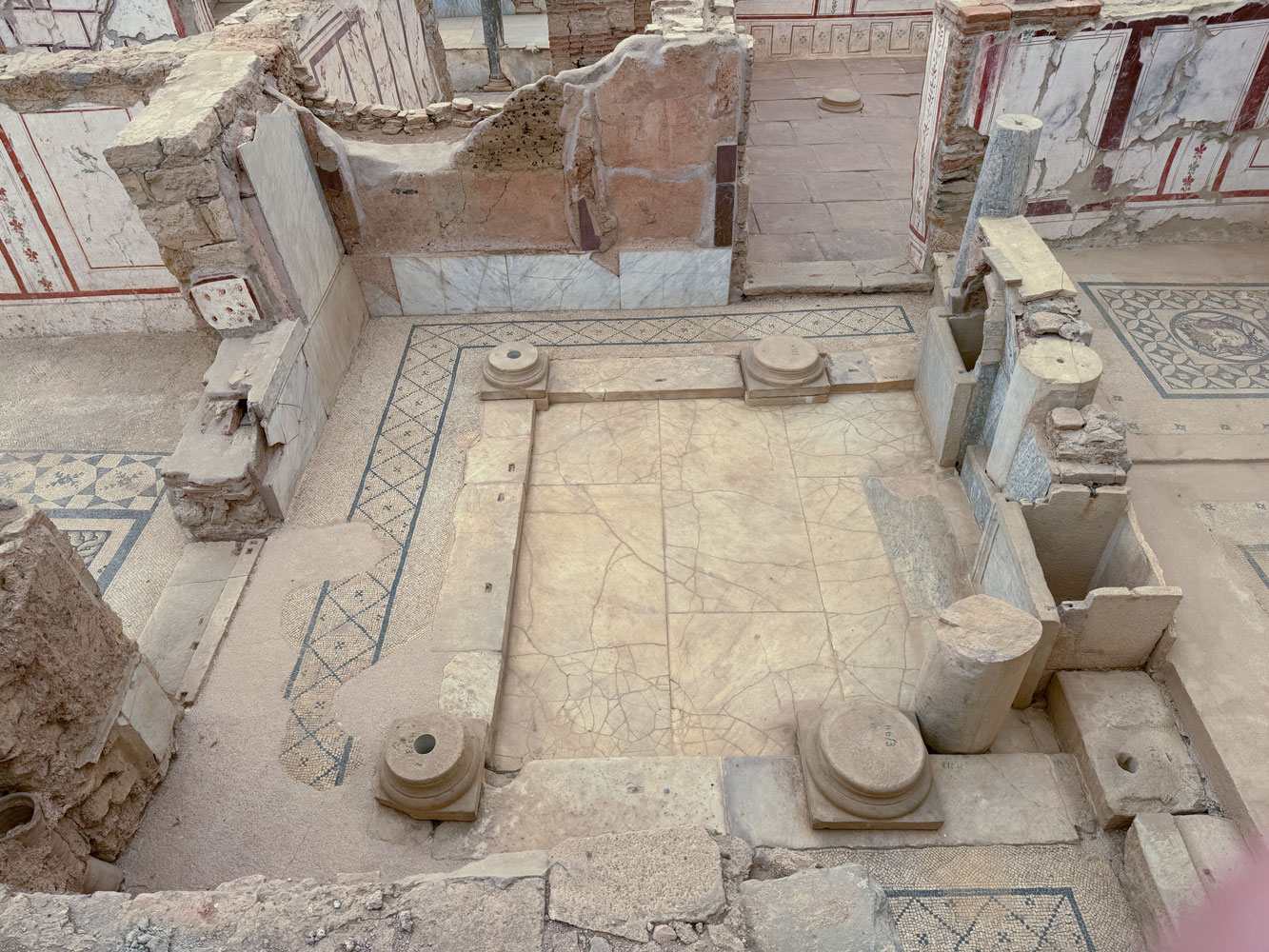
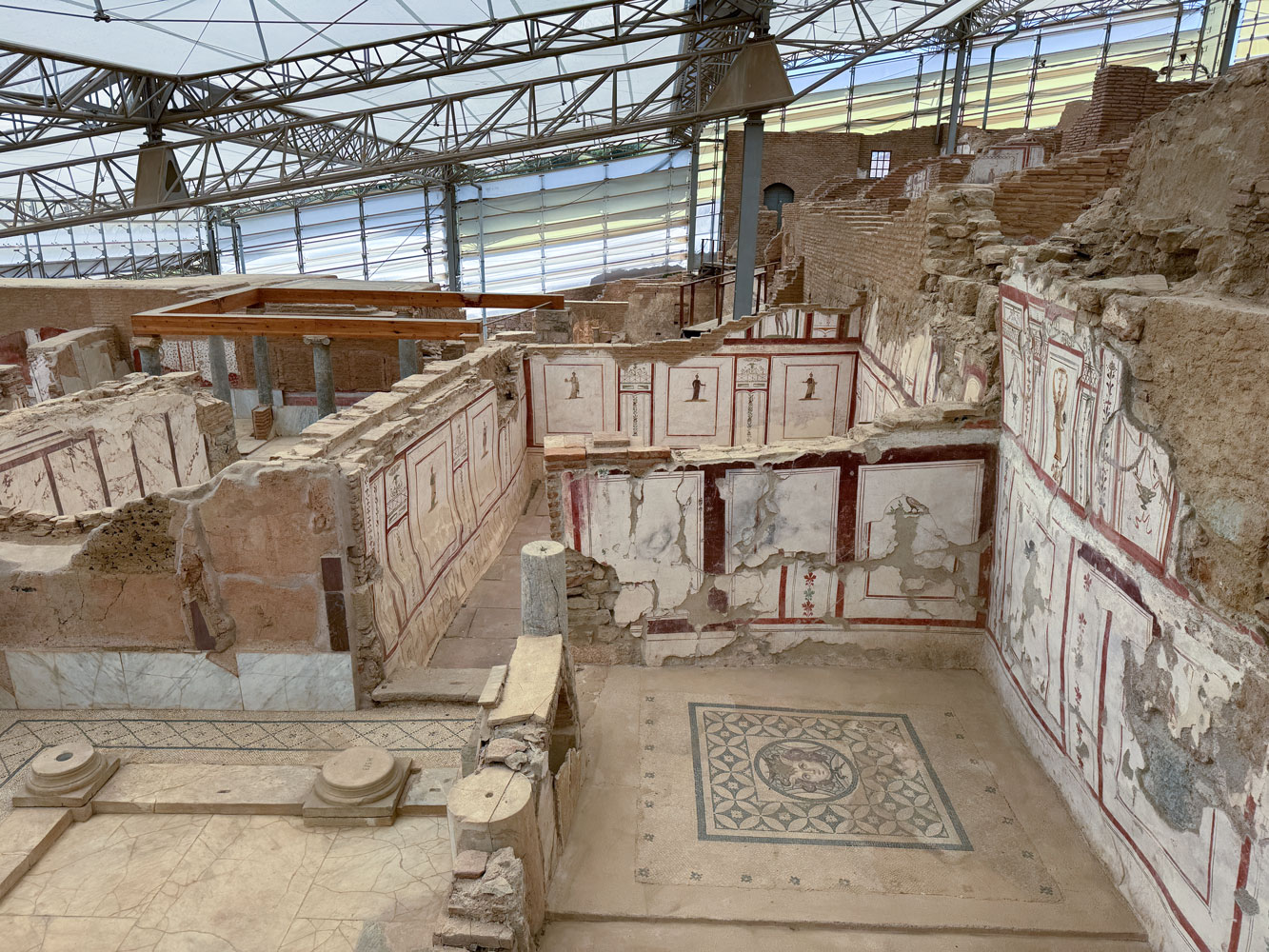

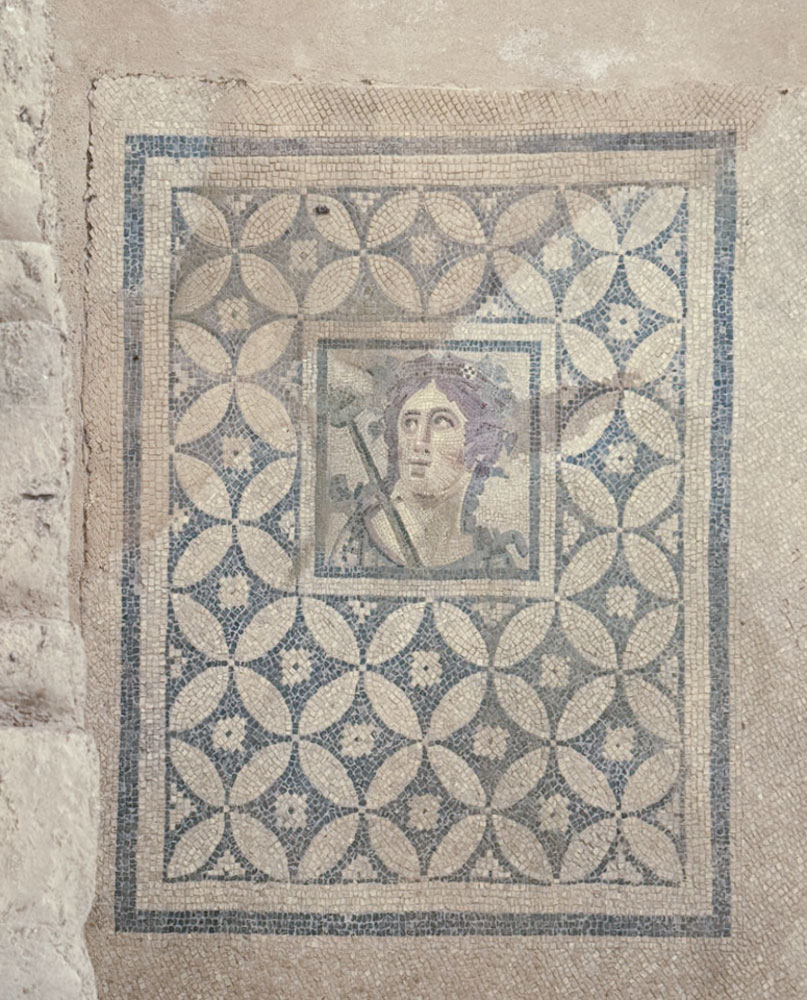

With that last picture, we had reached the top of the Terrace Houses, and exited. From the top, we could look down on the other main street of Ephesus.

When we reached the bottom of the hill, we were at the Library.
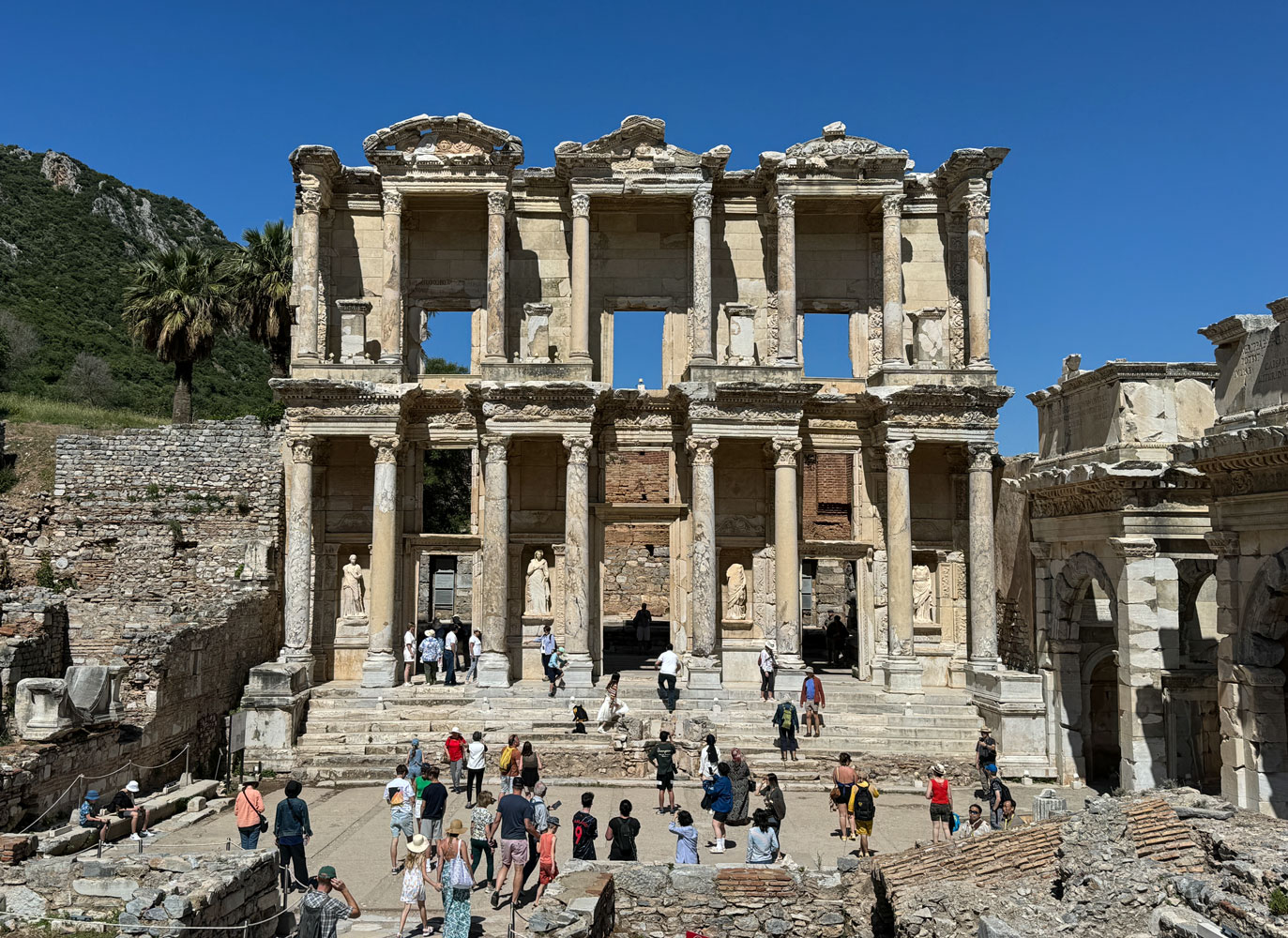
The path leading out from the Library.
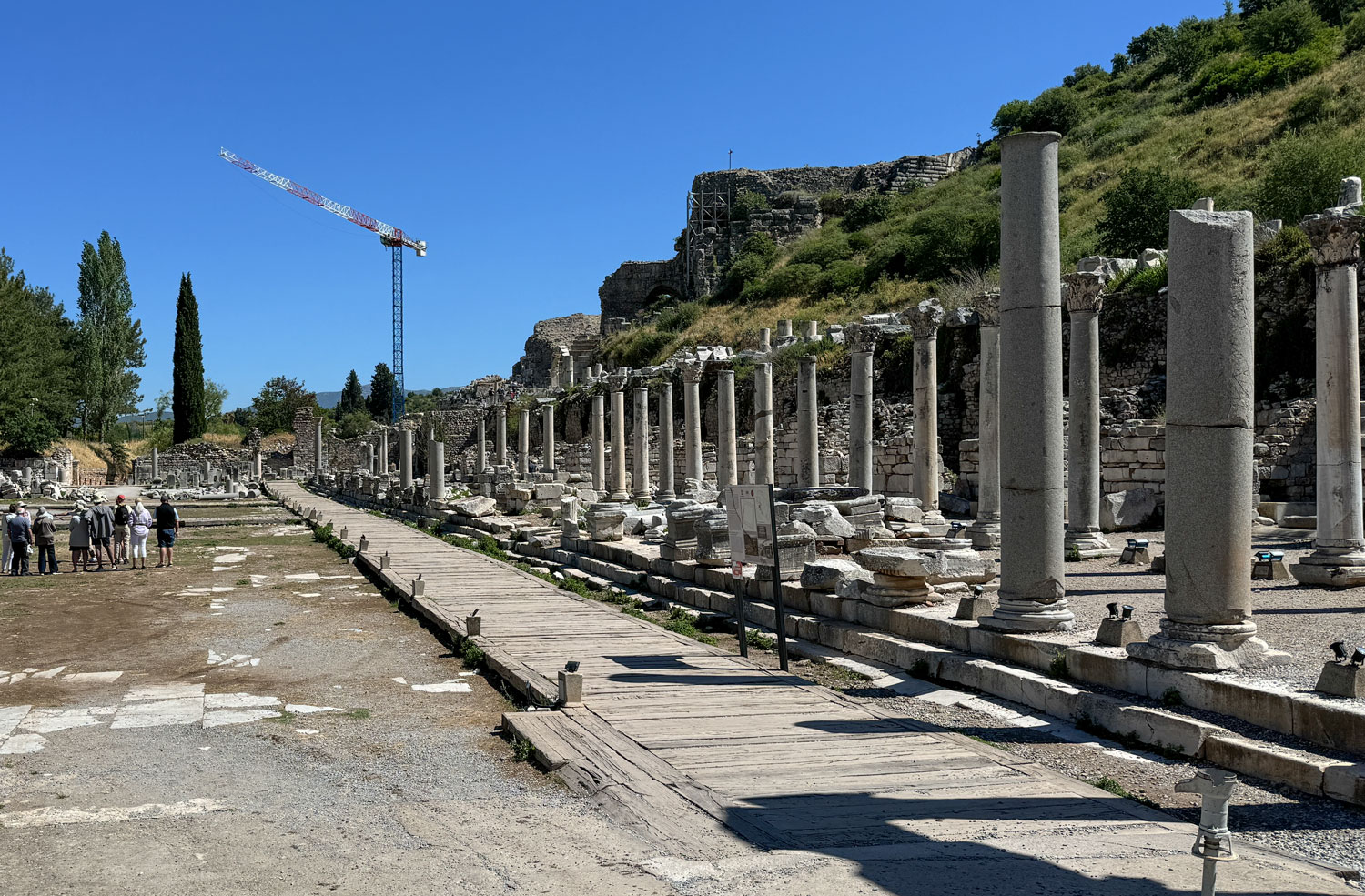
The huge Ephesus Amphitheater.

Last time we were here, Garfield, the orange cat, was holding court. Garfield is so popular that he has his own Instagram page. But this time we couldn't find him.
Here's a picture of Garfield from last time we were here. I hope nothing bad happened to him.
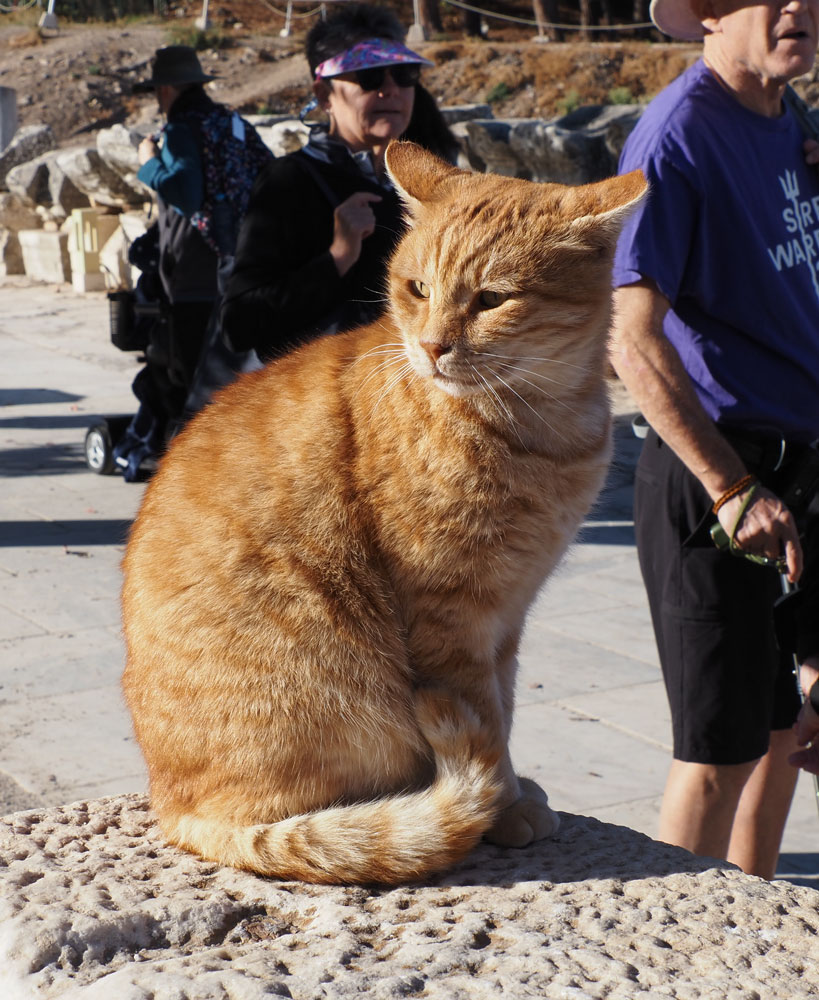
We will take the bus to the Ephesus Museum, then go to lunch where we will see a demonstration of Turkish carpets.
I didn't take any pictures of the exterior of the museum, but here are some of the exhibits.
Statues from some of the buildings.
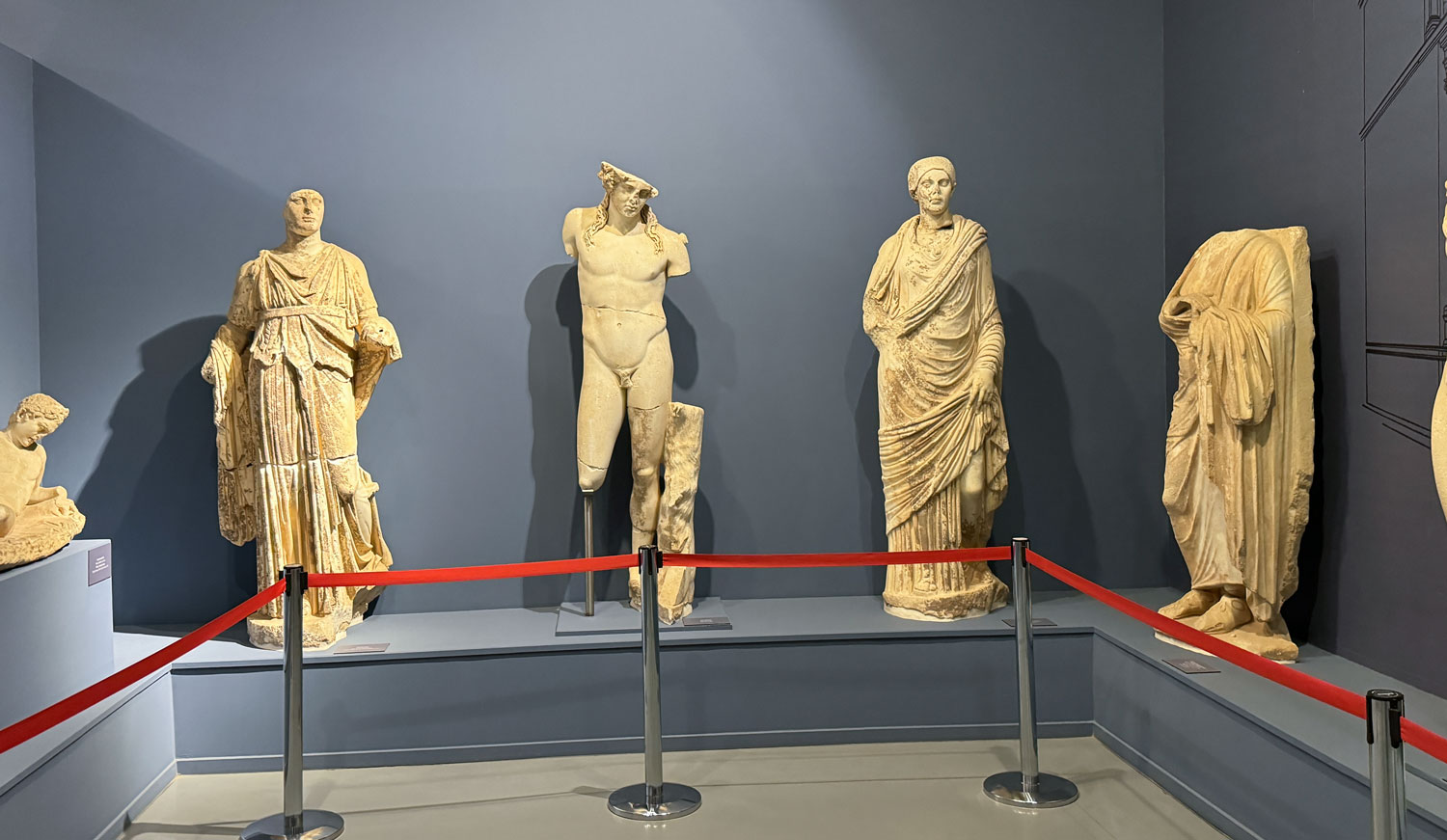
A frieze.
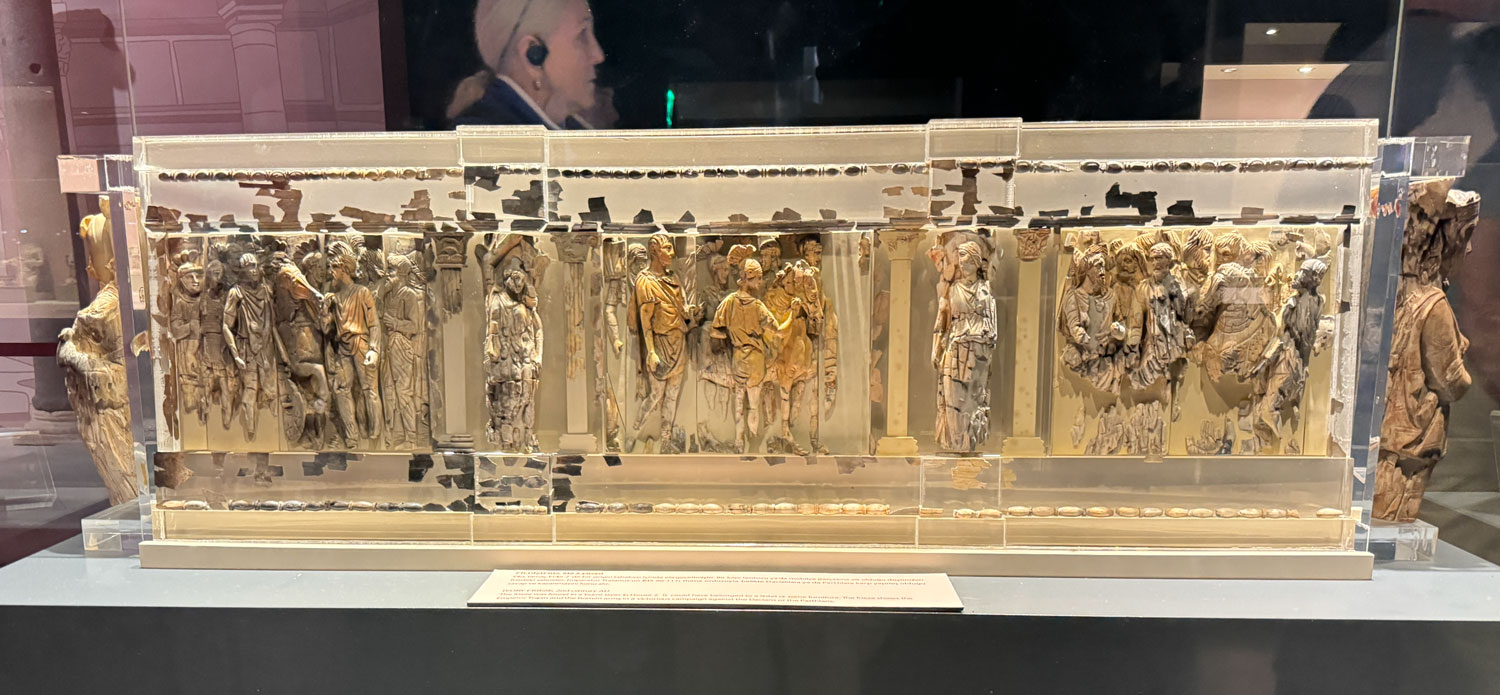
An Egyptian statue, demonstrating that there was trade between Egypt and Ephesus.
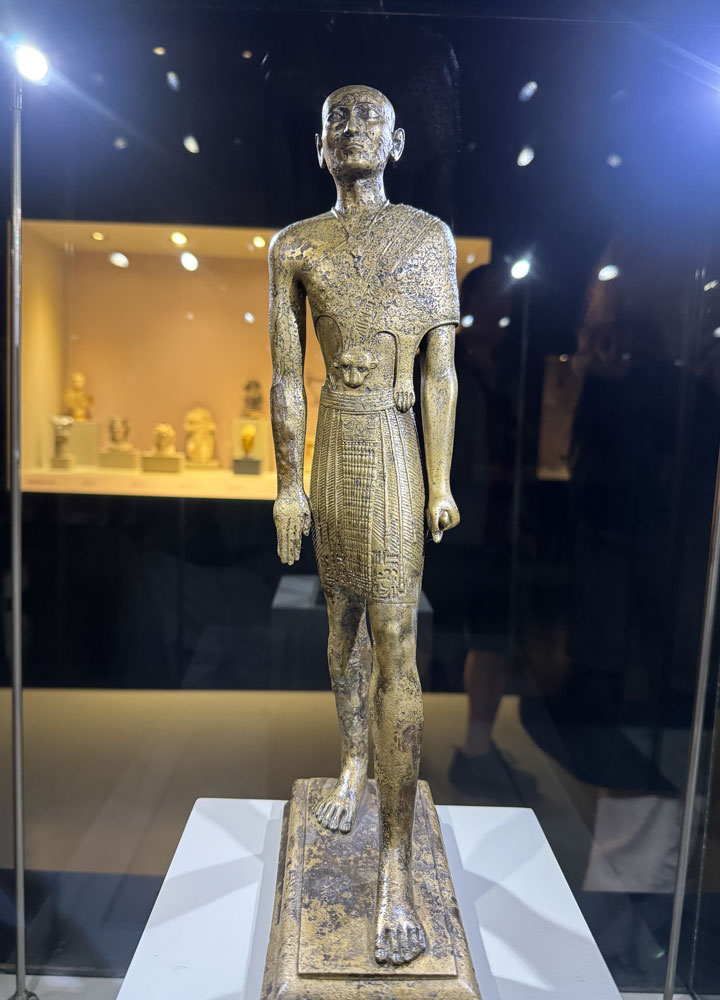
Bronze head of a man.
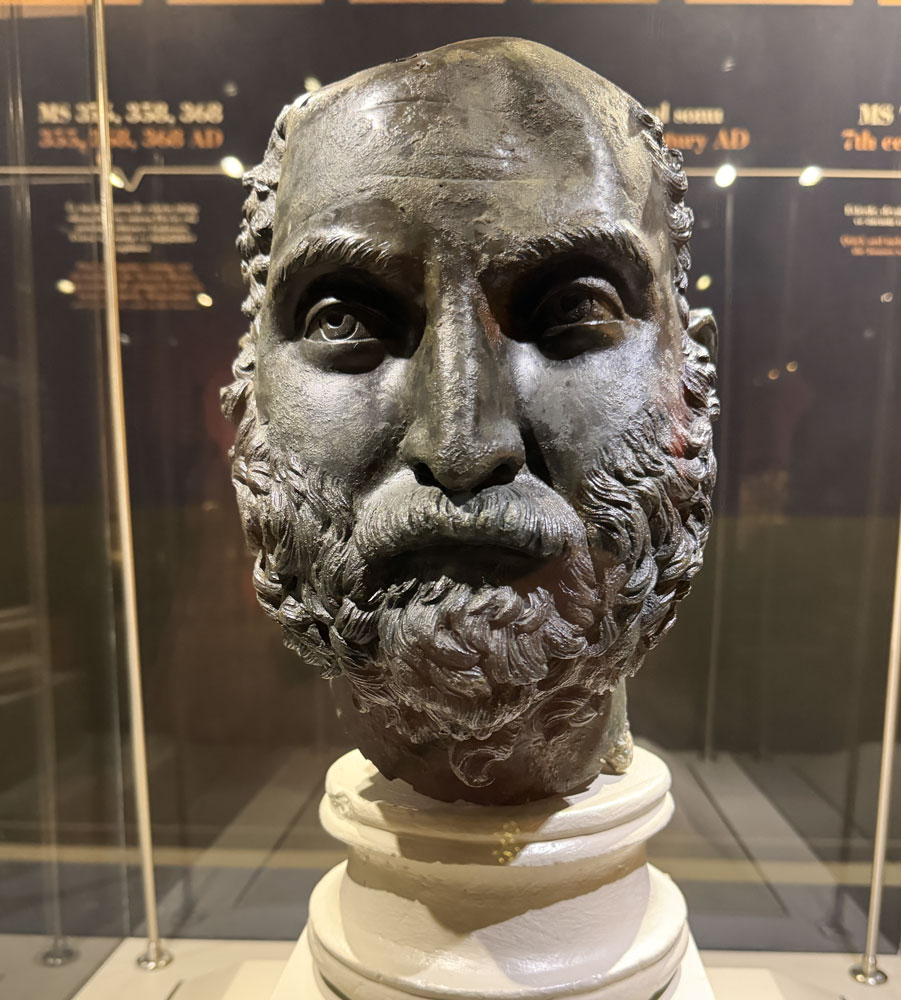
Model of a temple, but I didn't get the name of the temple.
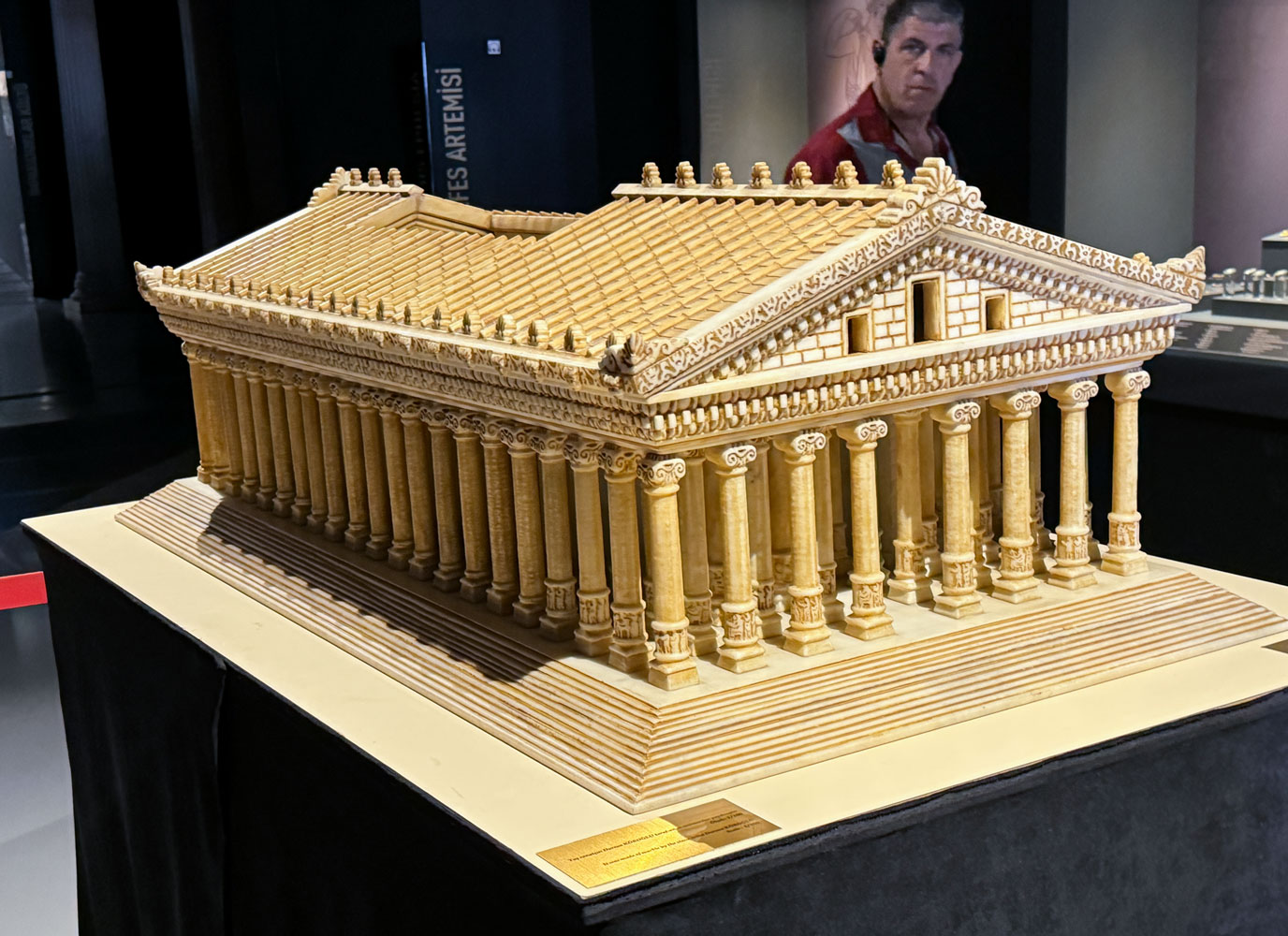
Some very finely crafted pieces of gold.
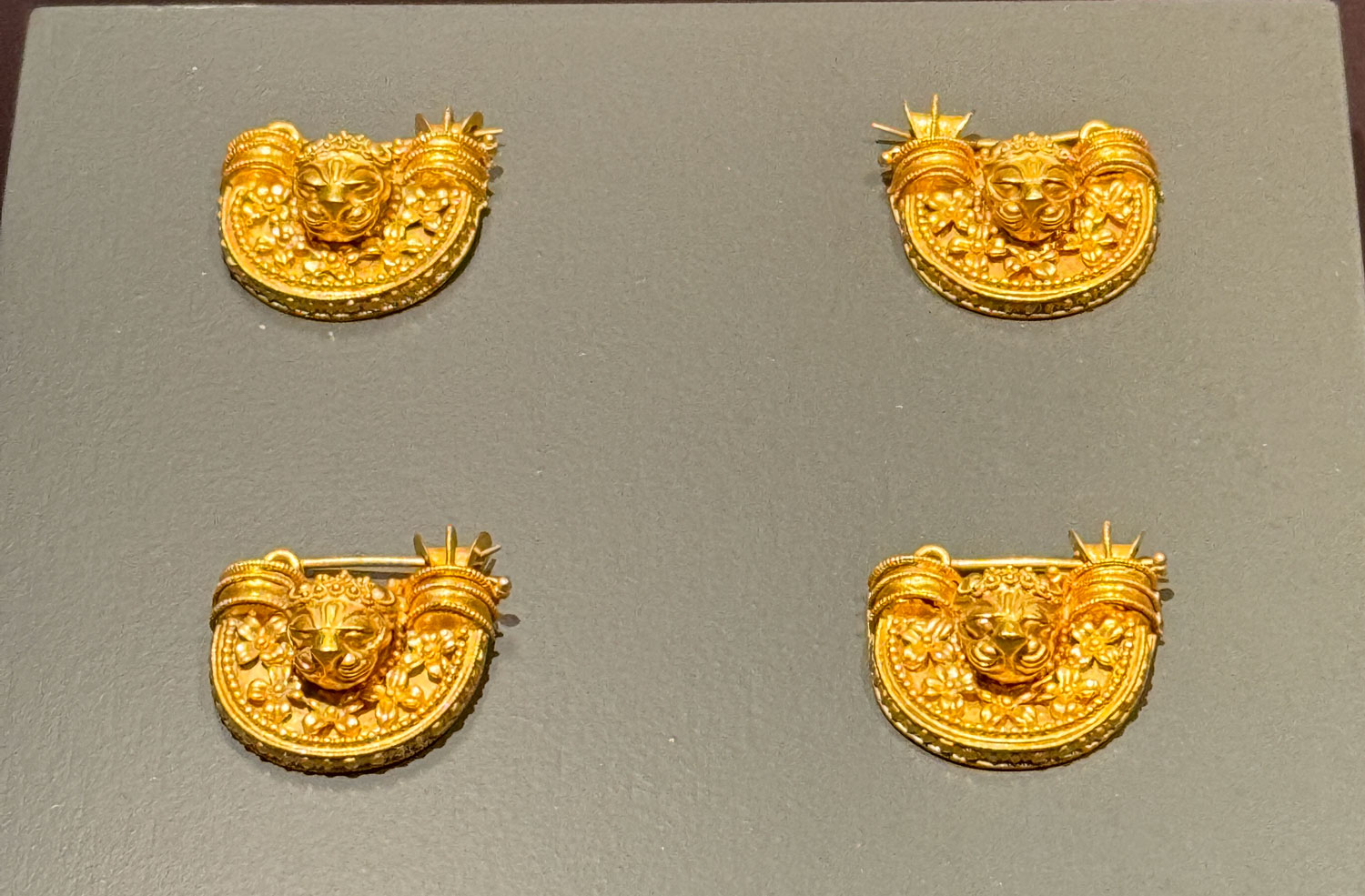
More gold.
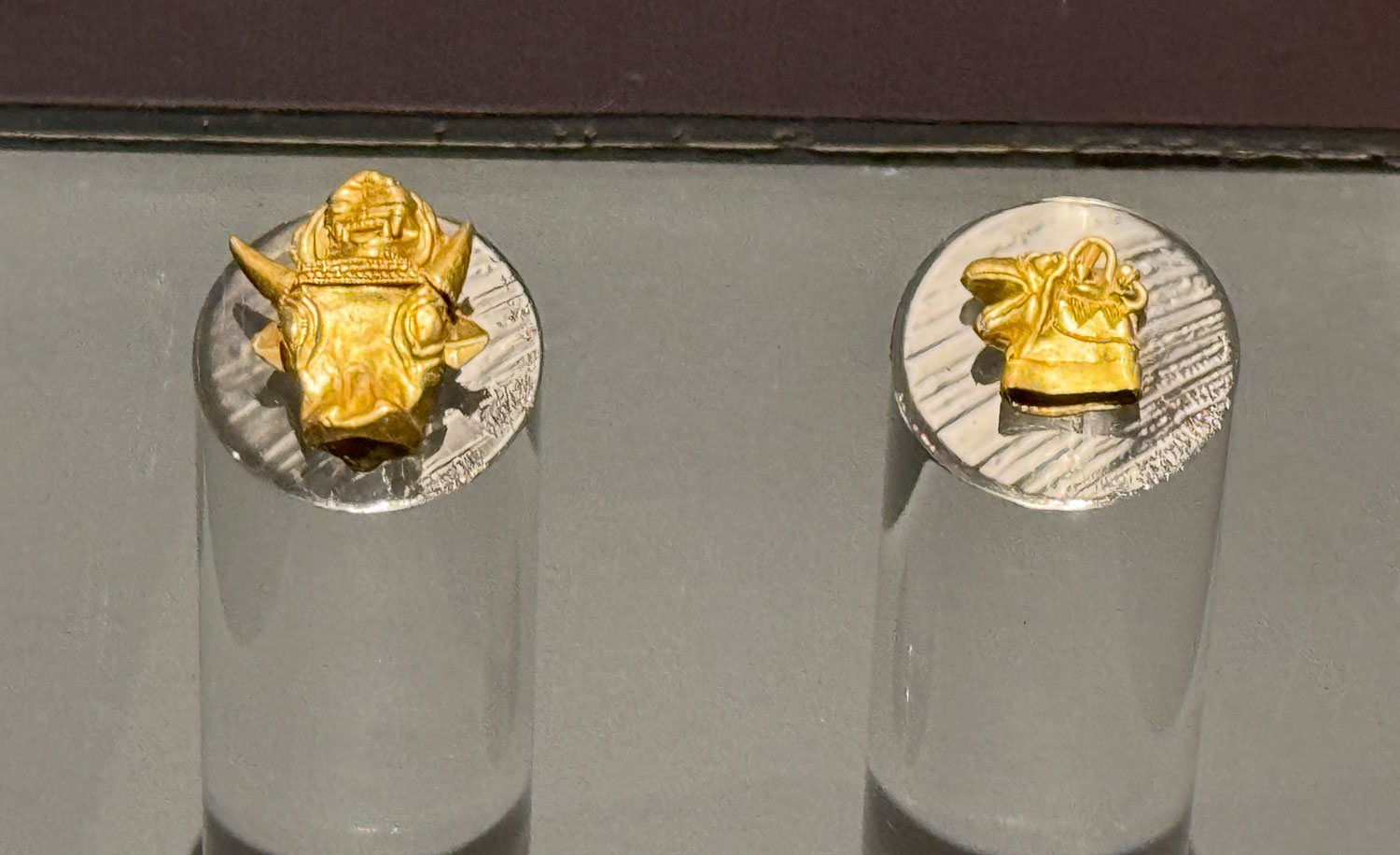
A smaller statue discovered in Ephesus.

When we left the museum, we went to the restaurant and rug place.
The gave us a demonstration of how rugs are woven (or tied). They had four weavers working in the demonstration area. Then they showed us how silk is extracted from the silkworm cocoons.
Then it was to lunch in this outdoor building. It was a nice lunch of Turkish dishes.
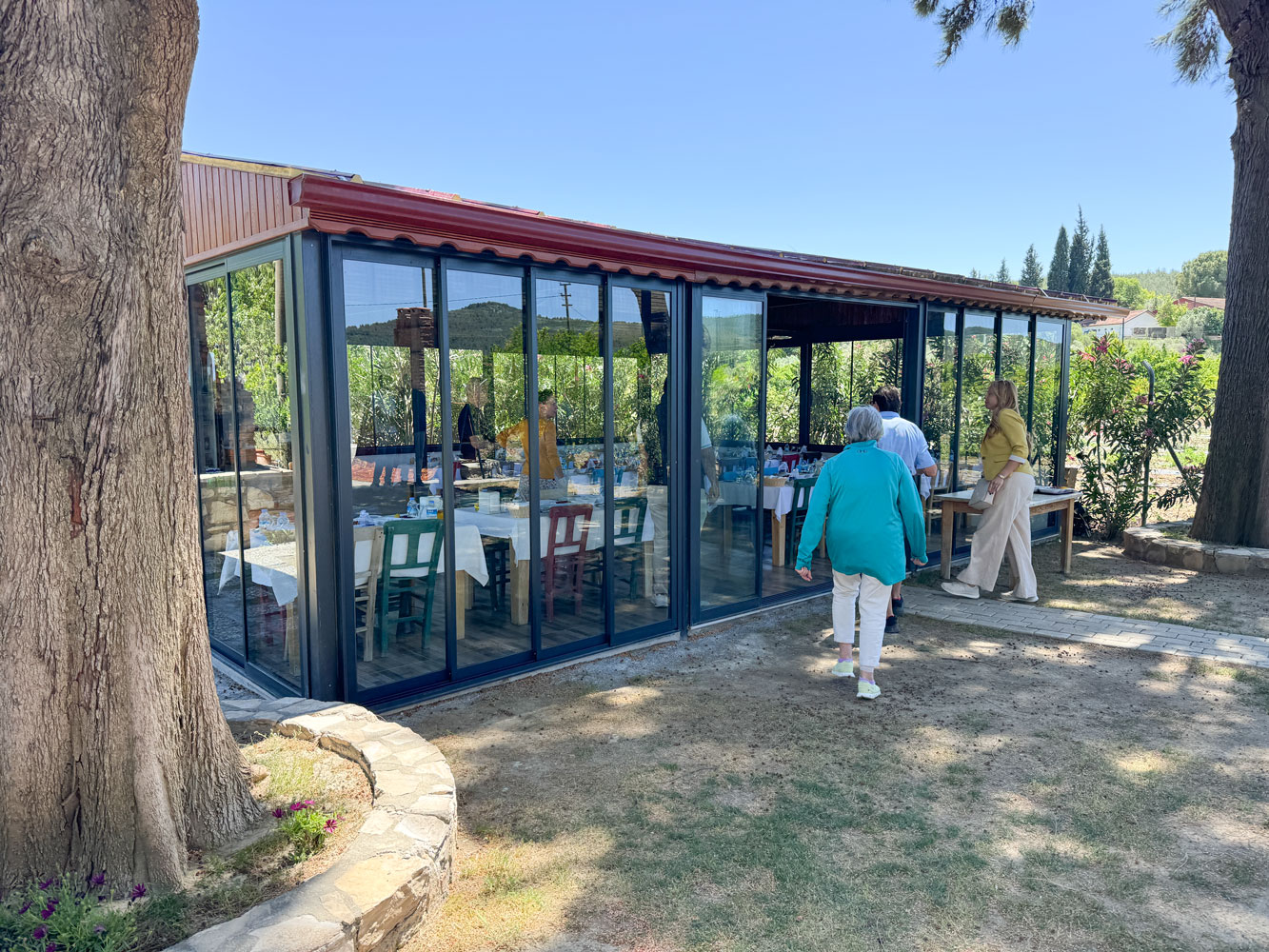

After lunch, I went and looked at rugs and found a smaller silk rug, signed by the weaver in Arabic script (hard to see in the picture, but at the bottom of the picture, in white script, in the red border). Judy liked it also, so we bought it. We signed the label on the back so that when it is delivered, we can confirm that it is the same rug. They'll deliver it in about six weeks.

Last time we were in Ephesus, we bought a similar rug that was still on the loom. They estimated it would take several months to finish it, but we never heard back from them. Once I pursued them, they claimed the weaver had become ill. But I think someone offered them a higher price for the rug so they sold it to that person.
They did refund our money.
After that, we went into the presentation room and watched as the rug merchant and his helpers displayed rugs to the Tauck people.
There seems to be a protocol for a display of rugs. First, you are offered some refreshments. Then the rug merchant tells you that his merchandise is so much better than other rug merchants and how honest he is (he may or may not be honest in everything, but you *will* get your rug).
[Update 6/11/2024: The rug people showed up with our rug today. He had a good sized panel truck with many rugs in it. I think he's going up the coast of California delivering rugs. He mentioned that he's headed to San Francisco.
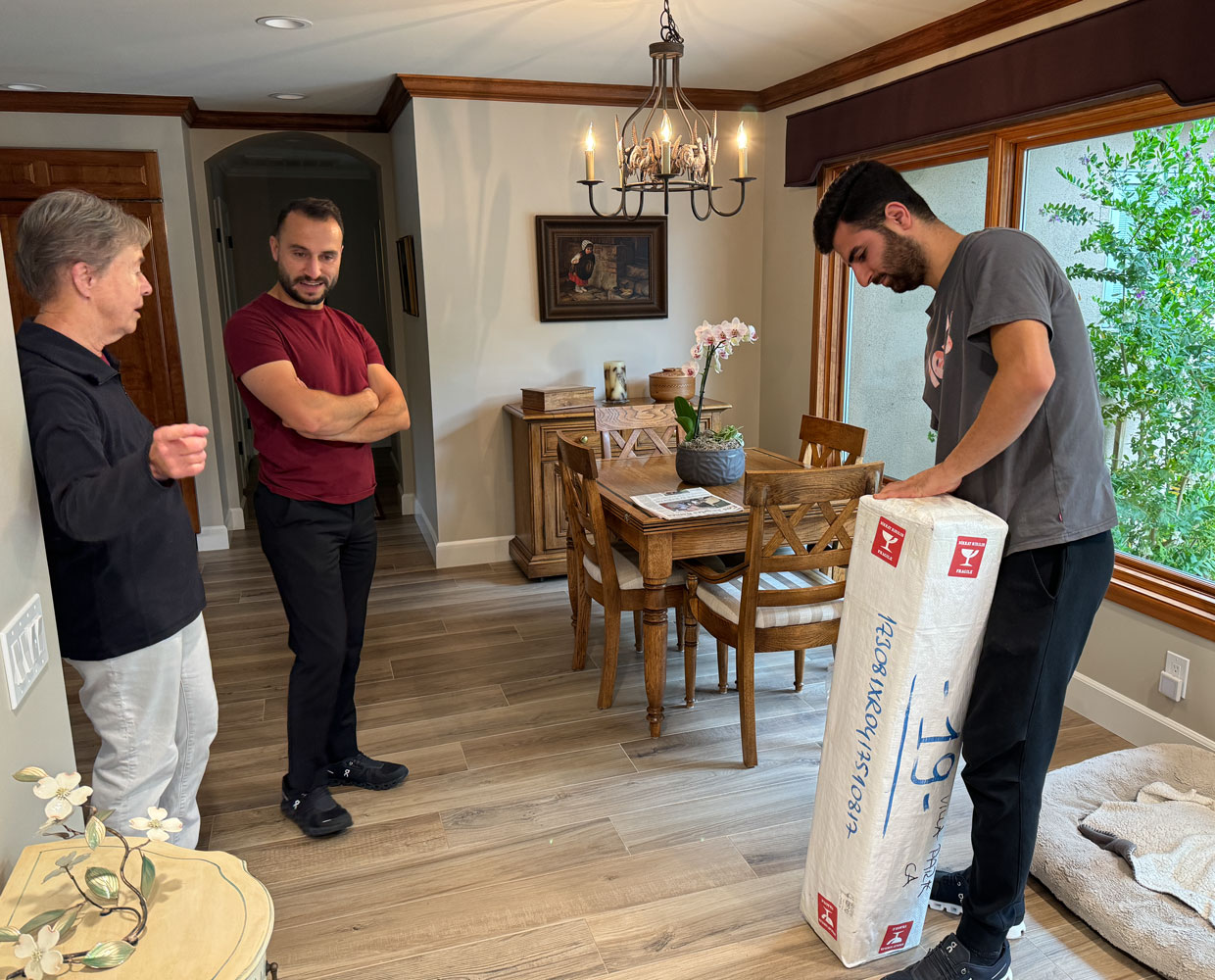
Here's the rug we bought. It's in perfect shape.
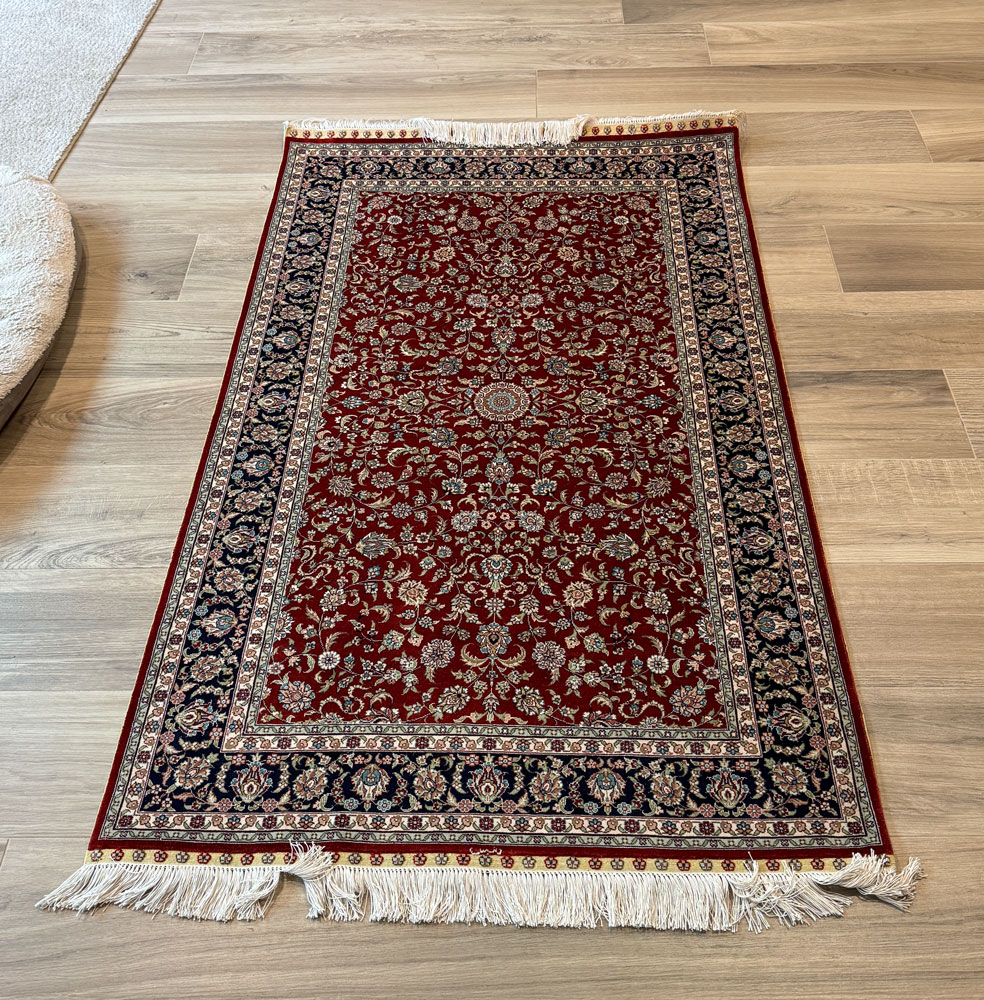
He brought in other rugs that he had and talked us into buying another one of the same size - a silk rug, about 3 feet by 5 feet, and signed by the weaver. Her signature is at the middle top of the rug in this picture. I don't think this picture captured the beauty of this rug. Judy and I both preferred it to the other one we bought. I'm just amazed that a weaver can create the detail that is in these rugs. Silk rugs have much finer detail than wool rugs - there are many more knots per inch in a silk rug, but that means a lot of work went into the rug.
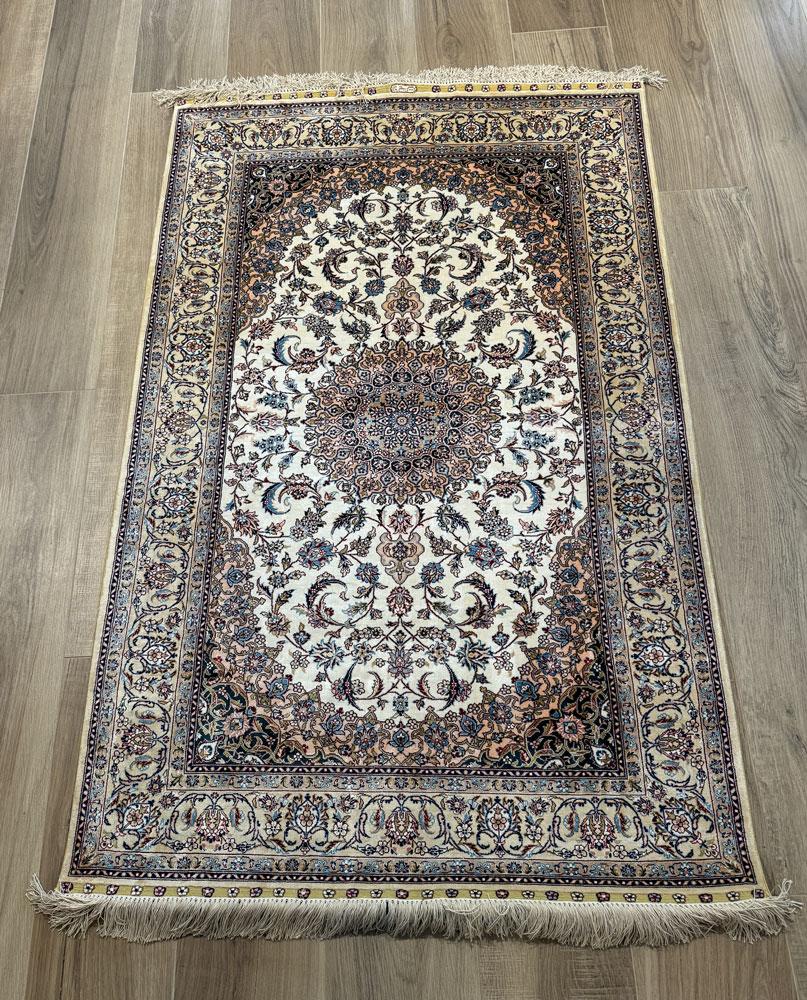
But we still don't have the rugs. We are having the rug guy sew a special type of strip on the back so we can hang the rugs instead of putting them on the floor. He estimated that we'll get the rugs back in July.
Update: We did get them back and have the second rug hanging in our hallway.
End of update.]
Next, they begin laying out rugs, starting with the largest and most expensive. If no one bites, they move to smaller and less expensive rugs. The workers really hustle when doing this, displaying a rug, rolling up earlier displayed rugs, etc. It's a well-choreographed display, and well done.
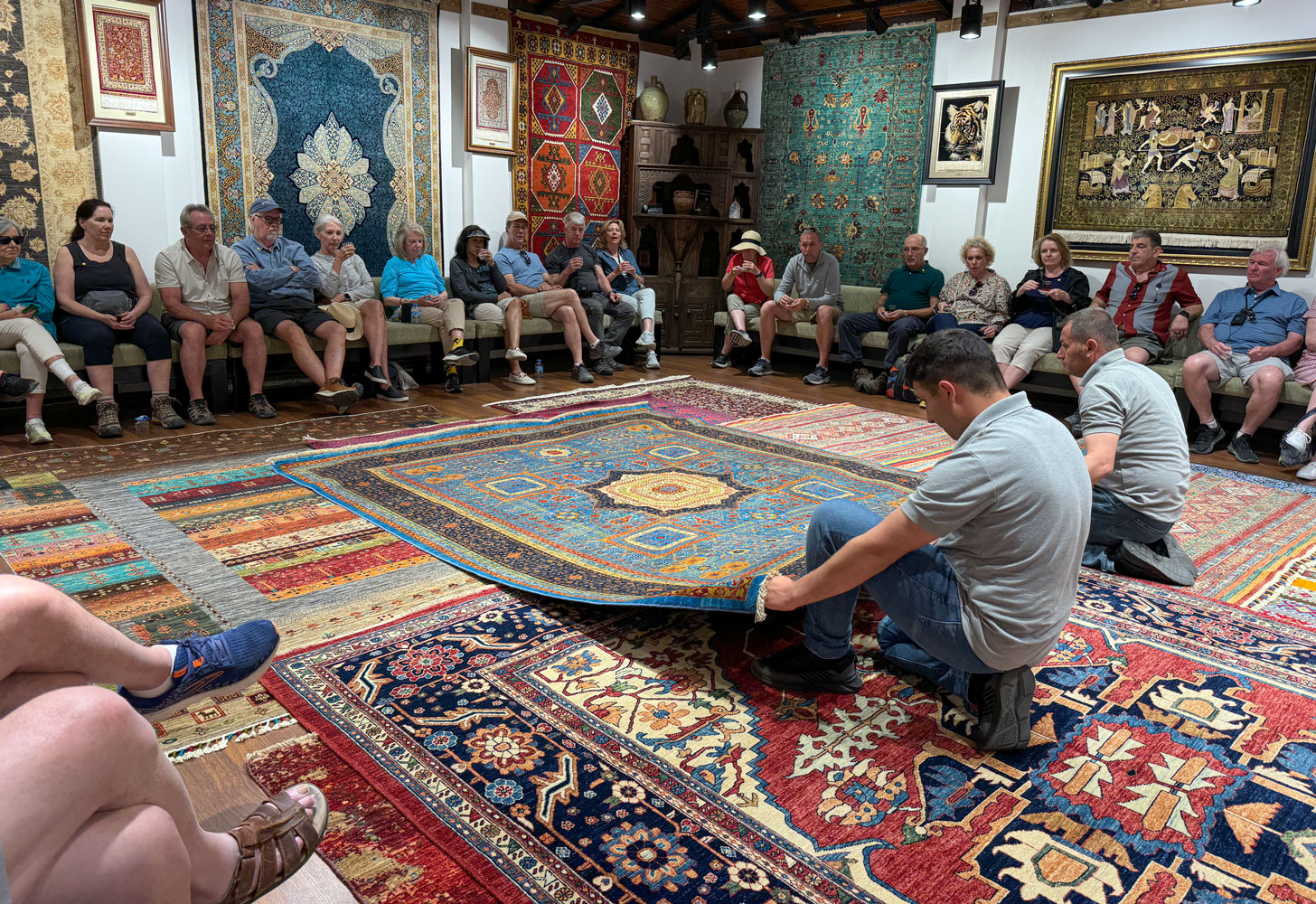
A few people purchased rugs.
Then we went back to the ship. This evening, we'll return to Ephesus for dinner at the Library.
We departed the ship about 7pm for the half hour ride to Ephesus. When we arrived at the Library, there were six waiters each with a tray of glasses of wine for us.
Here's Judy arriving and with a glass of wine.
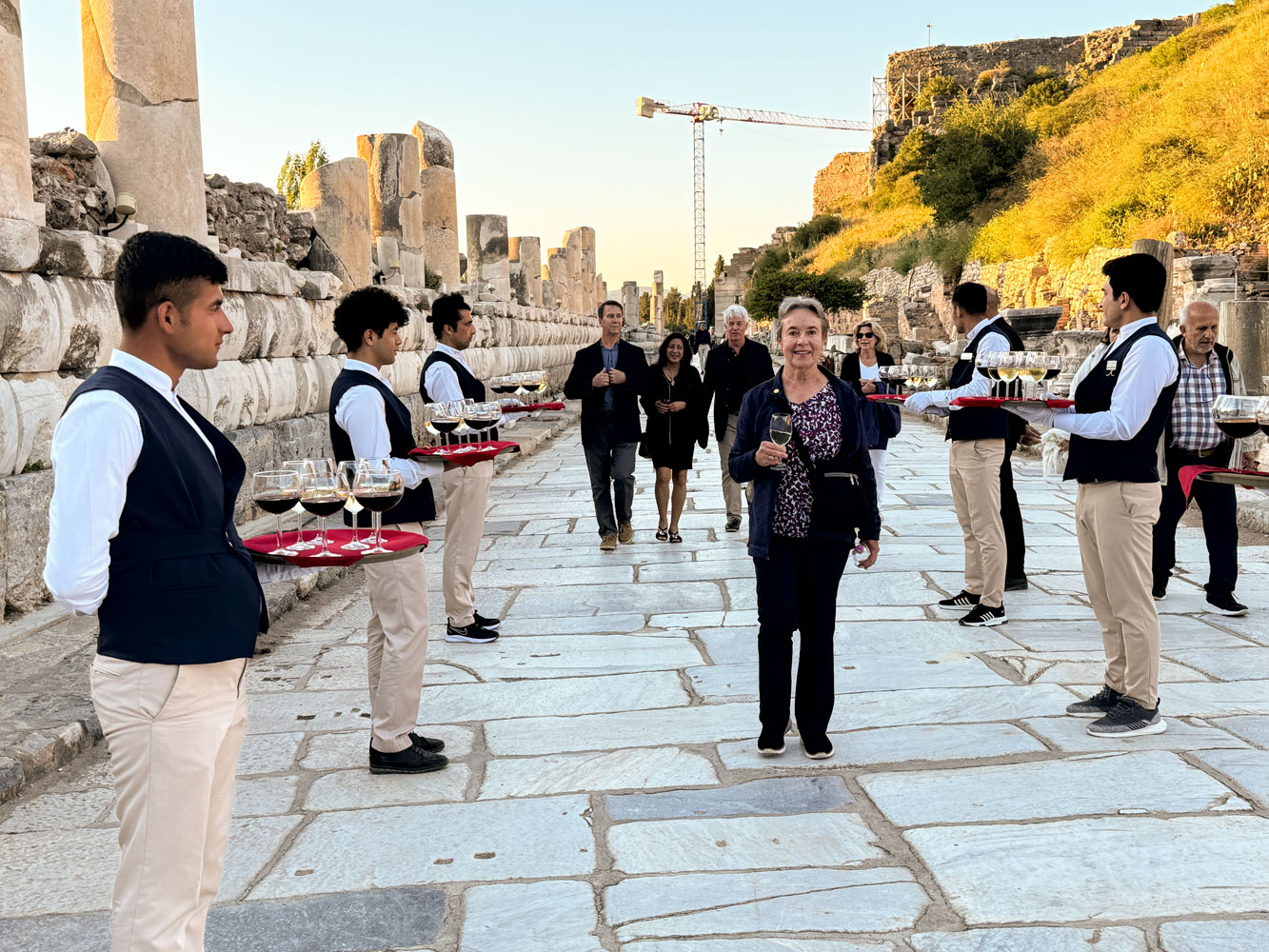
Windstar had hired a professional photographer, and he took this picture of us as we arrived. He AirDropped the picture to me, but most other guests got their picture on paper back at the ship. It was really nice to get the pictures from the professional photographer in digital form. If I get them in paper, I generally have to wait until we get home and I can scan them. Also, the process of making the paper copy and then scanning that copy degrades the image.

A trio played as we arrived.
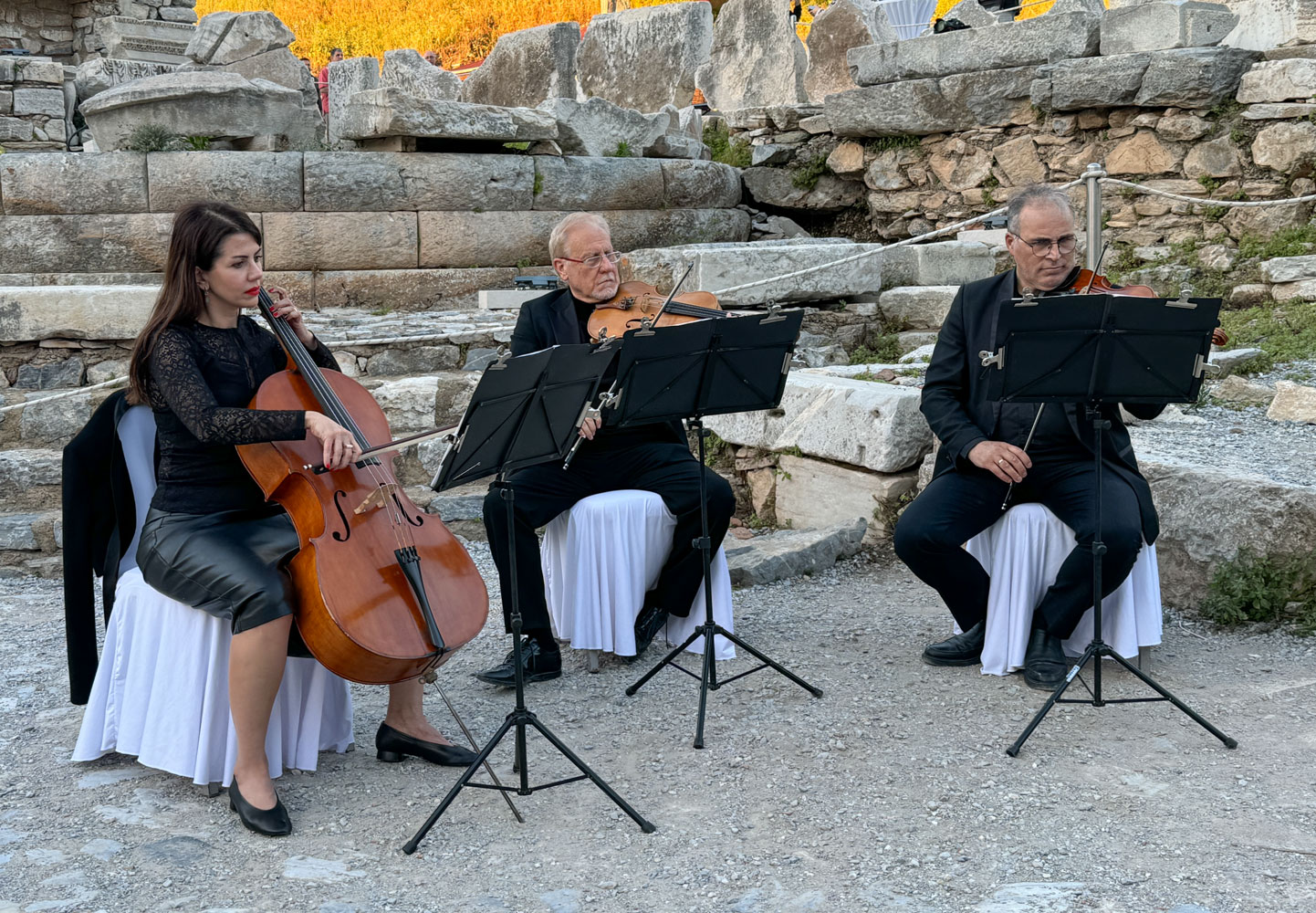
The tables were set in front of the Library. In situations like this, I often think of the amount of work that goes into presenting something like this. The tables and chairs have to be brought in, the food prepared and transported, and a wait staff recruited and trained. There's a lot to do.
This picture was taken from the steps of the Library.
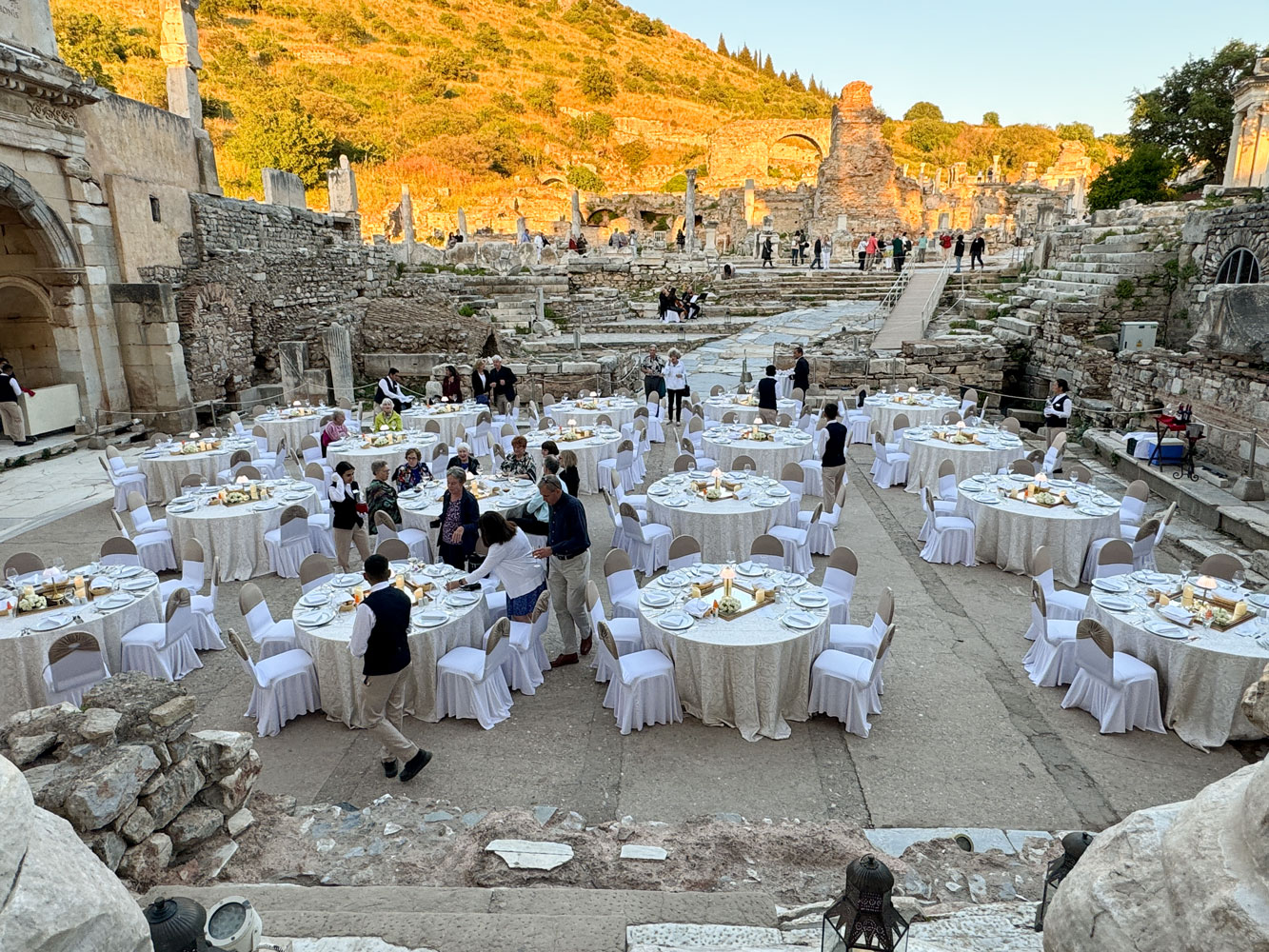
A view in the other direction, looking towards the Library.
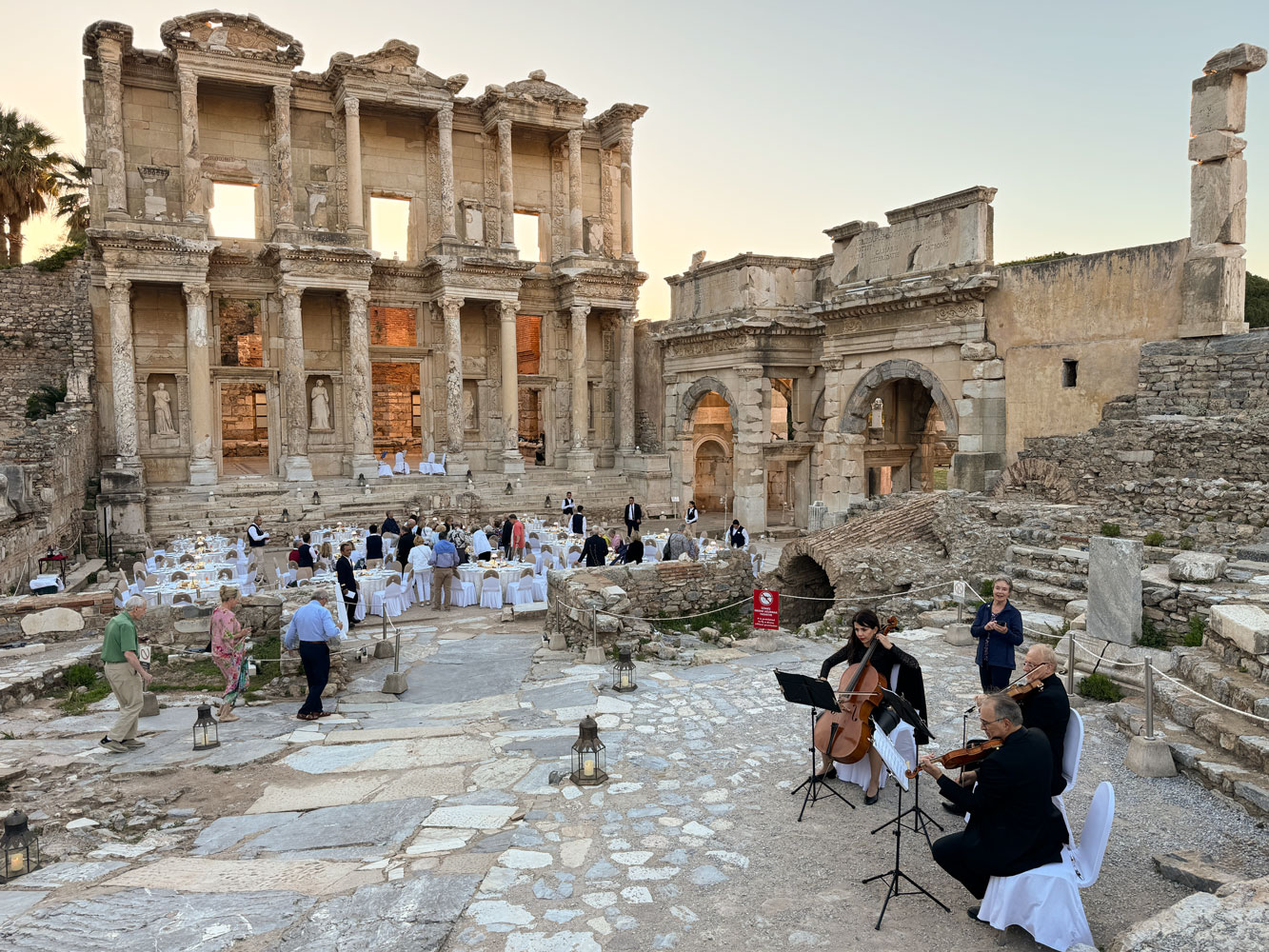
The Library from our table.
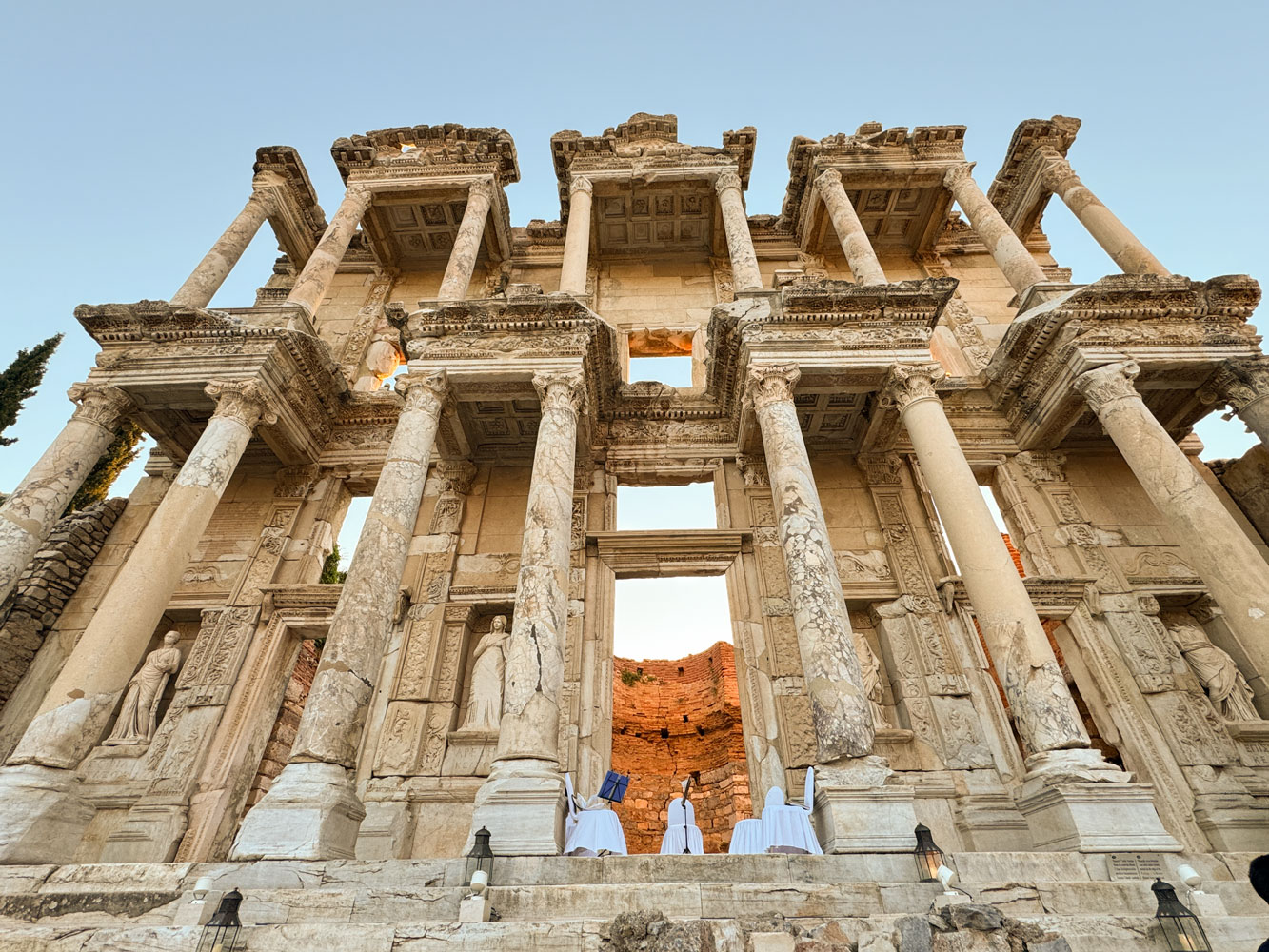
A local guide came and gave a short talk before the dinner was served.
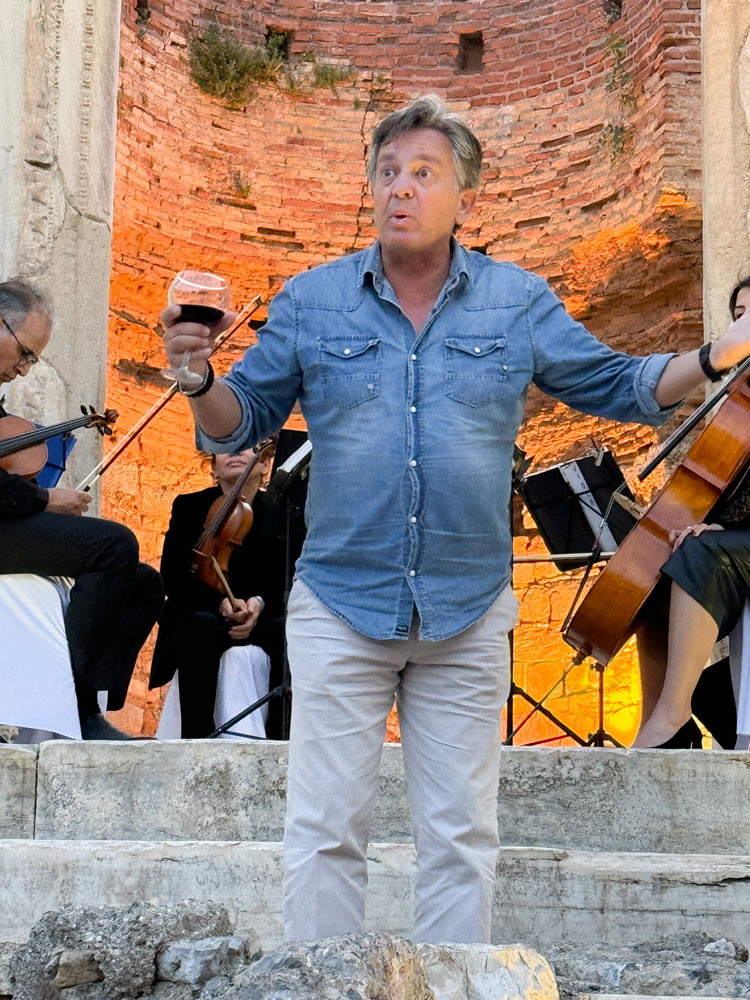
Six musicians played throughout the dinner. You can only see three in this picture. The other three were behind the columns. You can see the face of one of the musicians behind the left column.

A view of the Library after dark.
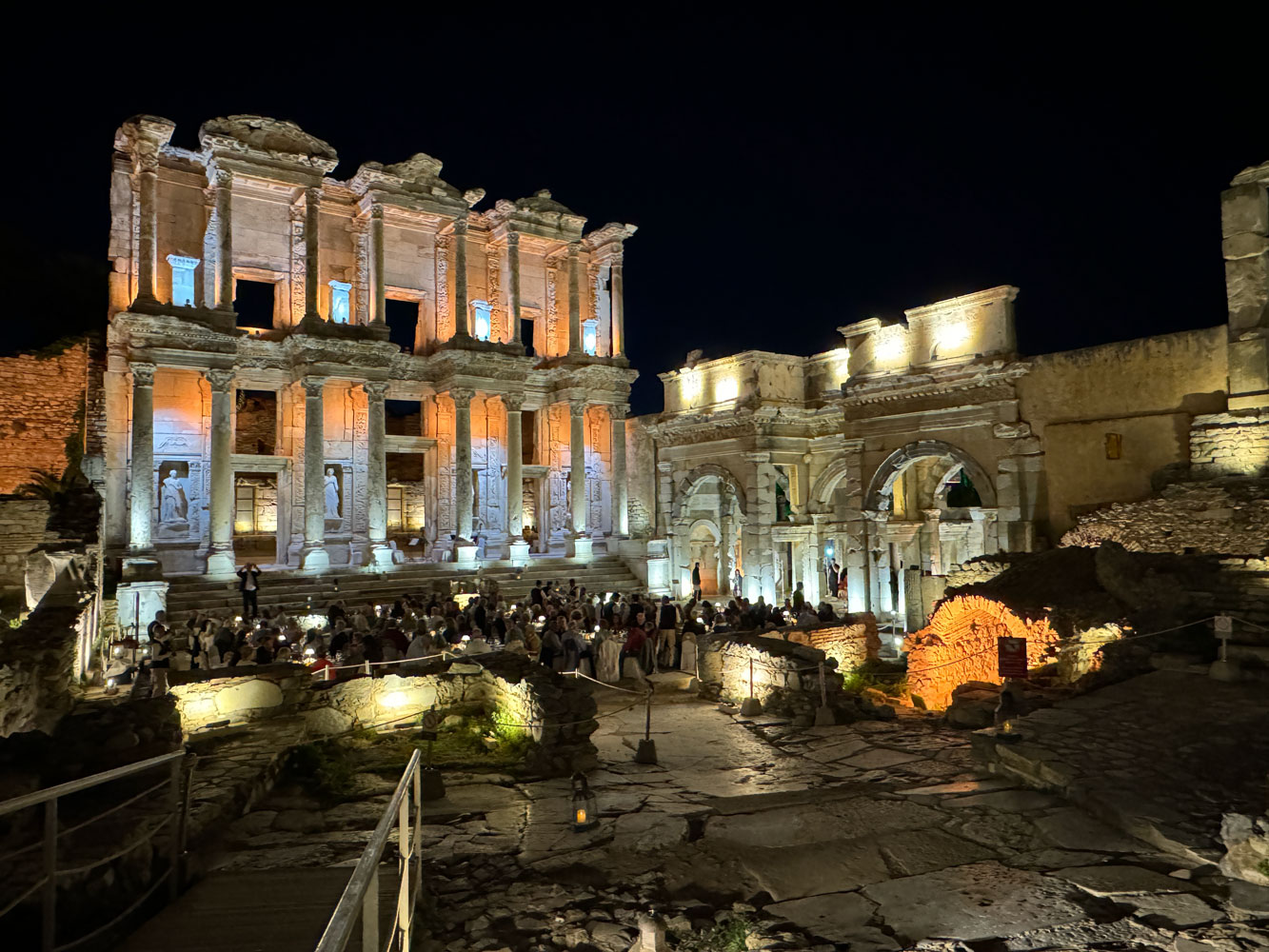
A better view of the guests.
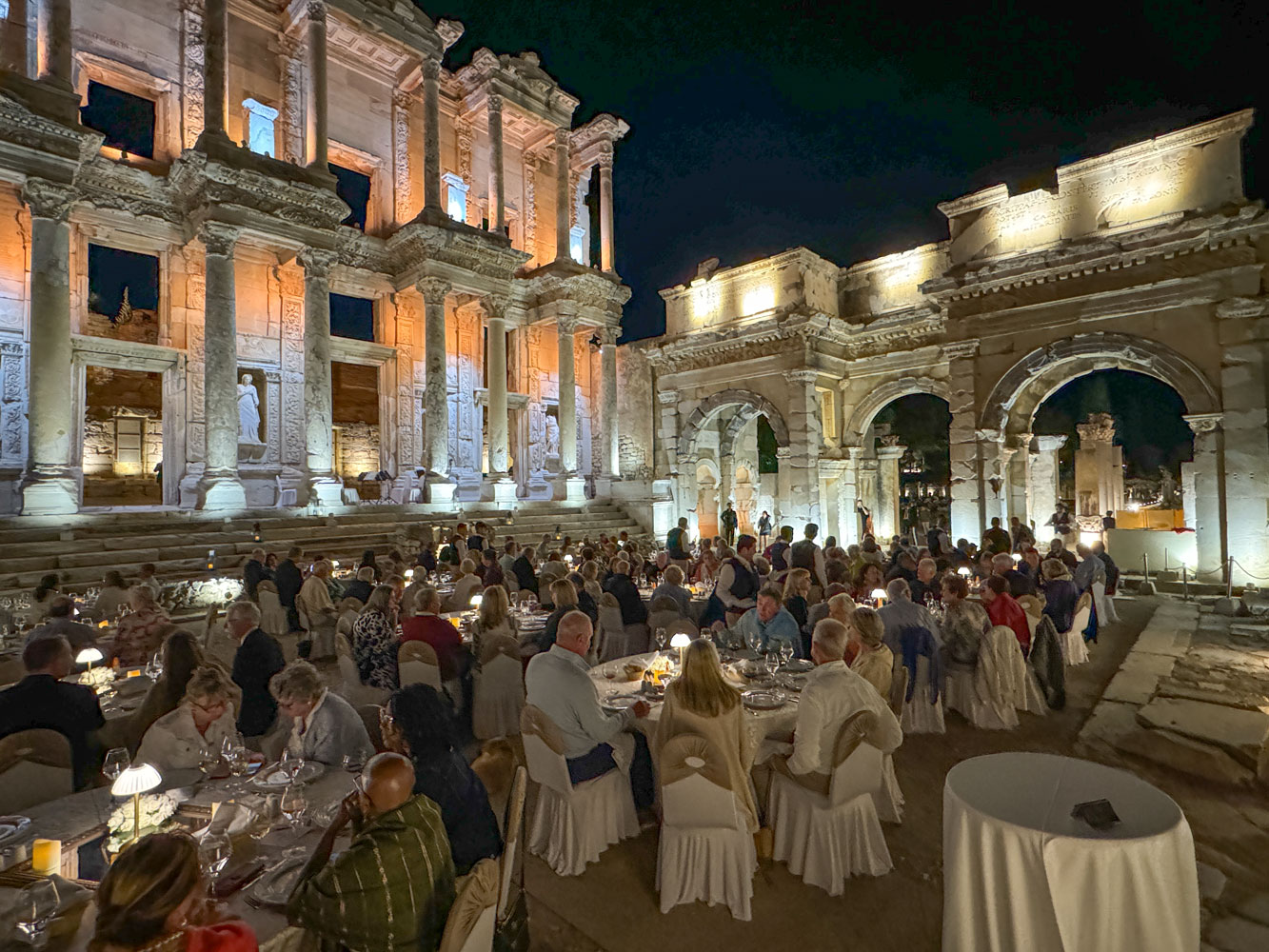
Guests departing the Library. Judy and I took a moment to go "backstage" to compliment and thank the musicians.

The musicians eventually walked out just ahead of us. They had a long walk to the parking lot, and I didn't envy the cellist. Music, folding stands, and the cello.
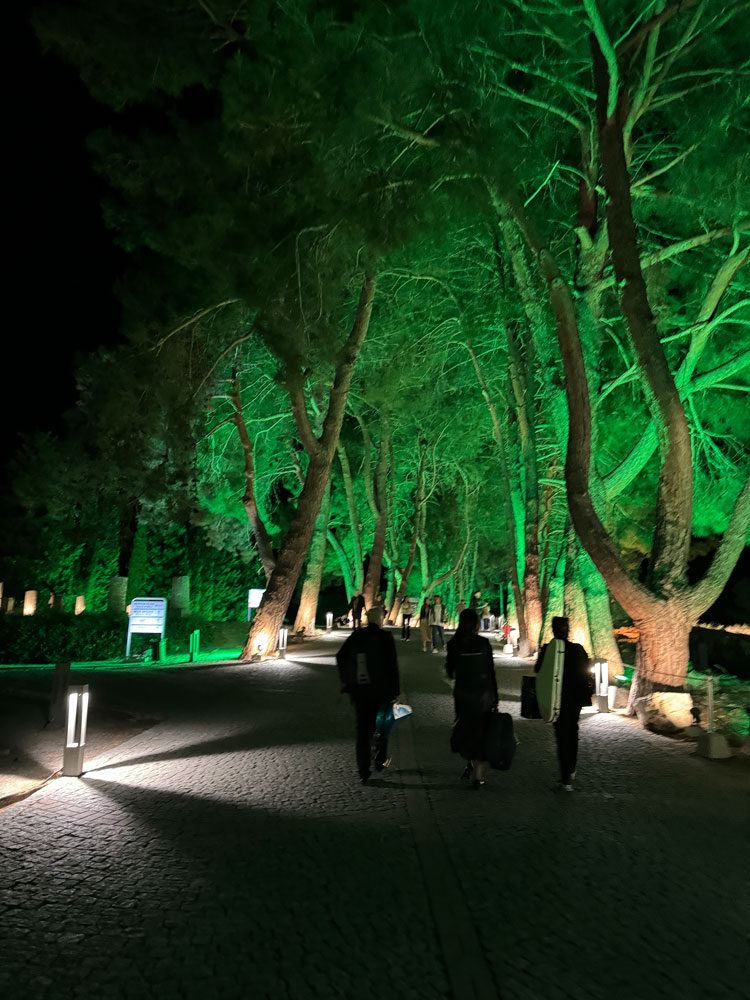
When we got back to the port, our ship was waiting for us.
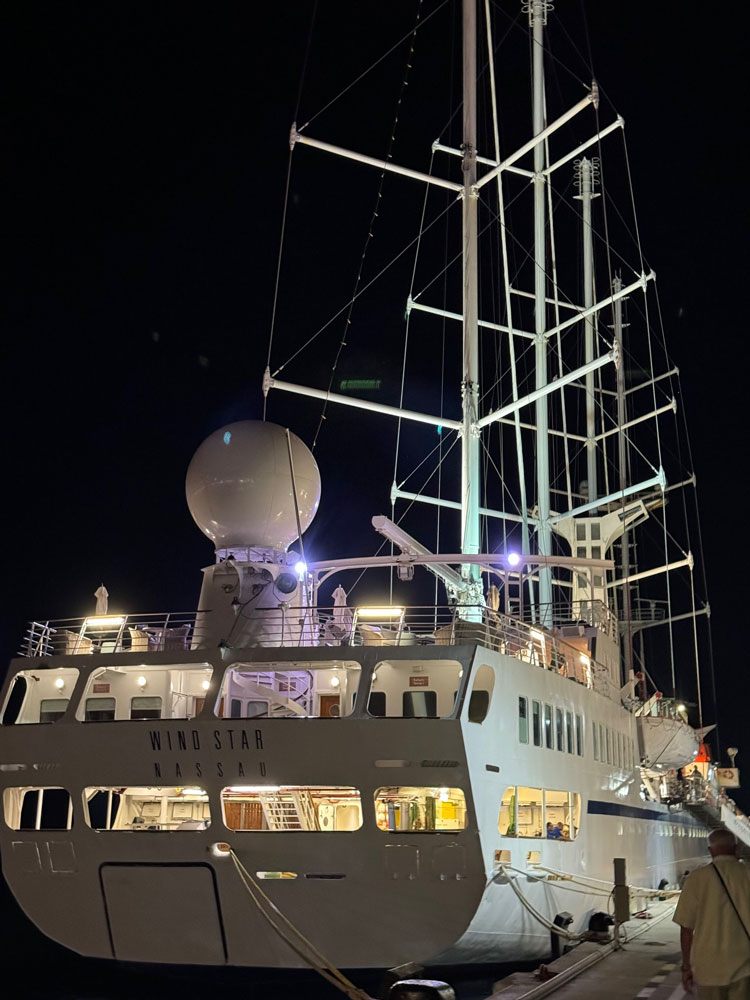
And the crew was lined up welcoming us back. It was a lively welcome.
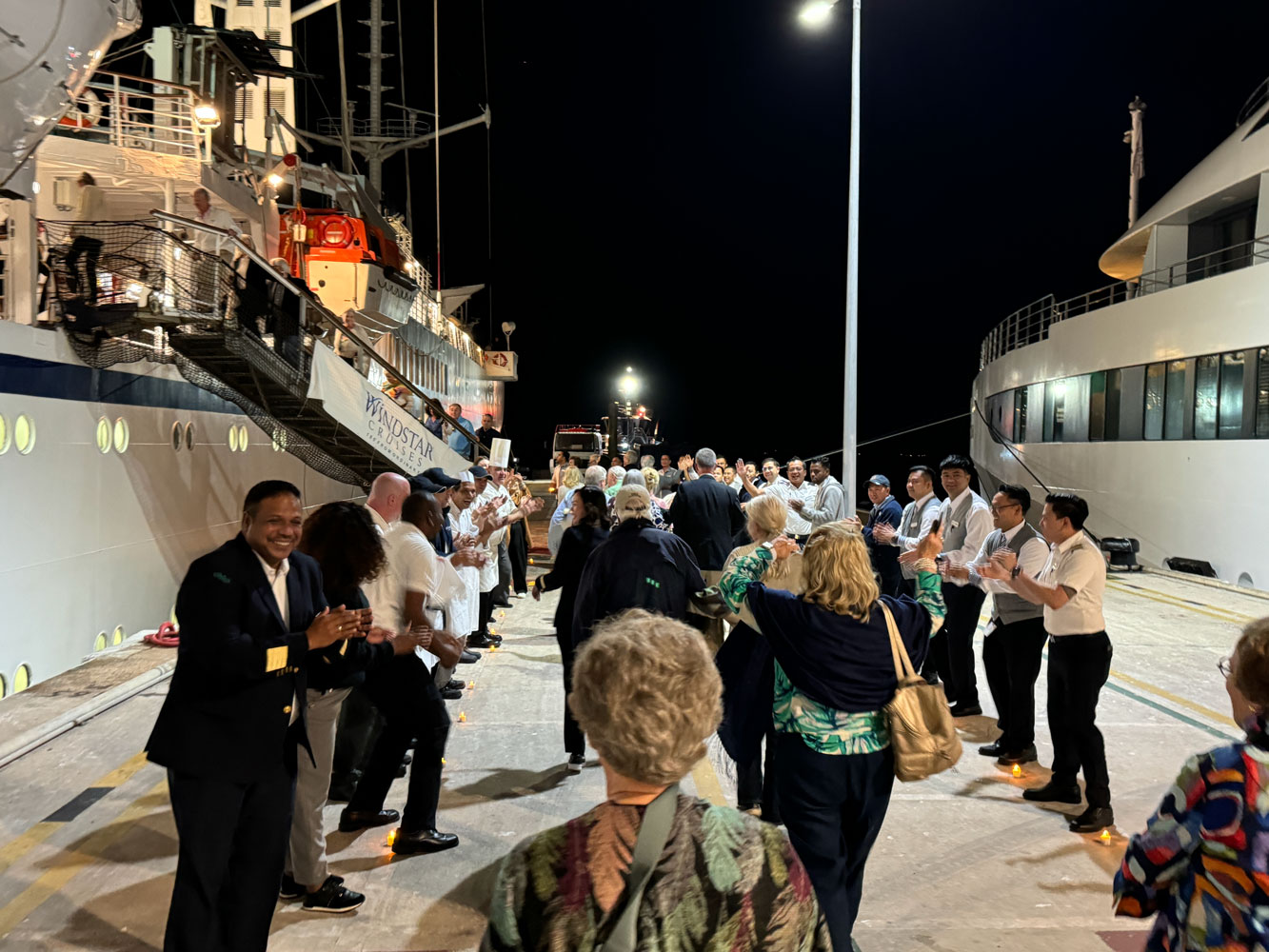
This event was probably the highlight of the cruise, and is something that a big ship could not do unless they limited the number of guests on the "excursion". The area in front of the Library is only big enough for maybe 150 people.
It was now fairly late and we went directly to bed about 11pm.
+++++++++++++++++++++++++++++++++++++++++++++
May 7, 2024 (Tuesday) We arrived in Patmos this morning and tendered in to the port. Perhaps the greatest claim to fame for Patmos is that John wrote the Book of Revelation in Patmos. There are some questions about who John was. He could have been John the Apostle, or John the Presbyter.
After breakfast in our room, we met the group in the restaurant and embarked the tender about 8am.
As we rode the tender in, we could see the Castle of Patmos, or as it is more formally known, the Monastery of Saint John the Theologian.
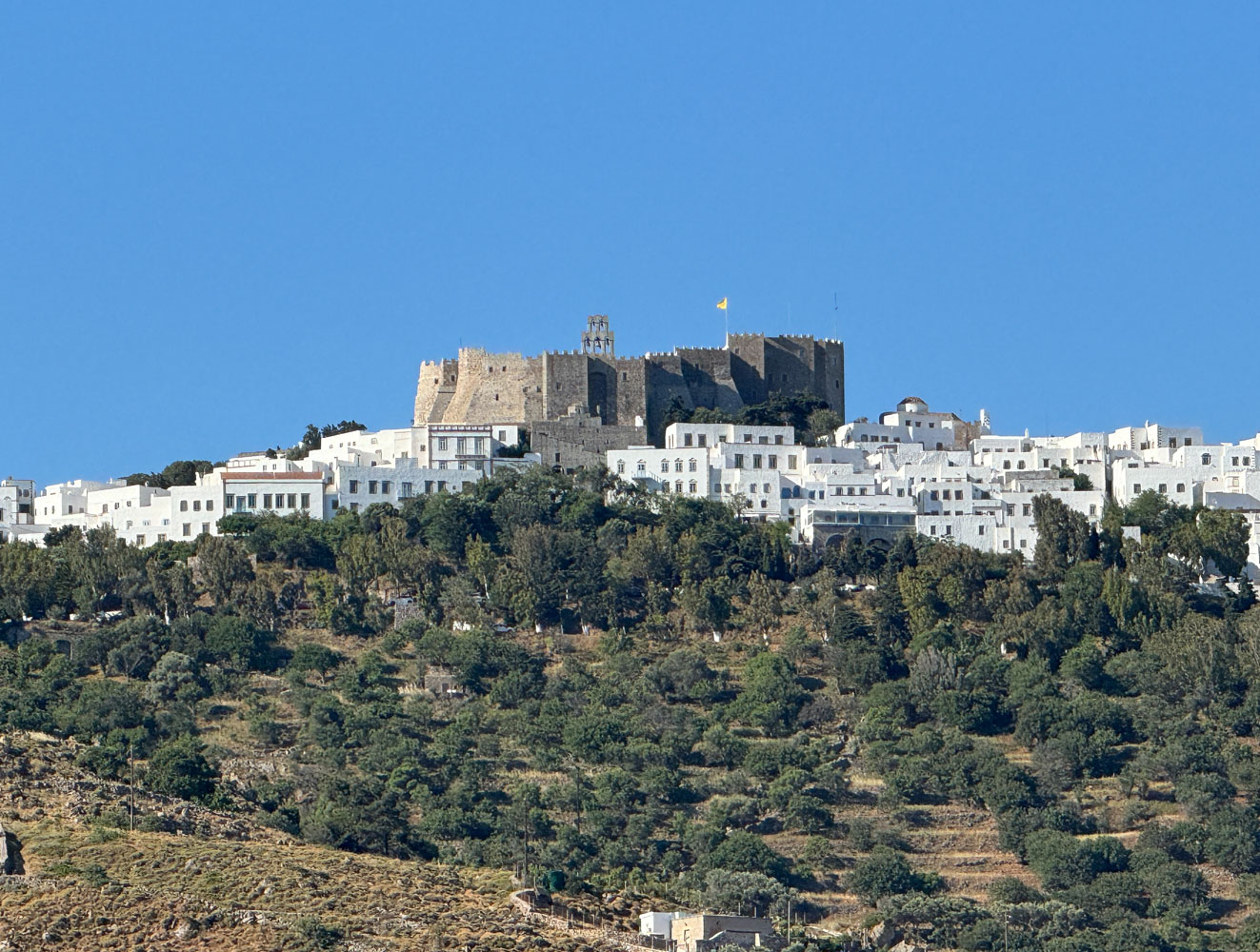
We signed up for the photography tour, and there were only five guests on that tour. Here we are boarding a small bus for that tour.
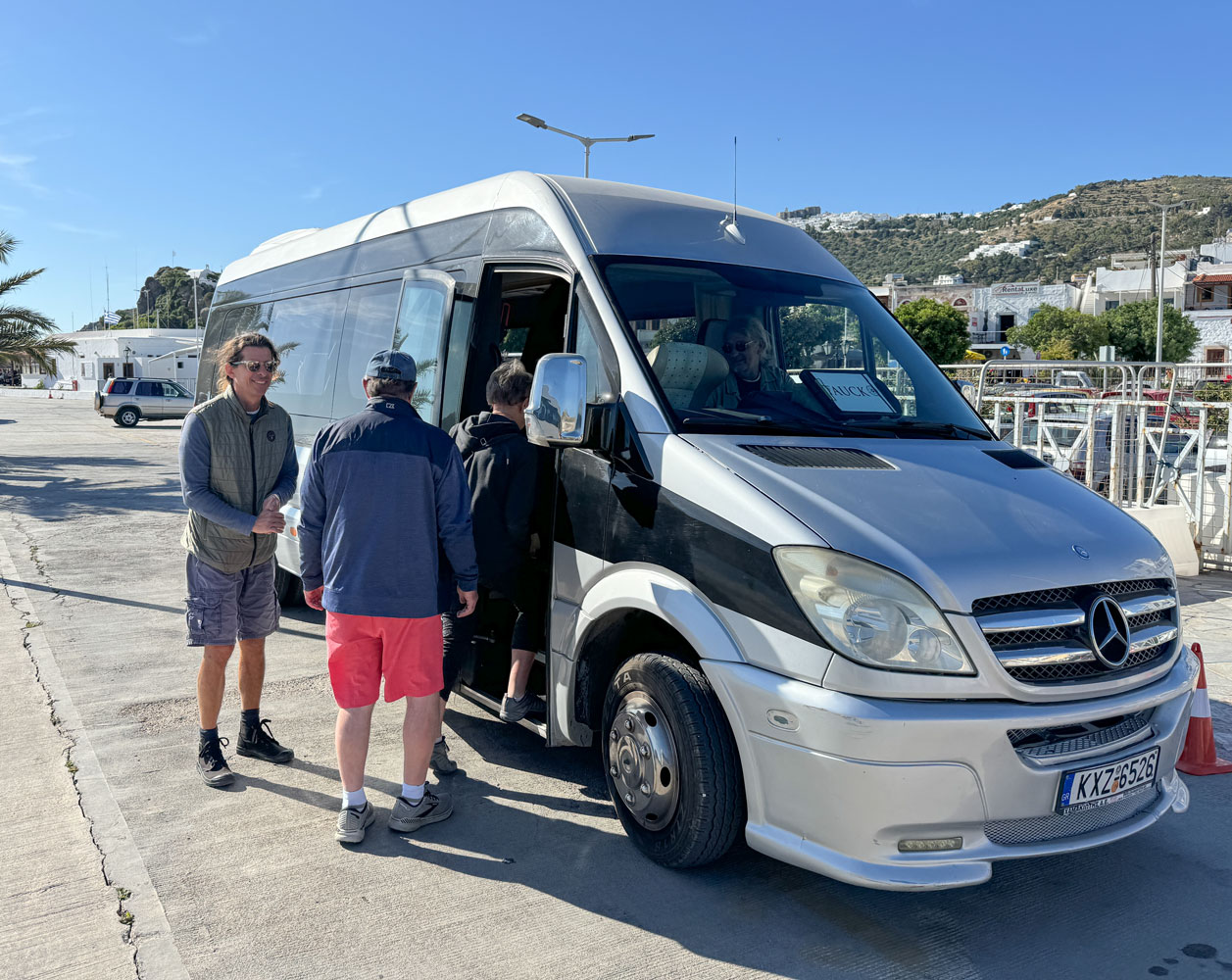
Our guide for the tour, Antonis Dimas. I was concerned that the tour would be about a lot of technical things about photography, with guests that have those expensive SLR cameras, but it wasn't like that at all. Everyone had iPhones and Antonis did not talk about the technical aspects of photography - he just took us to places where we could take pictures, spots that larger buses can't access. I'd recommend this tour to anyone.
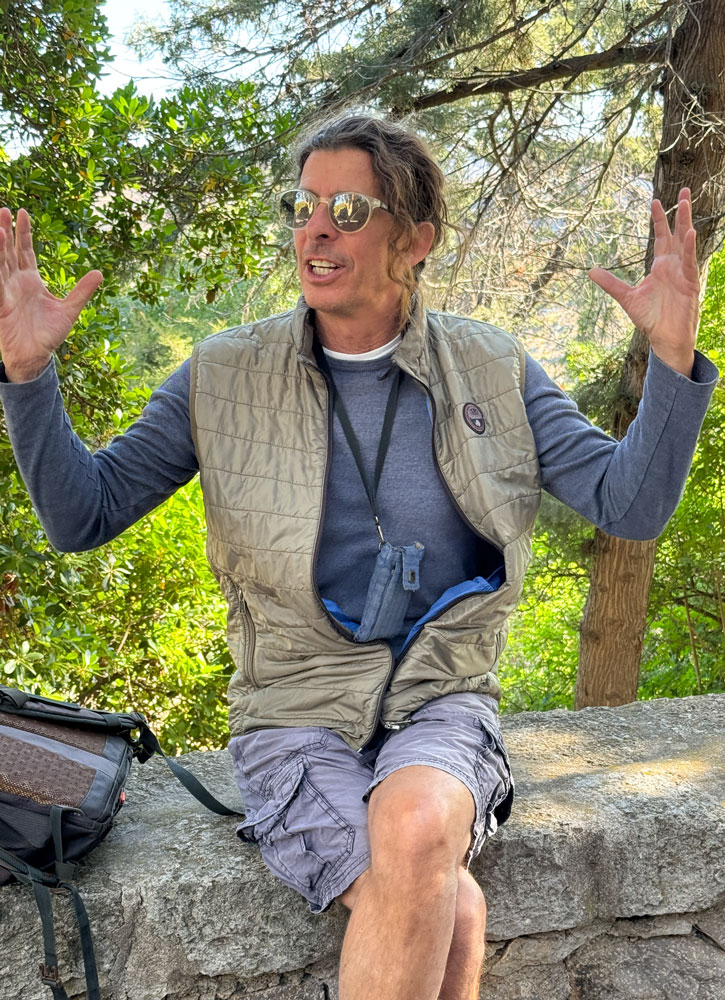
The first place we went was to the Cave of the Apocalypse. Here's a mosaic above one of the doors.
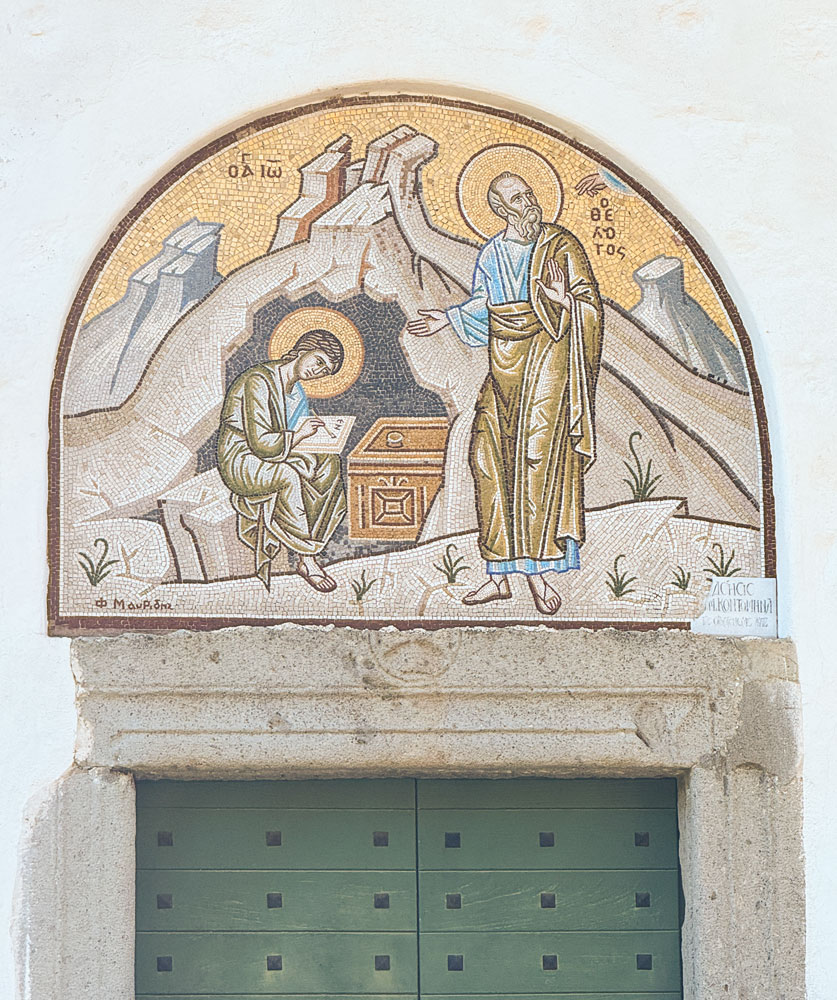
We went to a patio where we could see the city.
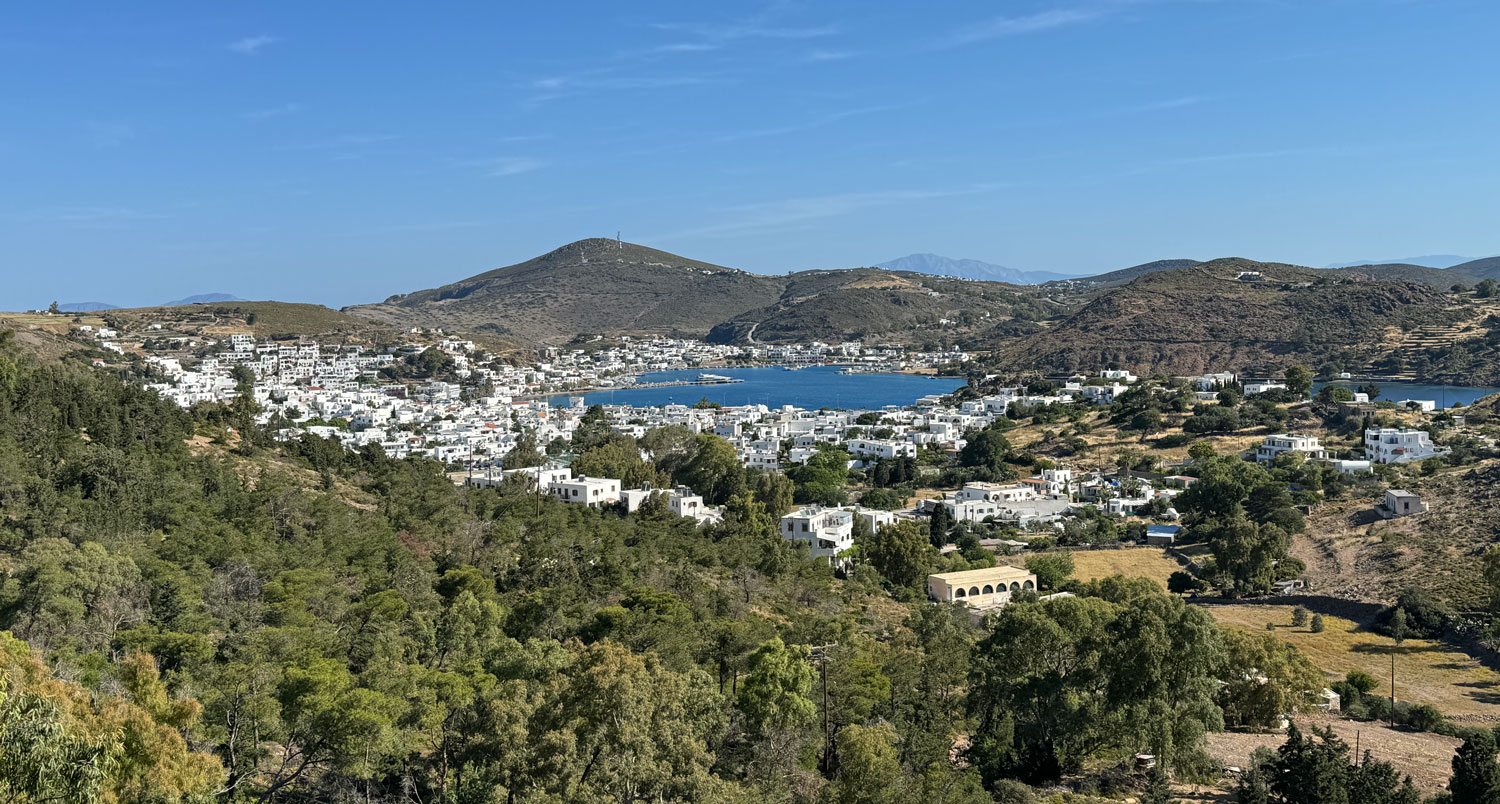
We stopped by the three Windmills of Patmos. Two of these windmills were built in 1588.
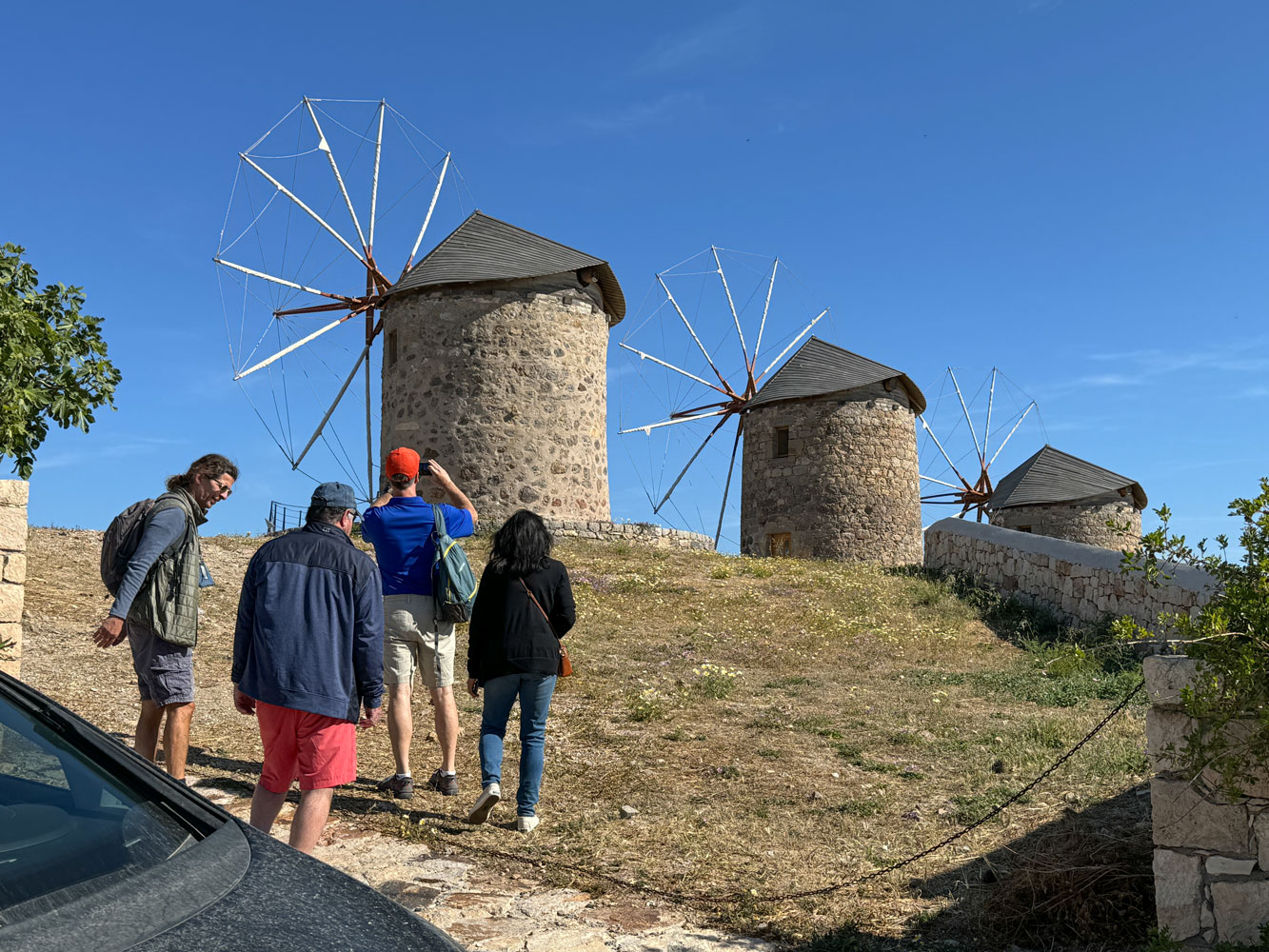
Antonis took a picture of Judy and me seated on a bench, looking out at the city. That was a good photography lesson - the subjects don't always have to be looking at the camera.

In a different direction we had a view of the Monastery.
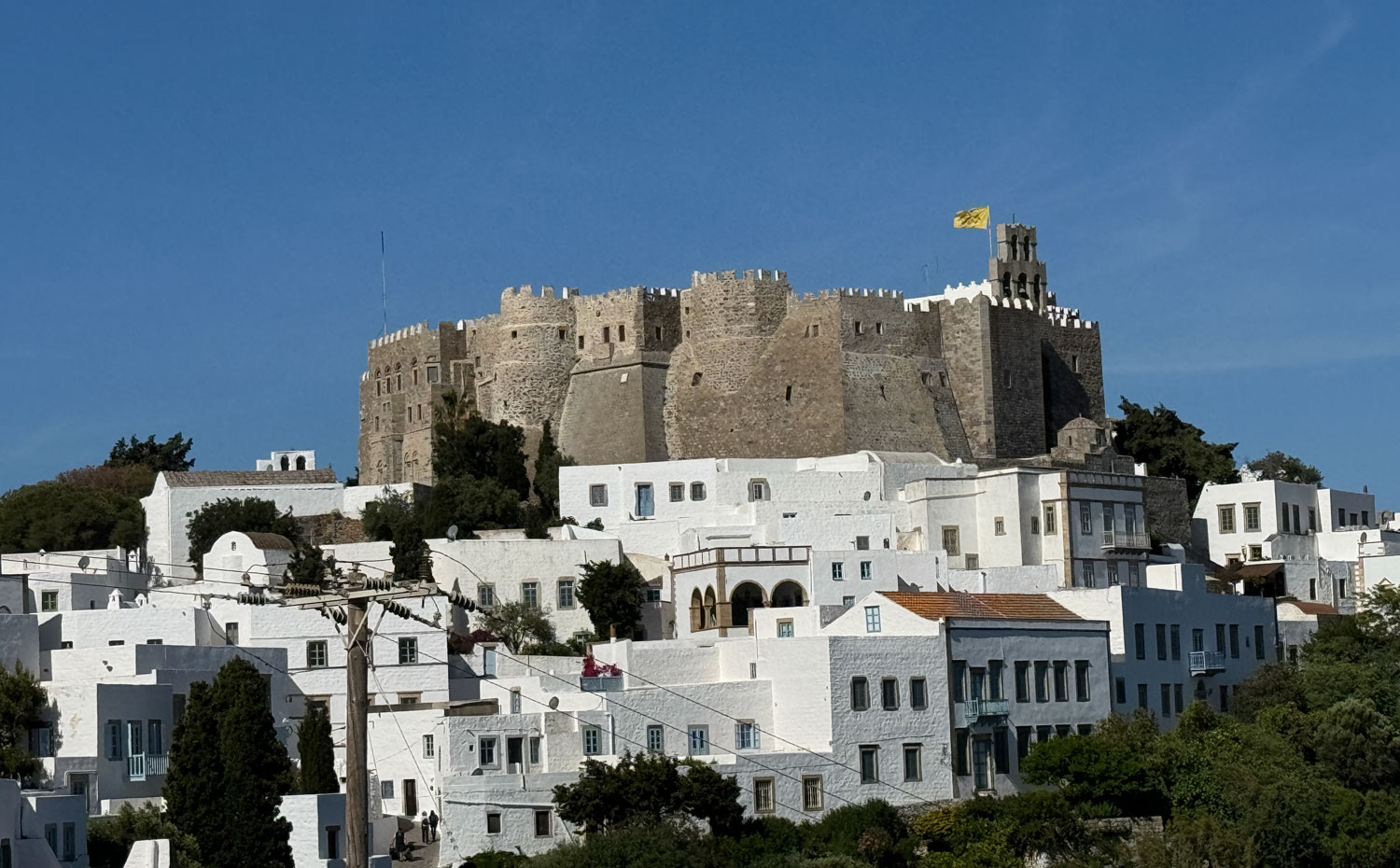
Then we walked into the city around the monastery. The streets were very narrow and the pattern was complex. Antonis said they were laid out that way, as a labyrinth, to make it difficult for pirate raiders to find their way in the city. Without him guiding us, I'm sure we would have been quite lost.
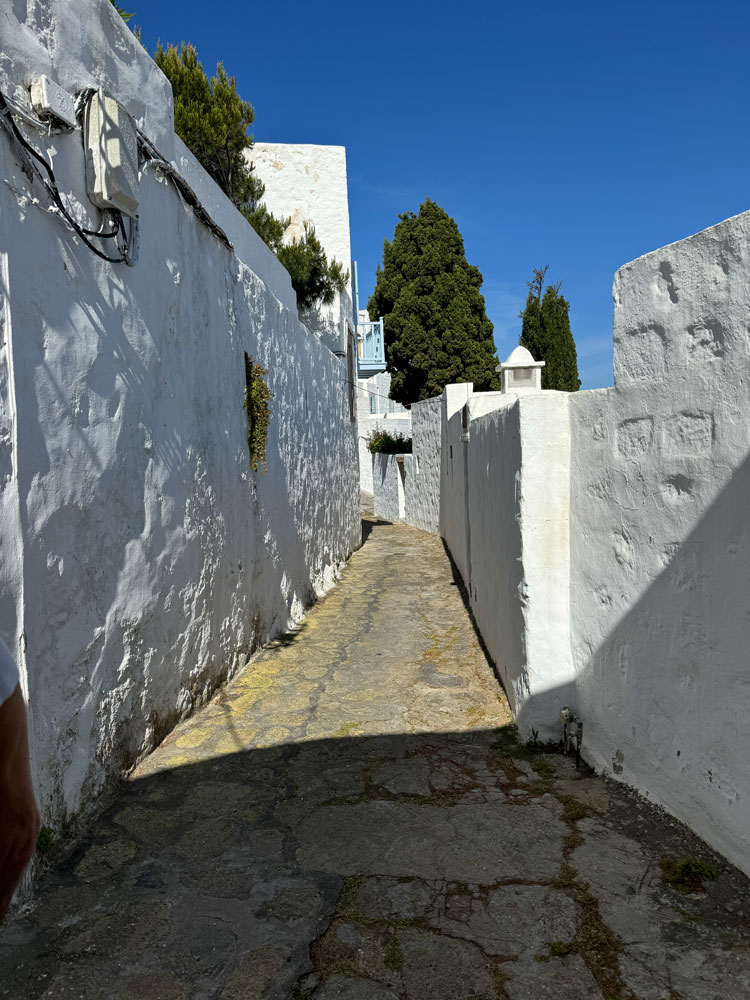
We came to a small square that was strewn with lavender. There were some men and boys holding various icons from the local church. It was a part of the Easter week celebration.
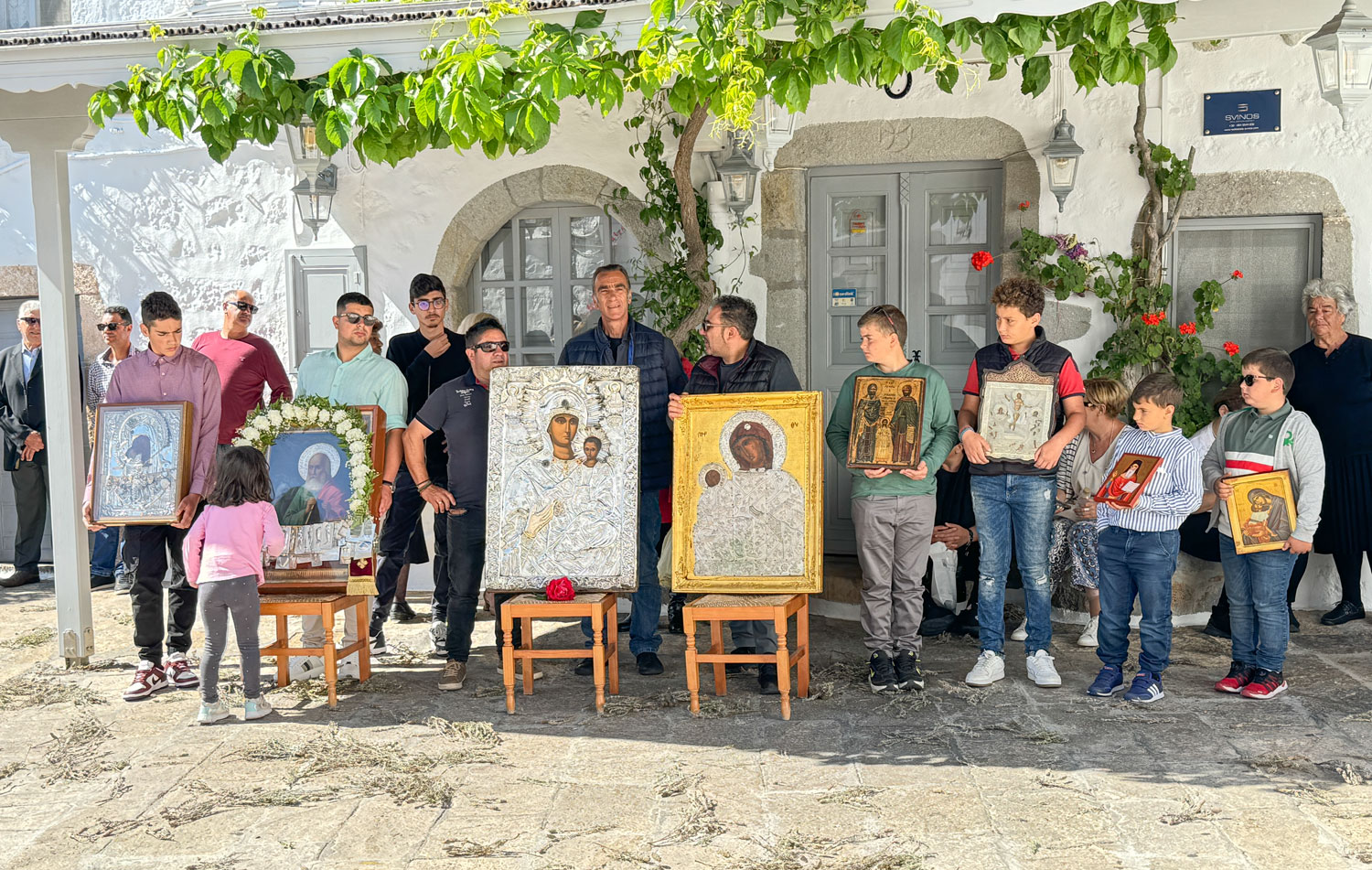
We went to a small church close by.
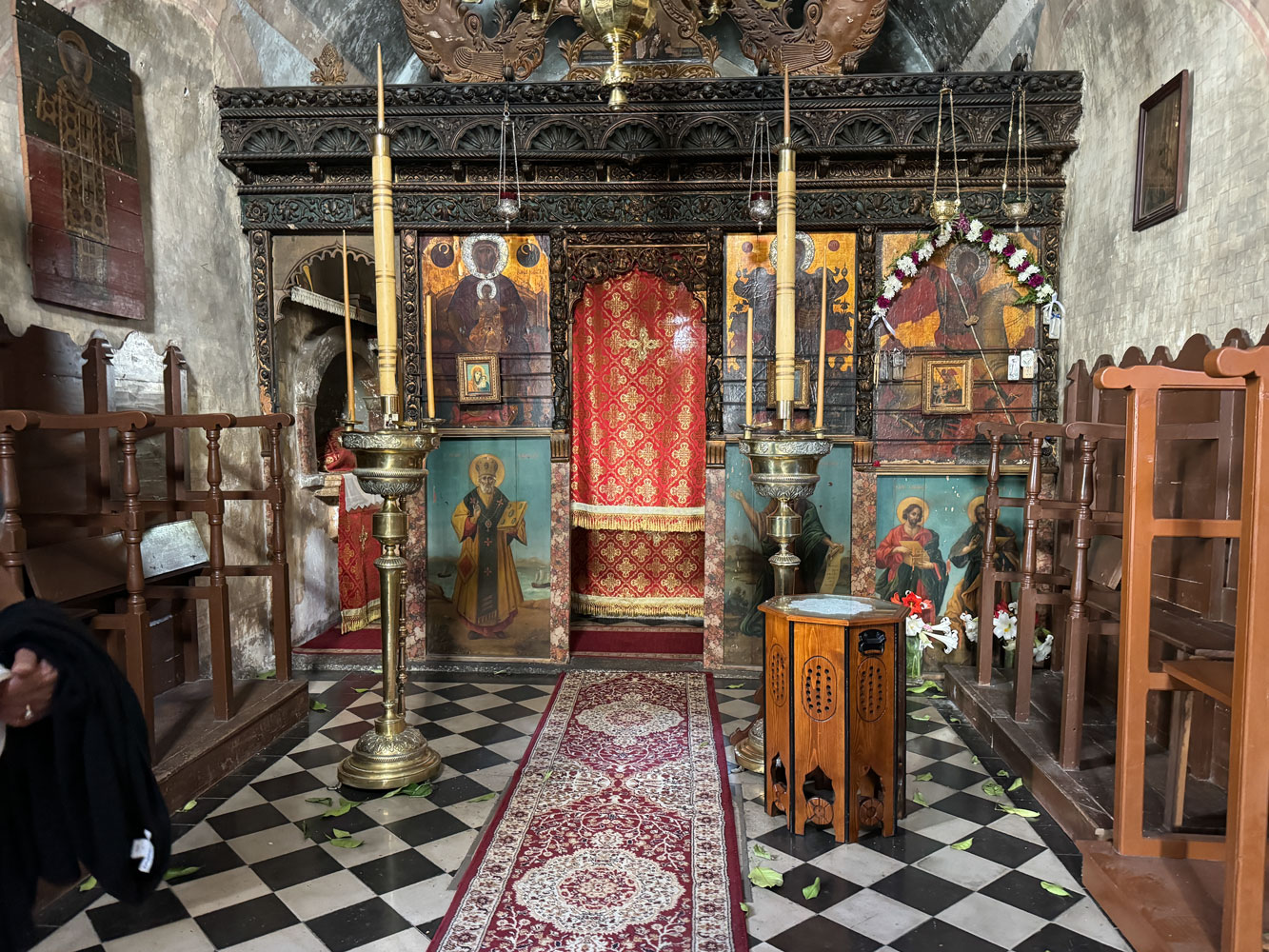
While we were there, they started ringing the bell of the small church, and we went out to the street. The people we saw in the square were parading along that street carrying the icons.
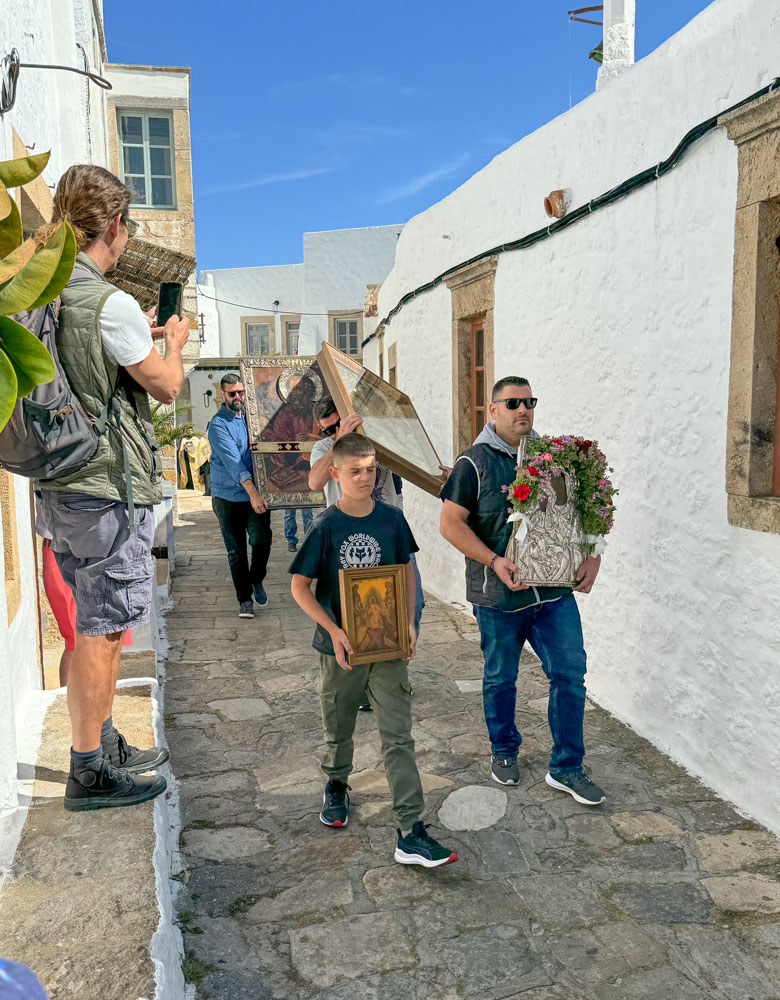
Then came the Greek Orthodox priests.
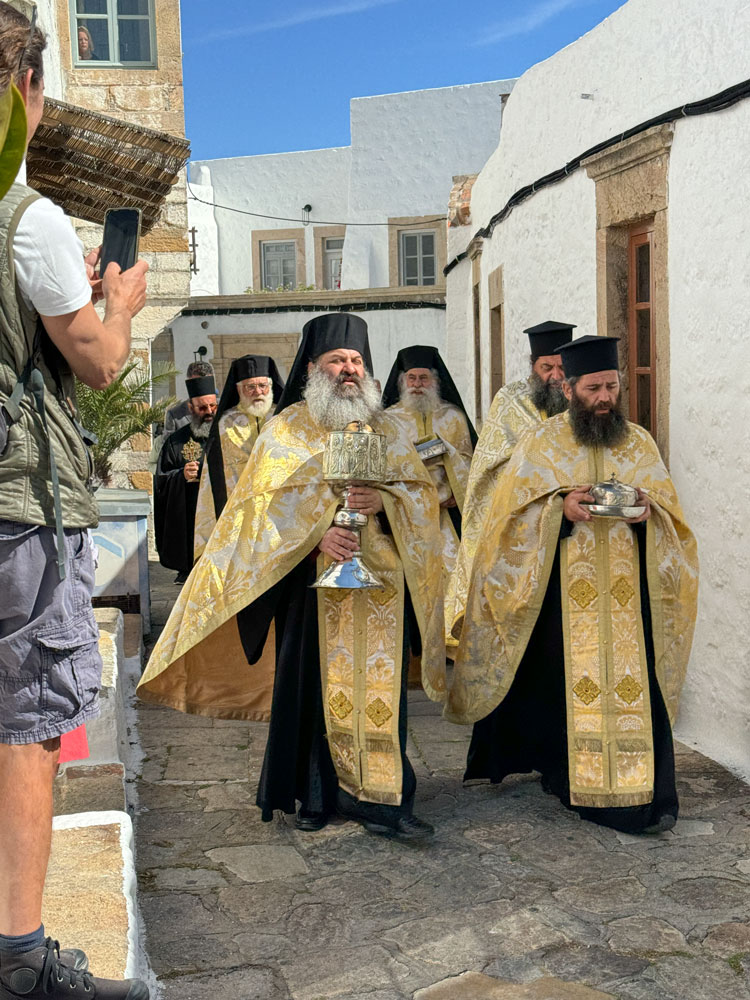
After the priest came a number local people. It was interesting to witness.
Then they took us to a restaurant at a local boatyard and Antonis treated us to a beverage. Most people had a local beer.
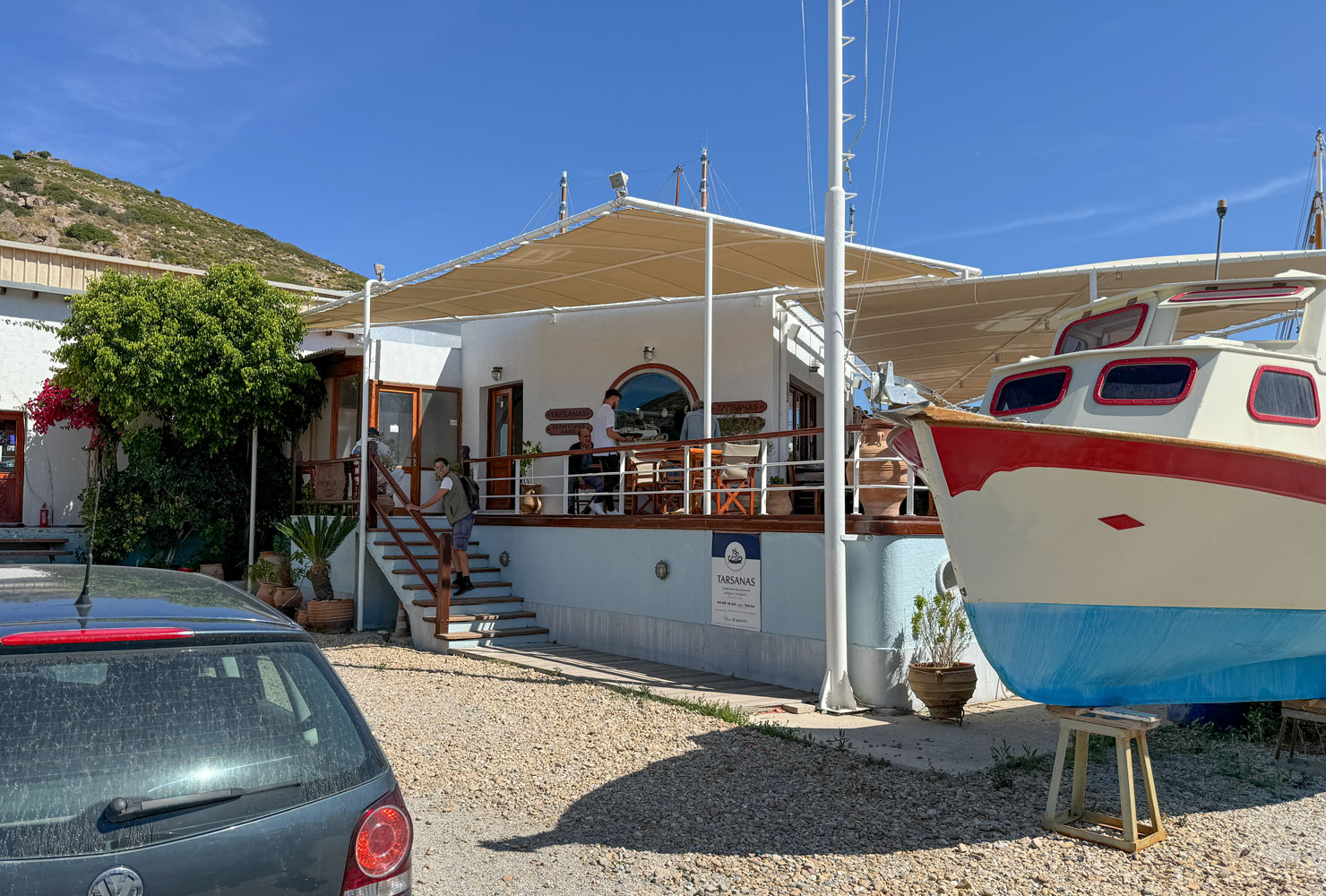
Antonis pulled out a book he had produced about Patmos, and we felt obligated to buy a copy.
When we left the boatyard restaurant, we went to the cave where John is believed to have lived while writing the Book of Revelation.
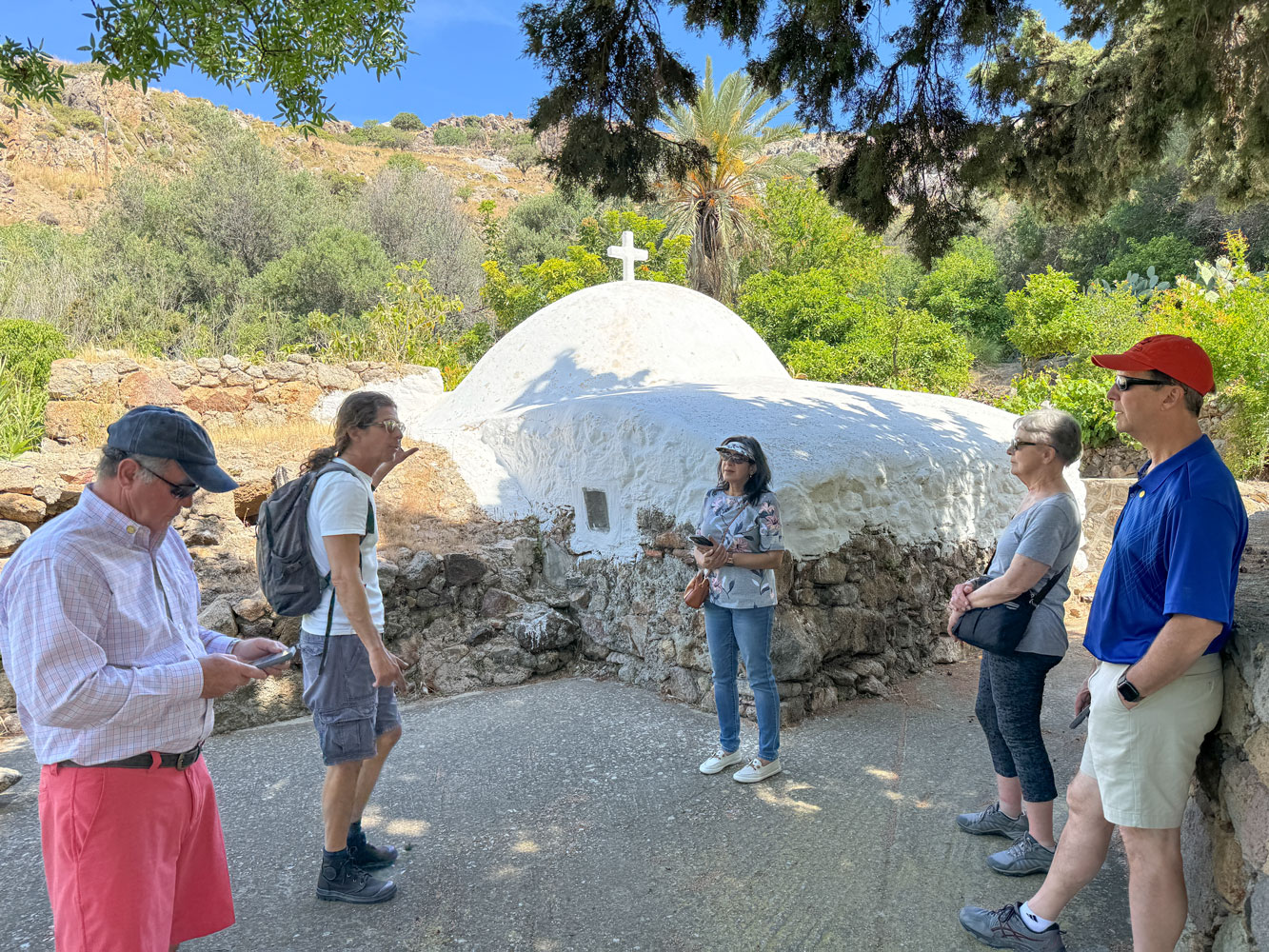
The white dome in the above picture is part of a small church, and we took a look inside.
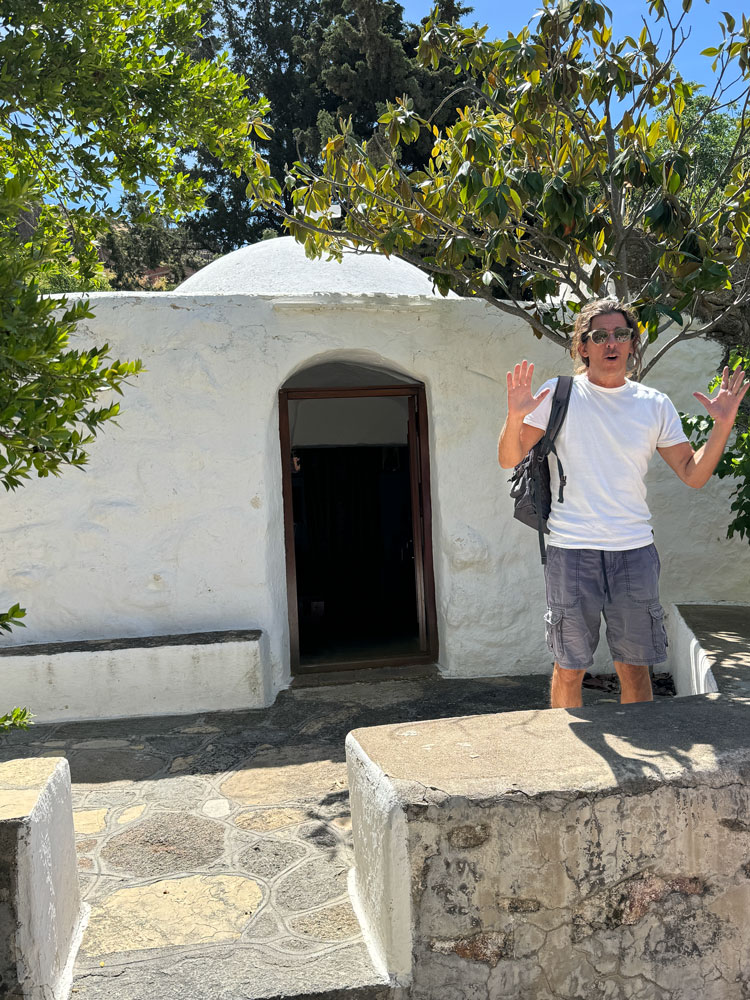
I lit a candle in memory of my loyal companion, Skipper, who passed away last year.
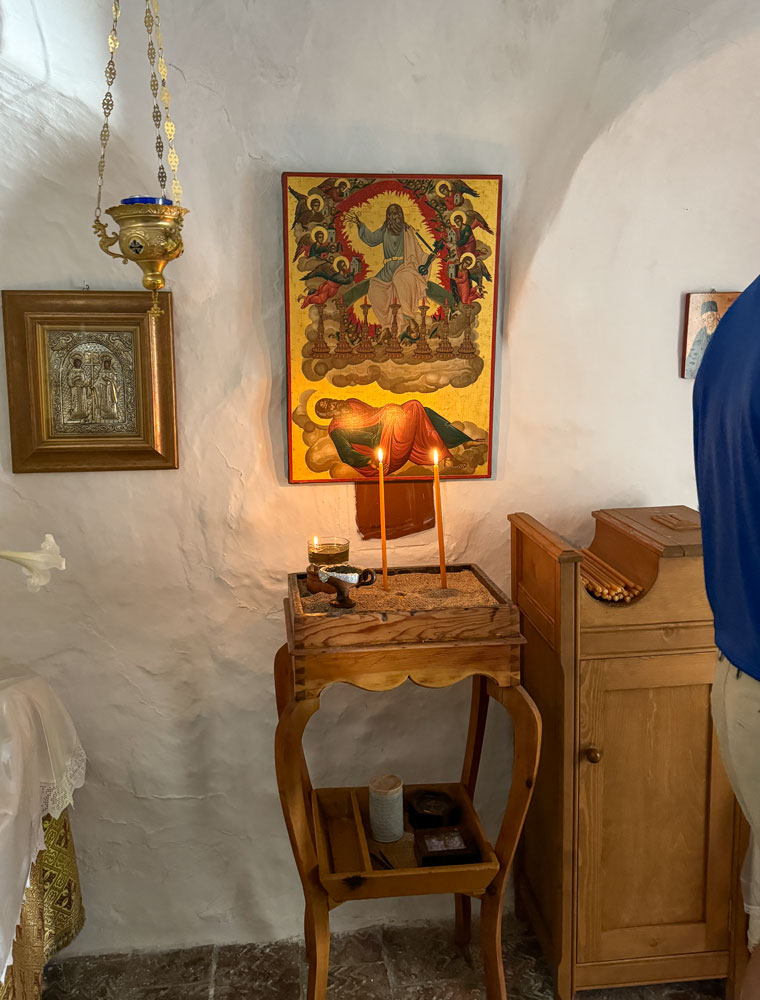
We left the cave and drove to the Petra beach where the Rock of Kalikatsou is located. I couldn't find any history of the rock on the web but Antonis said that some hermits believed that true life was only to be found after death, and they came here to live a very Spartan existence until they died. There is the foundation of a small church near the rock.
The rock is bigger than it appears in this picture - Charles is some distance from the rock. The cave you can see in the middle-left of the rock is quite large, maybe not big enough to stand up in, but almost.
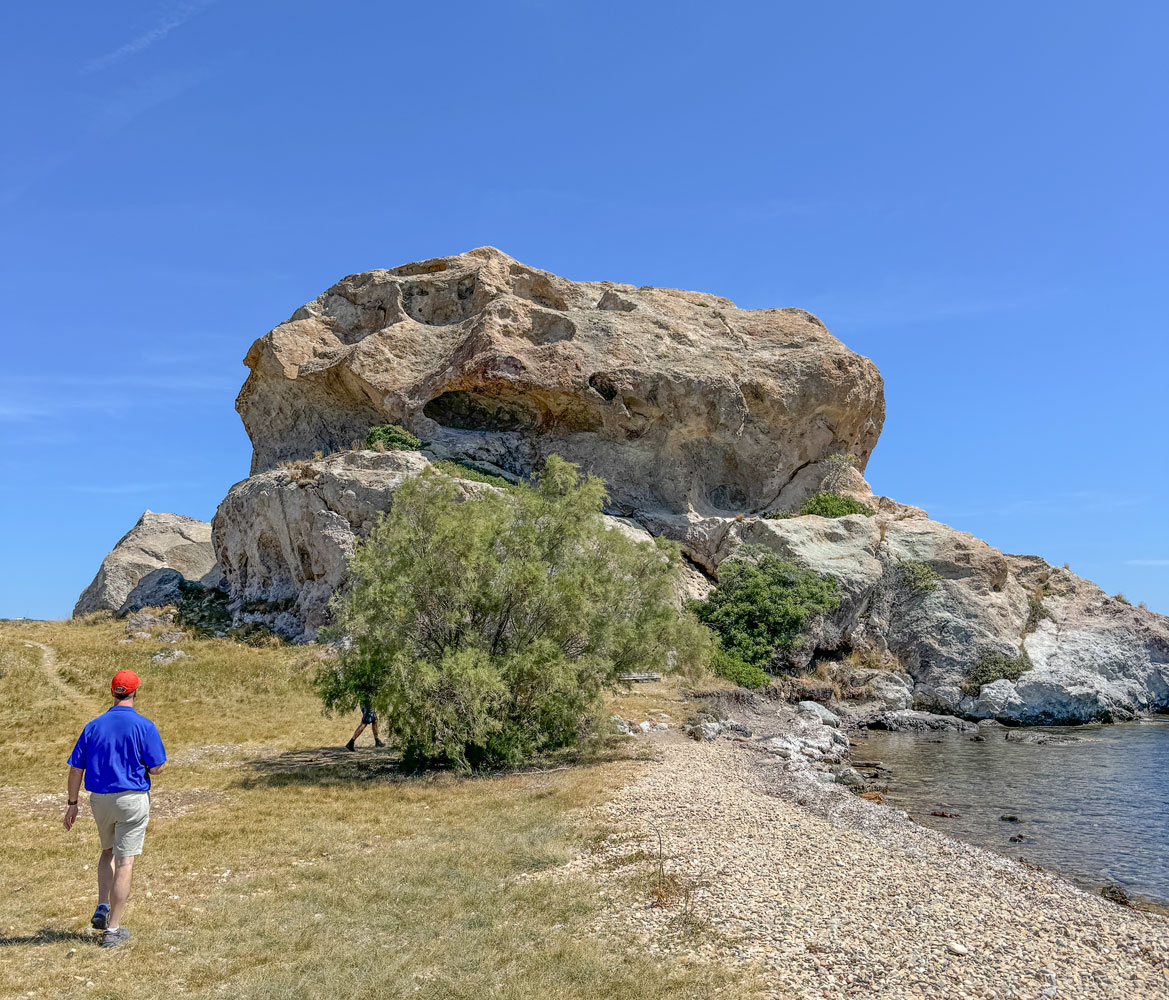
That was the end of the excursion and Antonis took us back to the harbor, where we met Michael, who took us to a bakery across the street. Michael bought each of us one item. They had a ham and cheese pie and Judy and I split that for lunch - it was plenty.
We caught the next tender back to the ship. Here's a view of the ship as we approached it in the tender. The light was good.
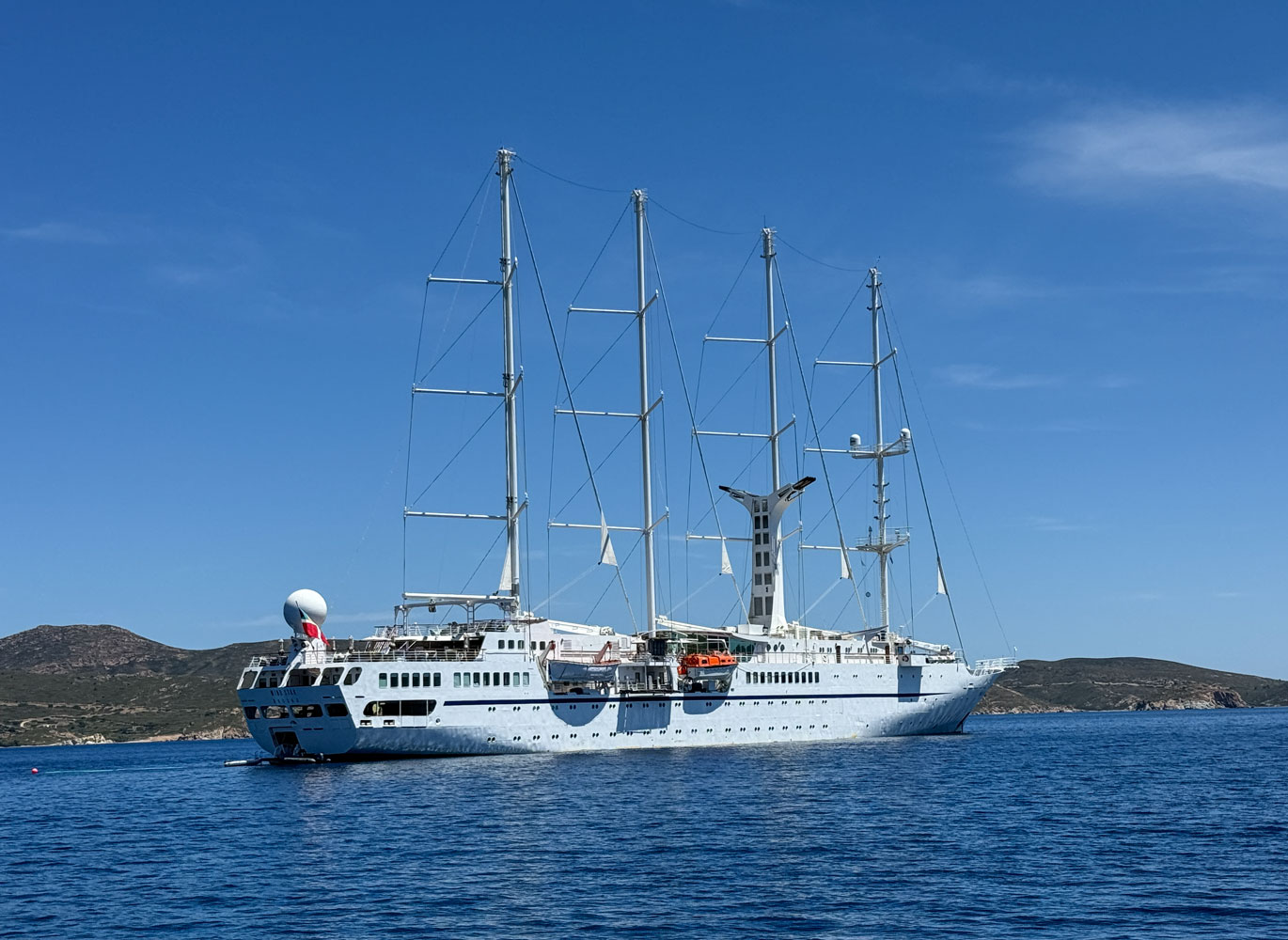
We rested after returning to the ship, had dinner, and that was another day.
+++++++++++++++++++++++++++++++++++++++++
May 8, 2024 (Wednesday) We sailed to the island of Santorini (officially Thira, sometimes called Thera) during the night. We'll arrive a bit later in the morning, so we won't tender in until about 9am. The island is the remnant of a devastating 1600 BCE volcanic eruption, called the Minoan Eruption, one of the largest in history.
The eruption left a caldera, open to the sea, and we sailed into it. The caldera is very deep, so the ship has to maintain position with the engines during our stop.
The walls of the caldera are very steep, and most of the people live at the top of the bluff. On the side facing the Aegean Sea, the land slopes very gradually to the sea so it's easy to reach the top from there - but ships do not have the same protection from storms as they do in the caldera. Due to this, there are switchback paths and roads from the ports in the caldera to the top of the island.
There's even a cable car, but it's very busy, creating a long waiting line.
Here's a picture of the switchback path shared by pedestrians and donkeys. Although it's a bit difficult to see, the cable car towers can be seen to the left of the switchback path. In this picture, the two cable car groups are ready to pass each other, one going up and the other coming down, with 6 cars in each direction. Each car carries 6 passengers.
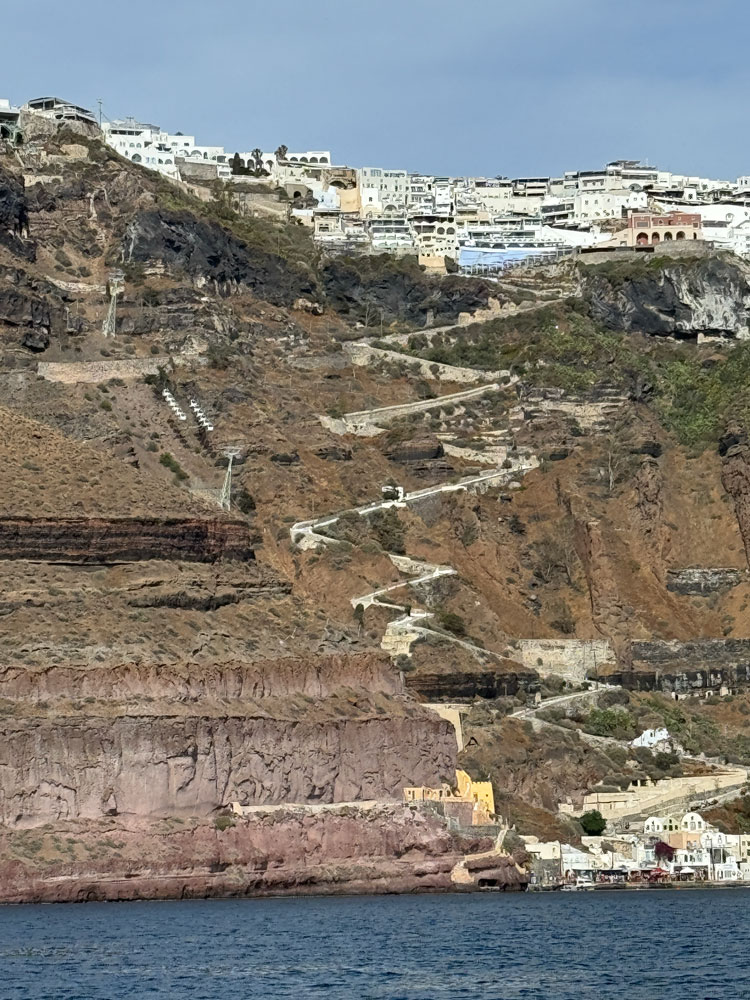
Donkeys are still used on the switchback, but now they carry tourists instead of merchandise.
There's a switchback auto and bus route in another part of the caldera. We went to the port at the foot of that auto road and took a bus to the top of the island.
The bus took us south to the ruins of the Prehistoric Town of Akrotiri. I'm afraid I don't have a lot of interest in archeological ruins but I'll post a couple of pictures.
It's quite a large area is covered by a structure to protect it from the elements. Here's a view from the outside.
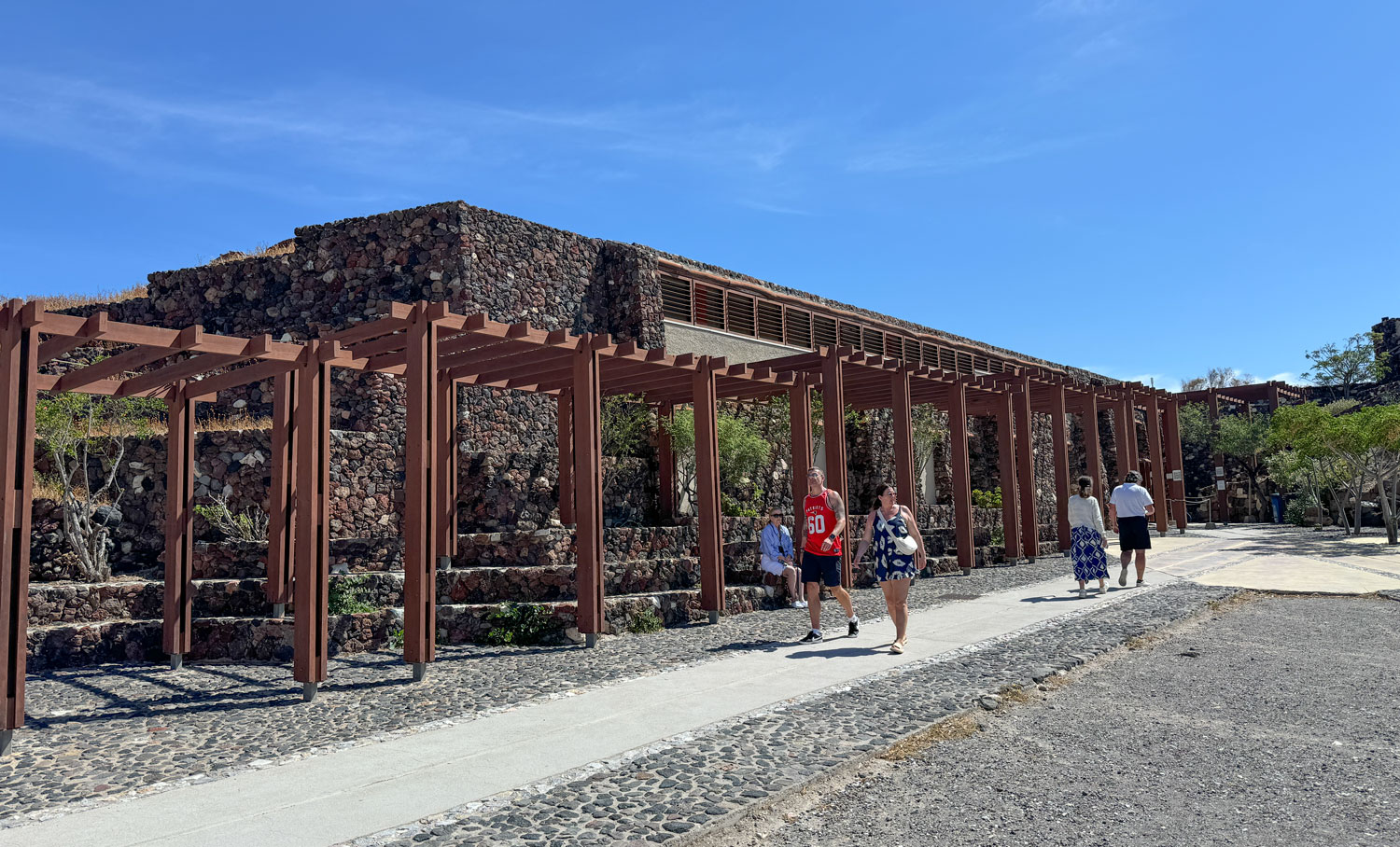
And a view of part of the inside. It's much larger than shown in this picture.

I think this was once a kitchen area.

We went to the town of Fira, the Capital of Santorini, and the Ouzeri Restaurant where we had Yellow Donkey beer, ouzo meatballs, and fried tomato balls - very good.
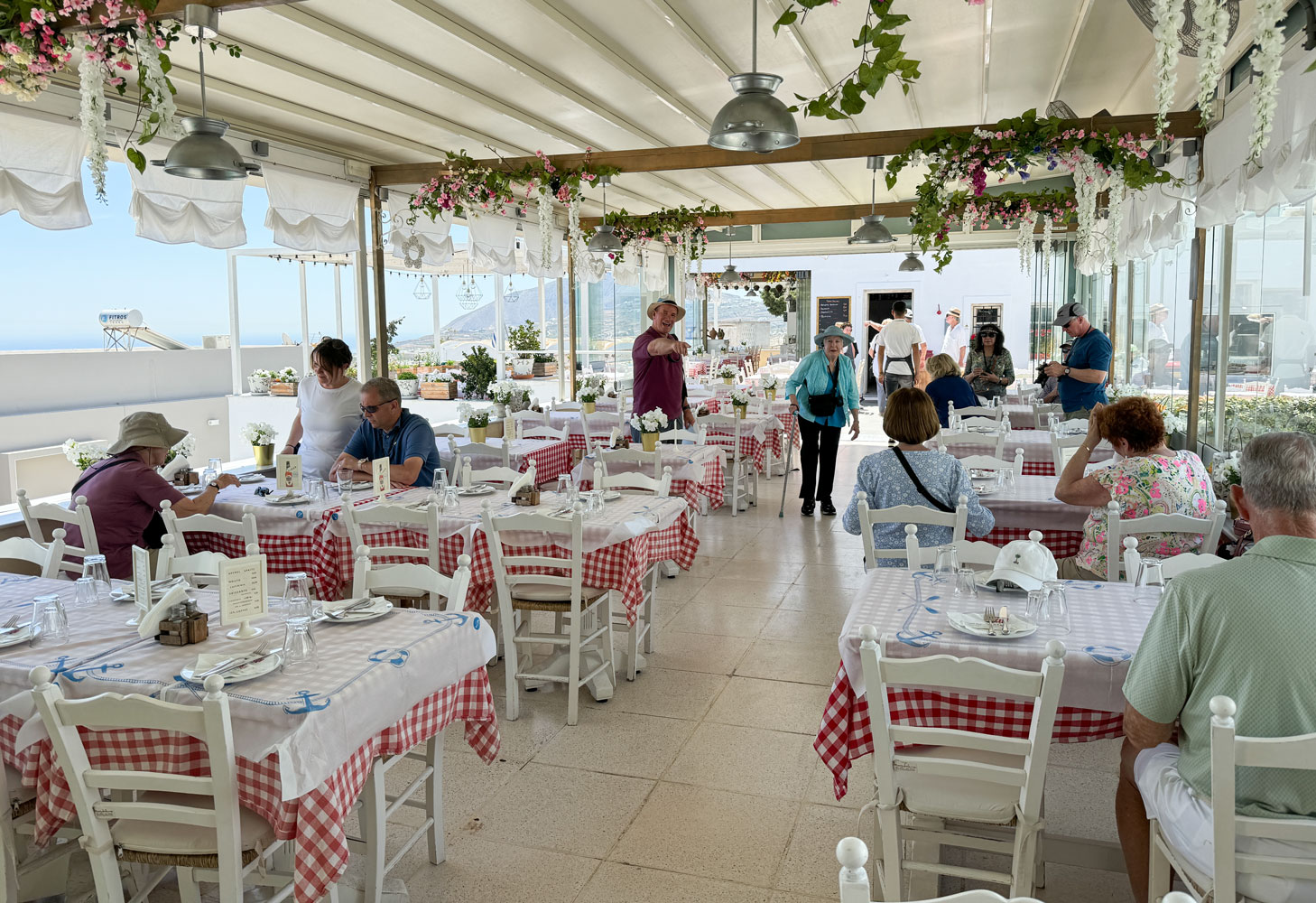
After lunch we walked along the main street looking at the shops. Judy and I had an ice-cream for dessert.
We left Fira and drove to the city of Oia (pronounced eee-ya). We had to walk up from the parking lot to the main part of the city, but everyone made it. From there we could look down on the caldera lagoon and the ships motoring there. You can see the Windstar between the two larger ships.
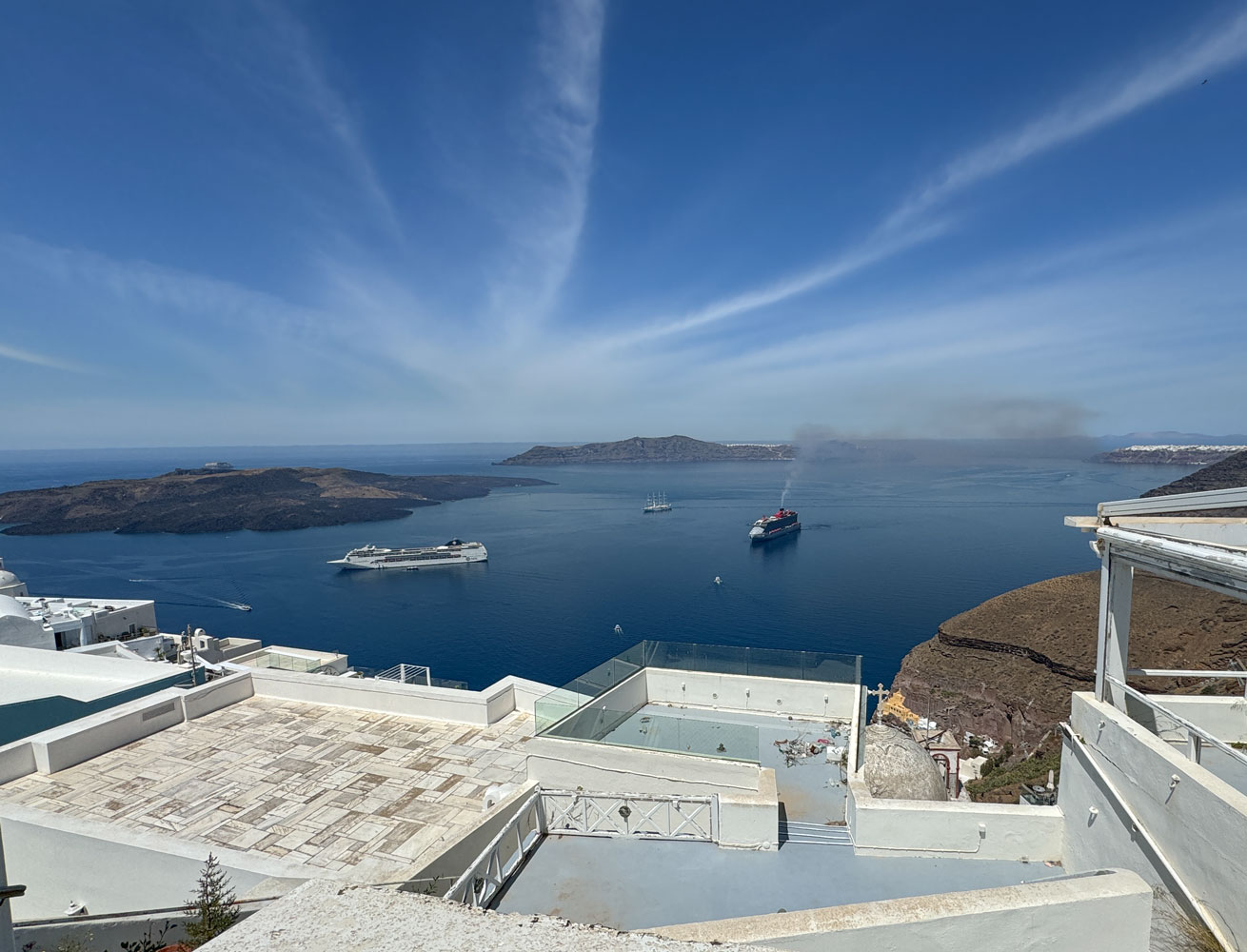
The ship on the right is putting out a lot of smoke, which I thought was impolite to the people of Santorini. Someone told me they were incinerating trash aboard ship, but they could have done it on the high seas.
We gathered in the main square, which had a church, the Church of Panagia Platsani, on one side of the square.
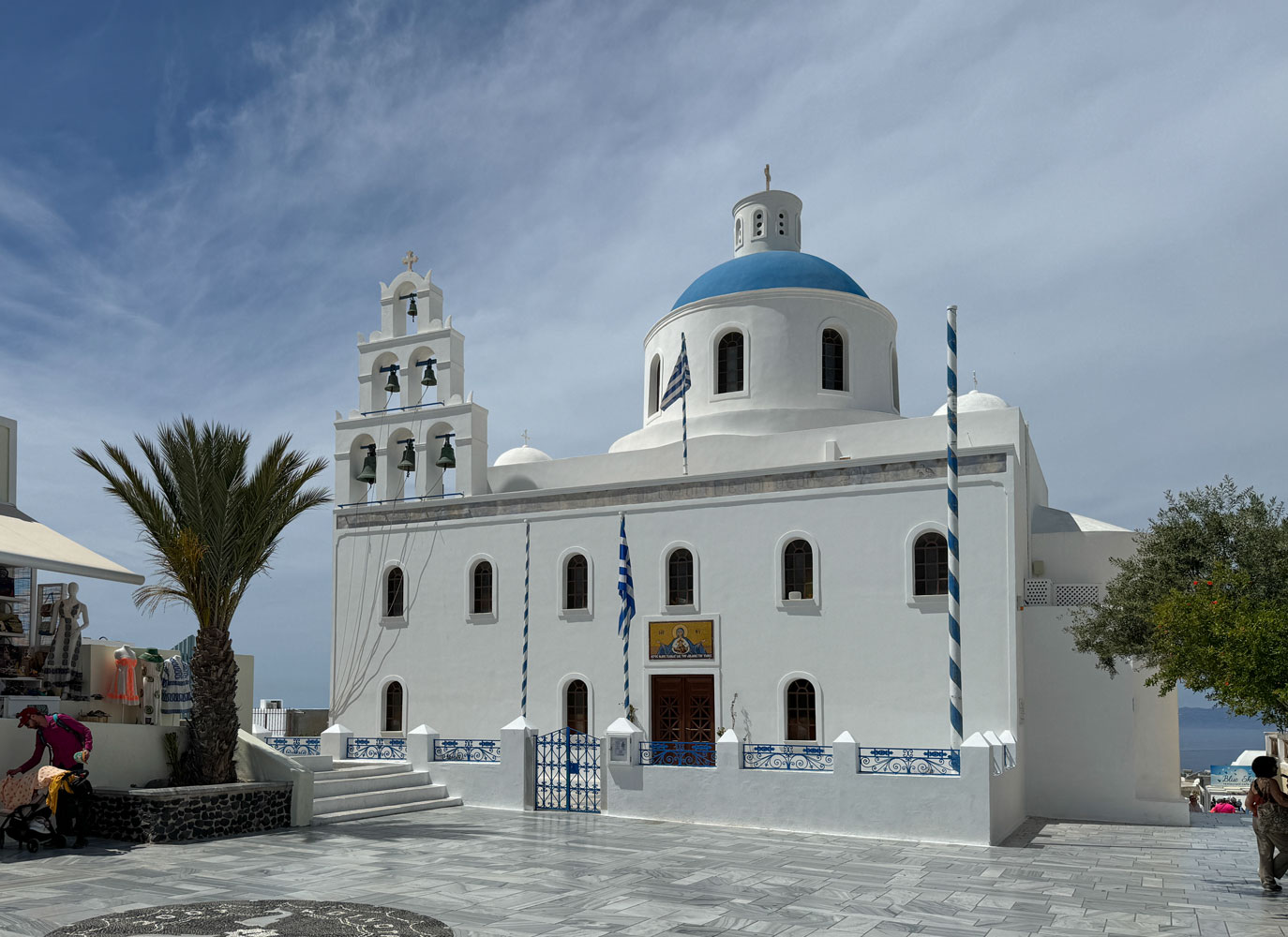
From there we walked to a place where we could see the famous blue Domed Churches of Oia. The three domes are part of two different churches: Anastasi Church, and Agios Spyridon Church.
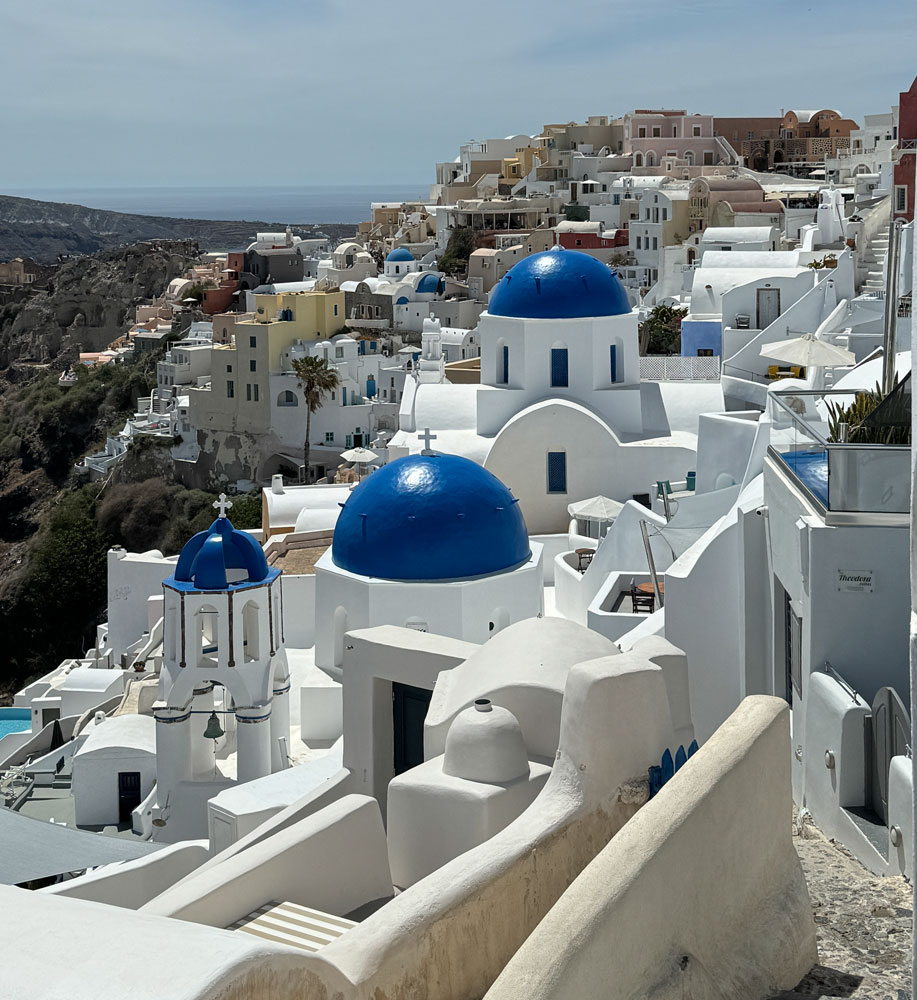
After some shopping time, we went back to the bus and returned to the port, where we caught the tender back to the ship. The ship was still in the caldera and won't leave until nearly midnight.
This evening, the crew is preparing a barbecue on the back deck. We went there about 7pm, and it was already jumping. Here are some pictures of what they prepared.
The had a carving station for a nice piece of beef, plus pork, shrimp, chicken and a few other things.

The salad area had many choices. They made good coleslaw and potato salad.
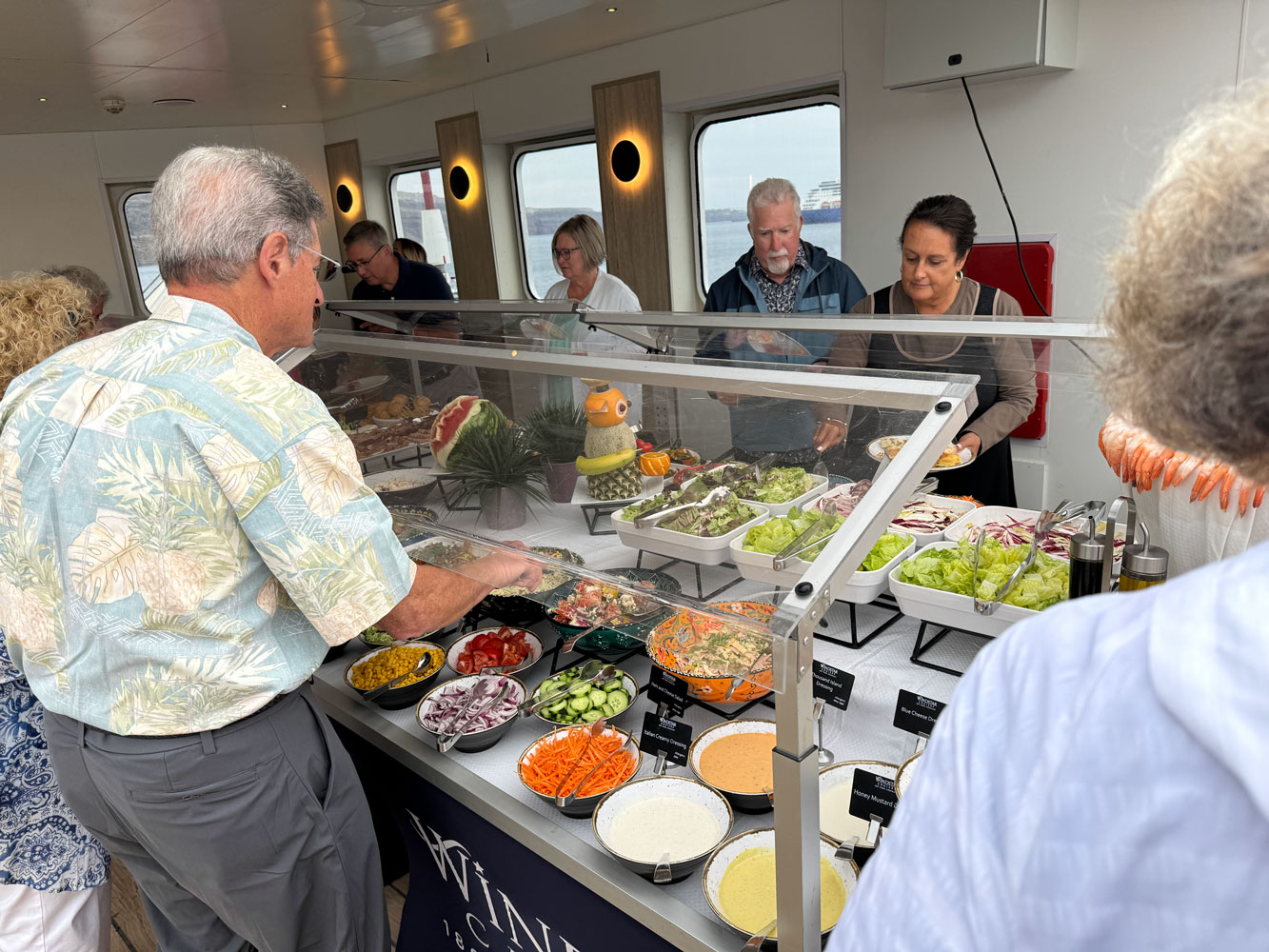
There was also a dessert table with a wide selection, including a chocolate brownie type treat, which I really liked. But I didn't take a picture of it - I think I was photographed out by then.
Here are some of our group on the back deck (Charles Hood Pix).
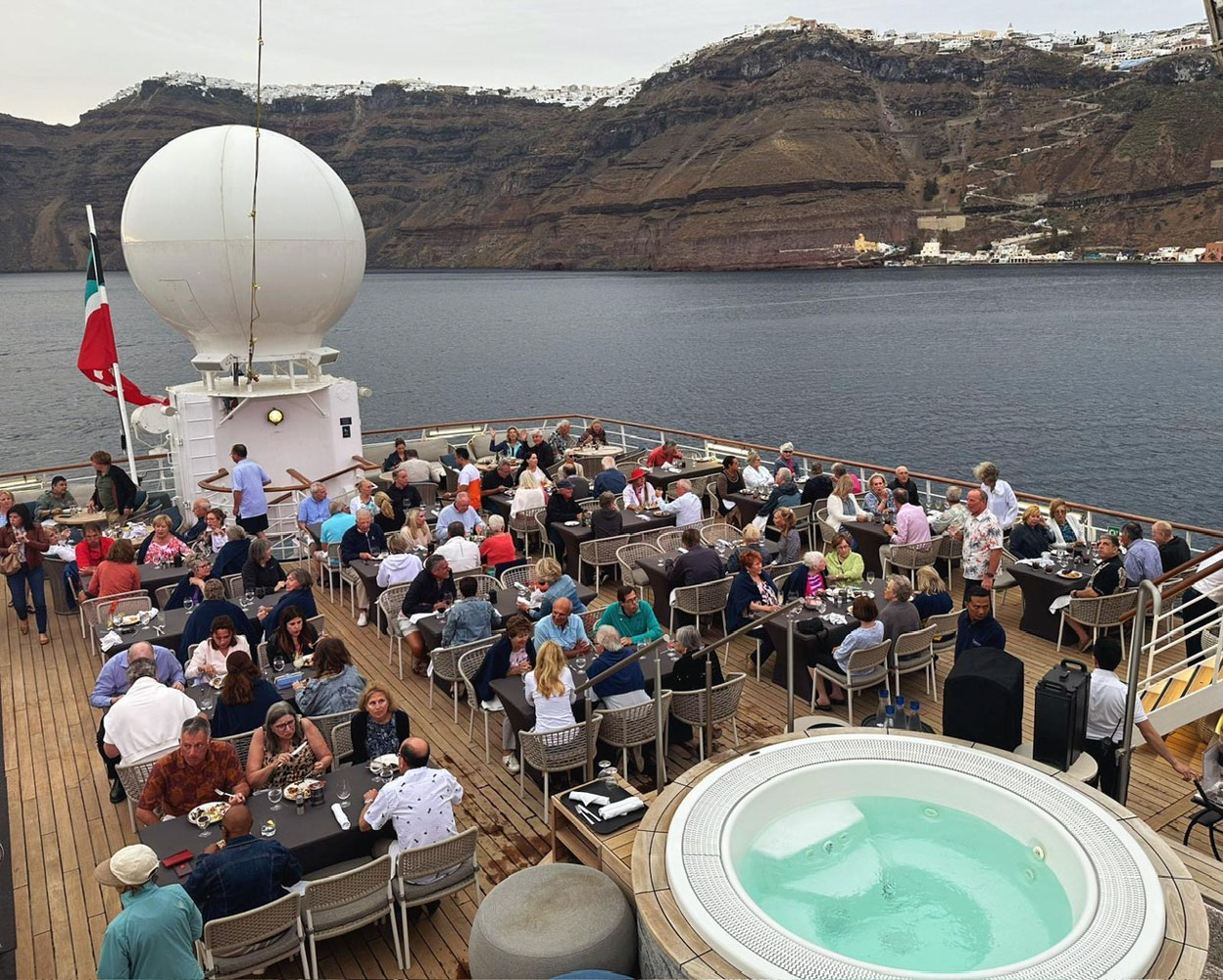
We watched the sun set, and then headed to bed.

Tomorrow we arrive at the main part of Greece, the Peloponnese. The Peloponnese is connected to the rest of Greece by the narrow isthmus of Corinth, which has been cut by the Corinth Canal. I don't think we're going to see the Corinth Canal on this tour.